Namibia is a land of spectacular landscapes, endless skies, barren deserts, rugged mountain ranges and breathtaking wildlife - participants of this self-drive safari experience something of all this.
On this trip you first drive south to the great sand dunes of Sossusvlei and the beautiful Namib desert. The road north then takes you along the fringe of the desert and eventually to the coastal town of Swakopmund. Your next stop are the rock engravings of Twyfelfontein and the volcanic rock landscape of Damaraland where desert adapted elephants roam. You then head west to Skeleton Coast National Park via Springbok Gate to Möwe Bay and from there to Shipwreck Lodge, the only lodge within Skeleton Coast NP. After exciting days at the ocean, the journey continues as a 4 x 4 trail through the Hoarusib Valley to Leilands Drift and from there to the Hoanib area, where you will spend more exciting days exploring this wild and untamed corner of Namibia. After a lazy wake-up it is a few hours to Palmwag Loge where you will be picked up for your transfer to Etendeka Mountain Camp, where interesting walks await you. A five hour drive you reach Etosha National Park. You have plenty of time to visit the many waterholes and experience a variety of animals up close during the next few days. On your way back to Windhoek, Zannier Omaanda is the perfect retreat to fully enjoy your last days in the wild before returning home.
This self-drive journey starts in Windhoek, where you pick up your vehicle. We definitely recommend a first night in Windhoek, which gives you enough time to buy some snacks and water for the trip. Apart from the few paved main roads, most of the roads you drive are gravel roads. Participants in this journey are stirring up a lot of dust! You visit the most beautiful areas of Namibia and experience the entire fascination of this huge country.

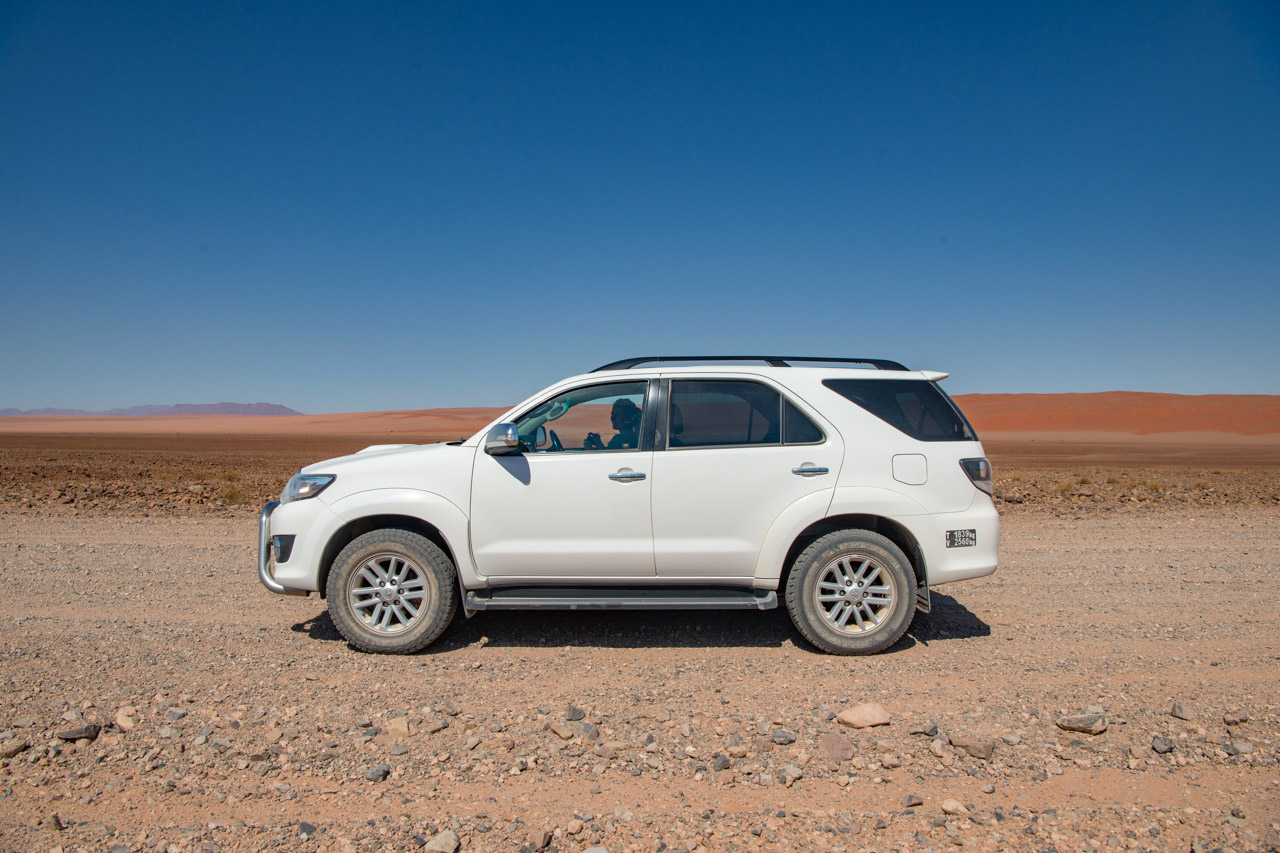


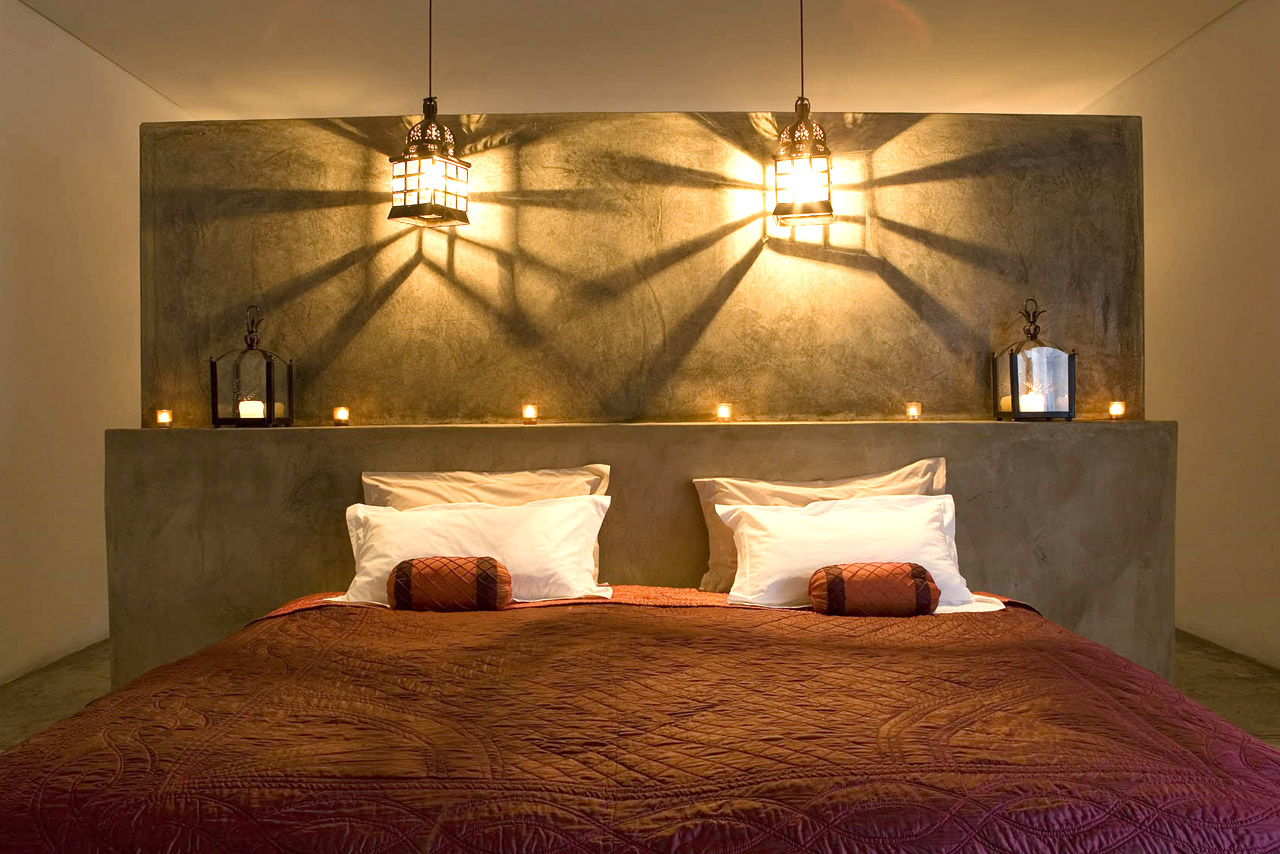
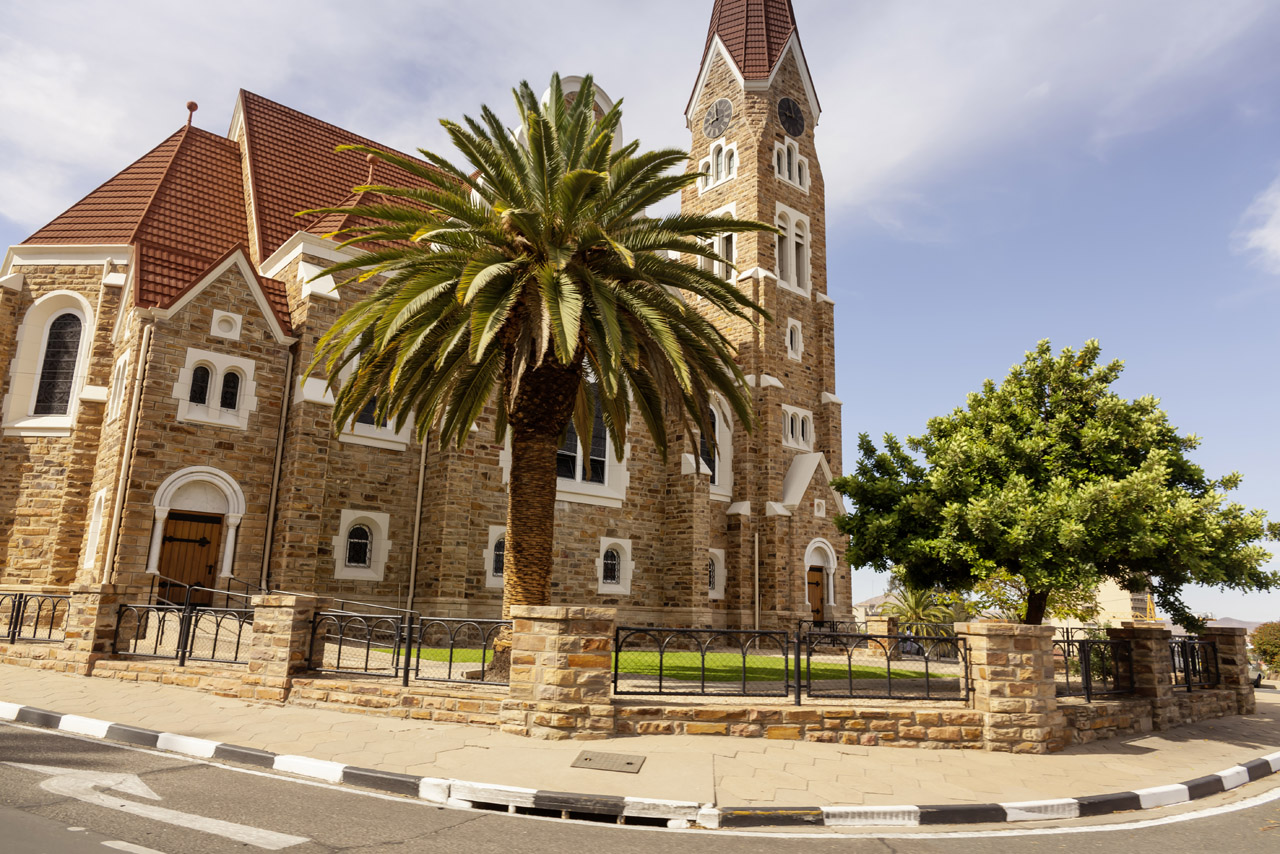
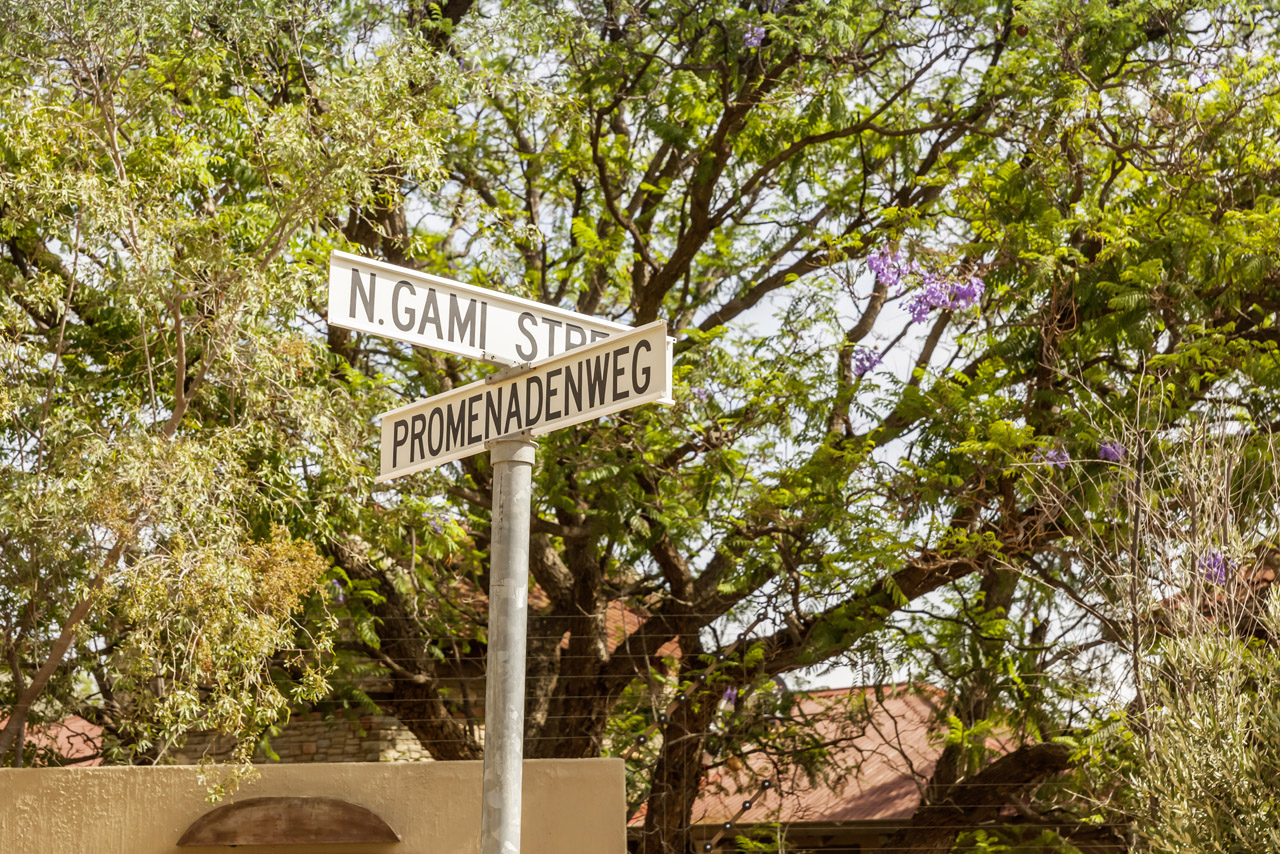
Accommodation The Olive Grove is a charming, intimate guesthouse with eleven beautifully appointed rooms, each equipped with a minibar, air conditioning/heating, safe, TV and hairdryer. Its five standard rooms are located on the lower storey; its luxury rooms with access to a terrace are on the upper storey. Those in search of the ultimate luxury experience can book the 80 m2 executive suite, which comes with its own lounge.
A breakfast buffet is included; lunch and à la carte dinner is either served in the restaurant or on the veranda. The Olive Grove takes great pride in its cuisine and is certain to delight even the most discerning of palates.
A swimming pool provides the perfect place for a cooling dip.
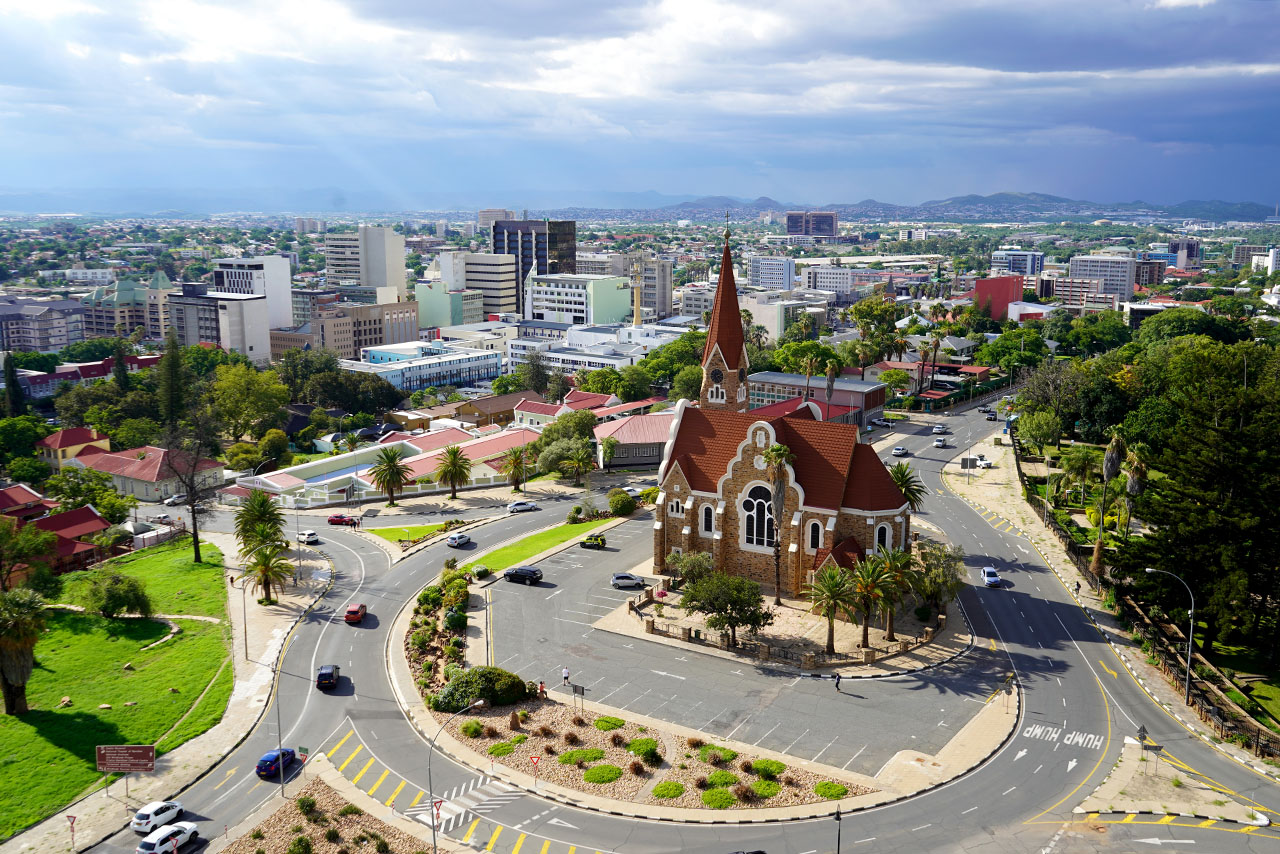
Windhoek is situated in a hilly environment, in the Khomas Highland region, about 1600 m above sea level. The international airport is approx. 1 hours’ drive east, as the city itself has no suitable place for a major airport. It is also served by a small airport (Eros), which is used by lighter aircraft.
The city doesn’t offer enough to warrant remaining for days, but it is the perfect place to spend a night at the beginning or end of a tour, and it is well worth having a look around. Windhoek’s size and straightforward layout means it’s easy for self-drivers to find their way around, and therefore the perfect place to stock up on provisions.

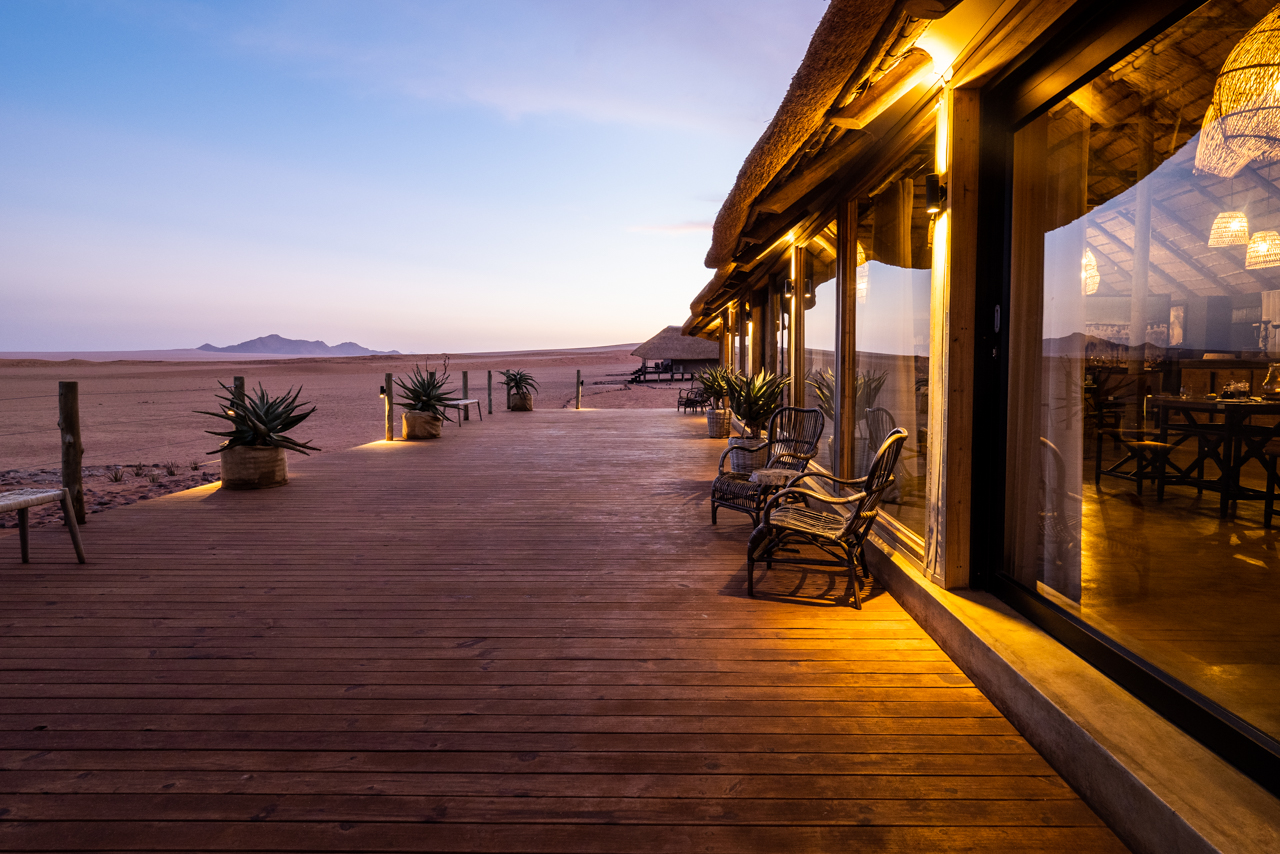
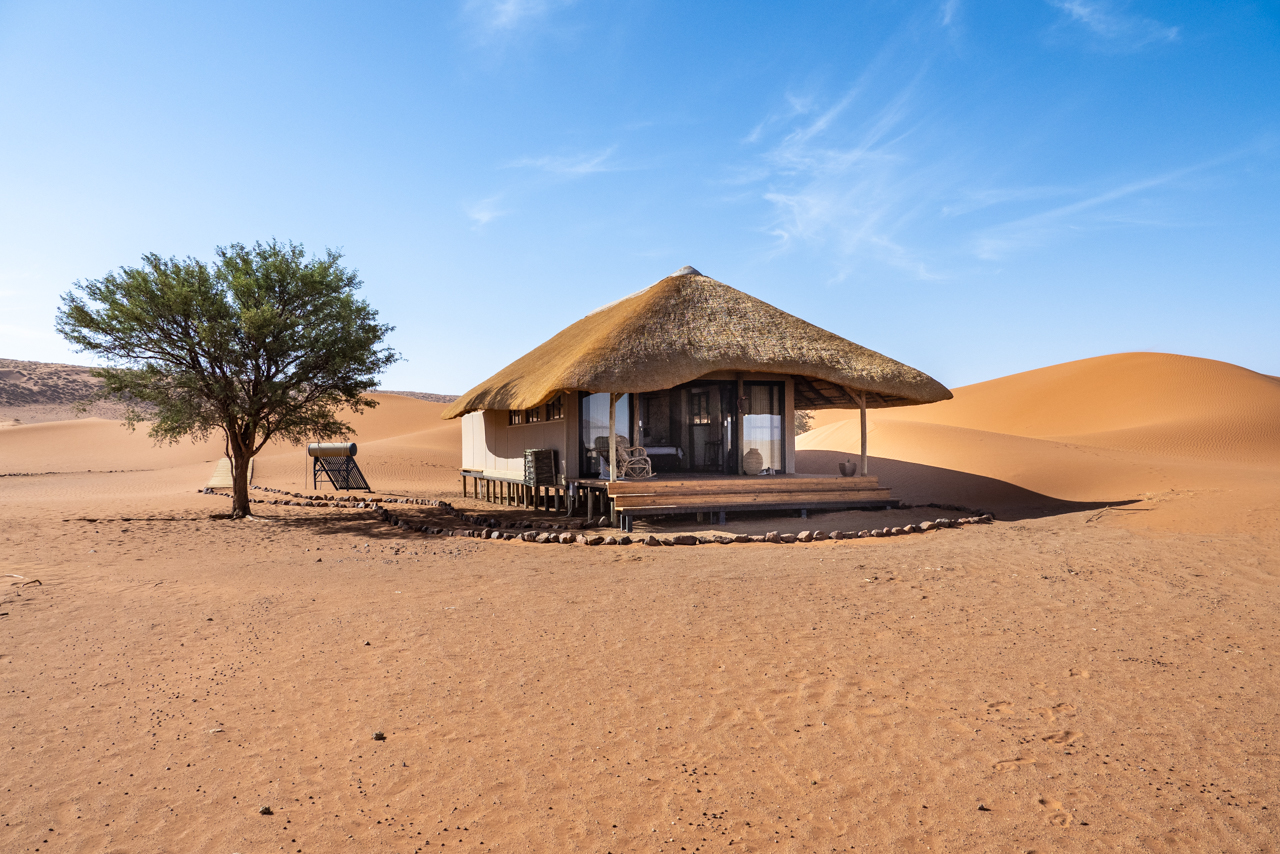
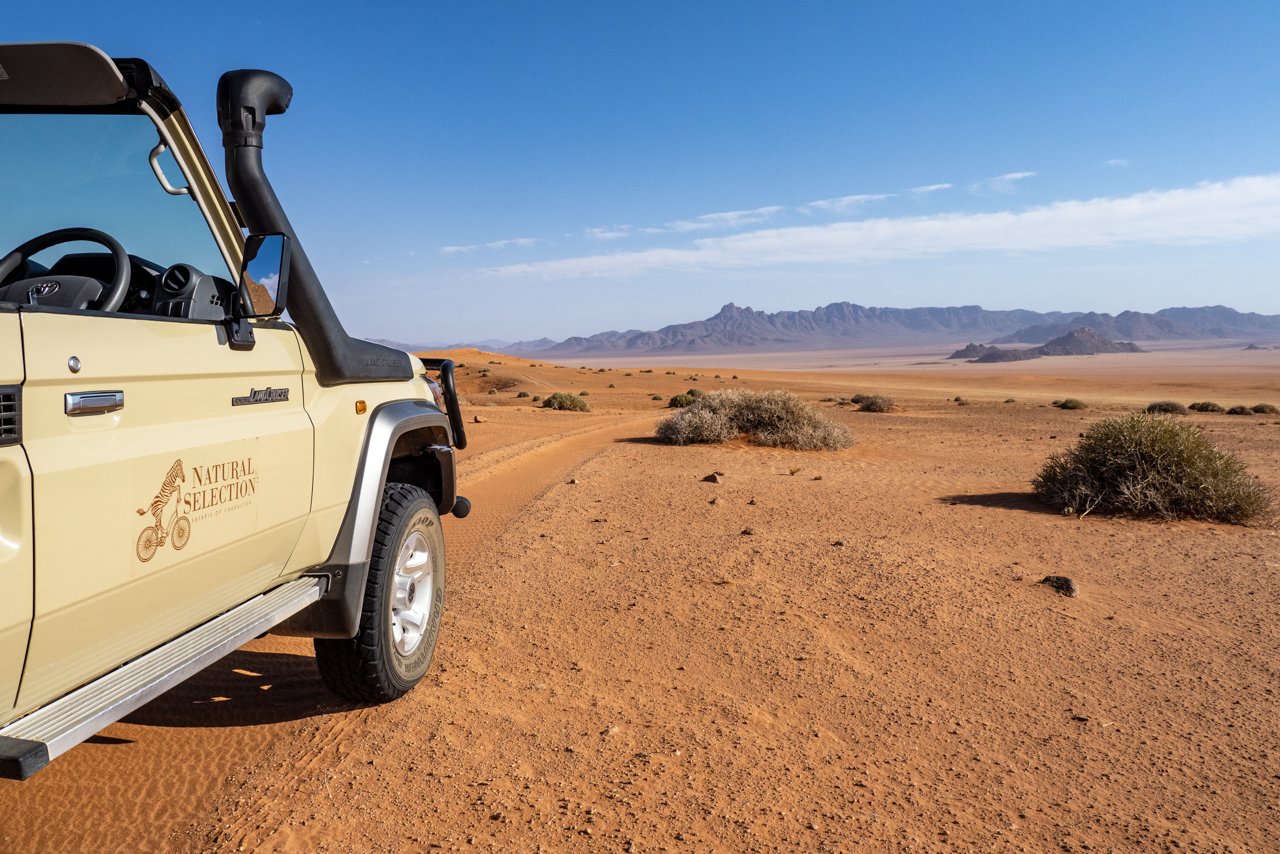
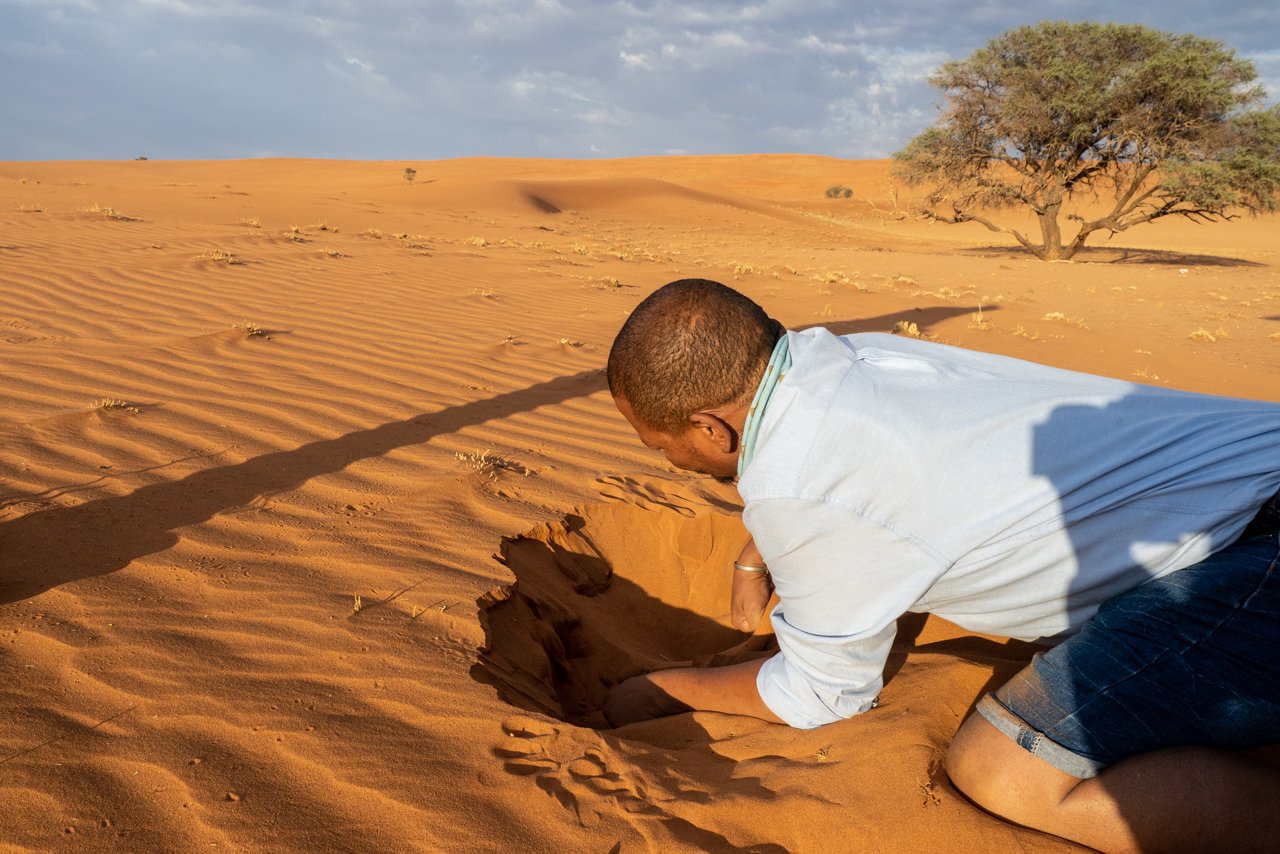
Accommodation
Kwessi Dunes is located in the NamibRand Nature Reserve, a place of immense beauty, where red sand dunes stretch endlessly against the backdrop of the Naukluft Mountains. The lodge offers twelve comfortable, air-conditioned tent chalets, each covered by a protective thatched roof. The rooms have en-suite bathrooms with indoor & outdoor showers and a veranda with seating. Two of the chalets are family rooms with two bedrooms (1 x king-size bed and 1 x two single beds) which share a common bathroom.
The chalets have been extended towards the rear with a separate stargazer bedroom, which is open to the sky and allows a stunning view of the millions of stars, especially during new moon and cloudless nights. The NamibRand Reserve is Africa's first internationally recognized Dark Sky Reserve, which means that light pollution is absolutely minimal.
The spacious main building is protected from the sun by a striking thatched roof. Beneath is the bar, a library with a large number of books to browse through, the restaurant and various seating areas that invite you to linger. There is also a swimming pool if you need to cool down from the heat of the day.
Kwessi Dunes is located south of Sossusvlei, north of the NamibRand Nature Reserve in a private concession of about 15’000 hectares. Although the dunes of Sossusvlei are within easy reach, an early wake-up call is still required (30km to the gate of the park and from there another hour drive to the vleis).
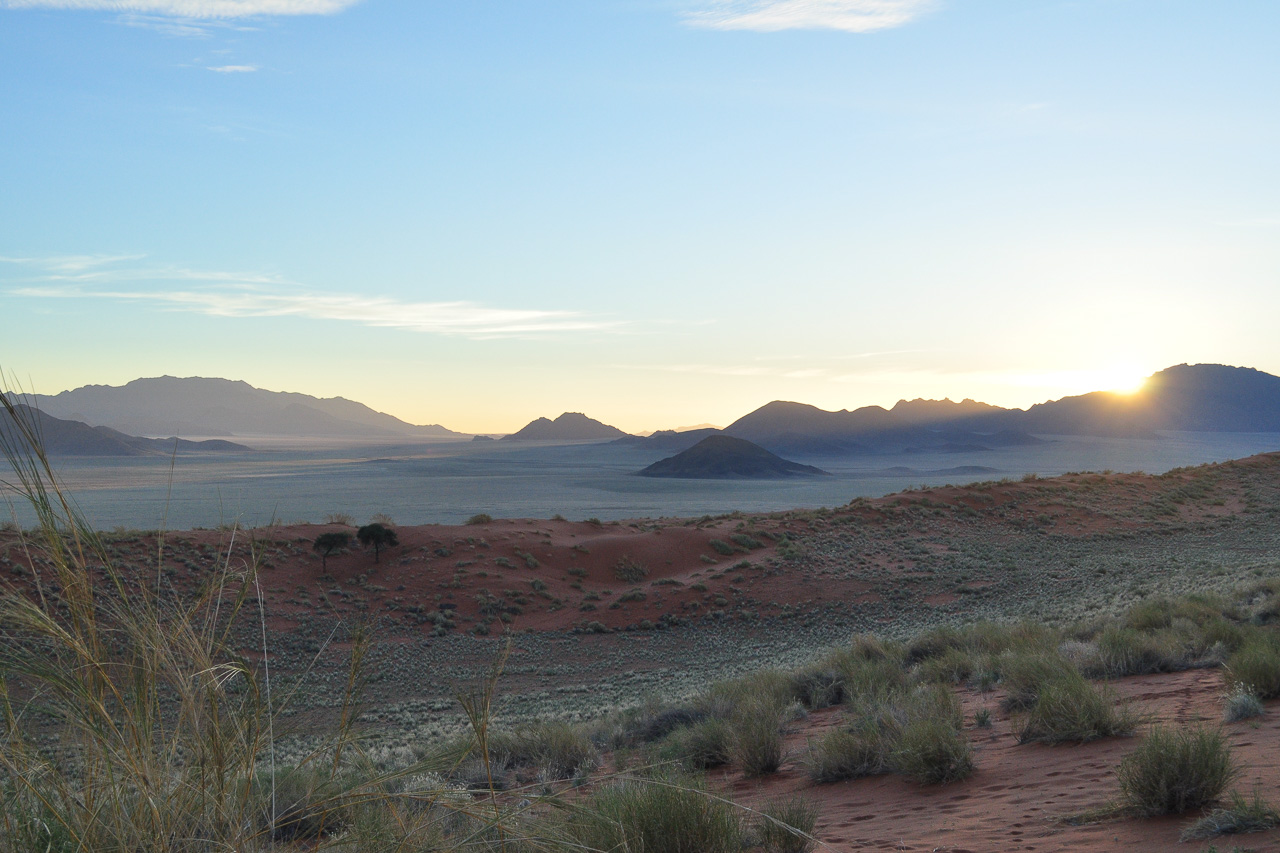
Established in 1984 by the Brückner family, the reserve currently encompasses more than 200’000 hectares of land. The NamibRand is situated some 2 hours by car south of Sesriem and abuts the Namib Naukluft Park to the west and the Nubib Mountains to the east. Its diverse landscape includes red sand dunes, vast meadows, mountains and valleys supporting several species of animal, including zebra, oryx, springbok, kudu, giraffe and cheetah.
The west of the reserve is dominated by the bush-covered dune fields of the Namib, and the east by granite cliffs and the Nubib Mountains. It is different from the Sossusvlei and its high sand dunes, so combining the two areas offers visitors a truly comprehensive insight into the Namib region.
All Namib Rand lodges offer scenic drives and the guides are more than happy to explaind the flora and fauna of the Namib to their guests. The guides will also encourage guests to leave the vehicle and explore the Namib on foot as well. As there are only few camps in the area, excursions in the NamibRand Nature Reserve are always very private and exclusive.
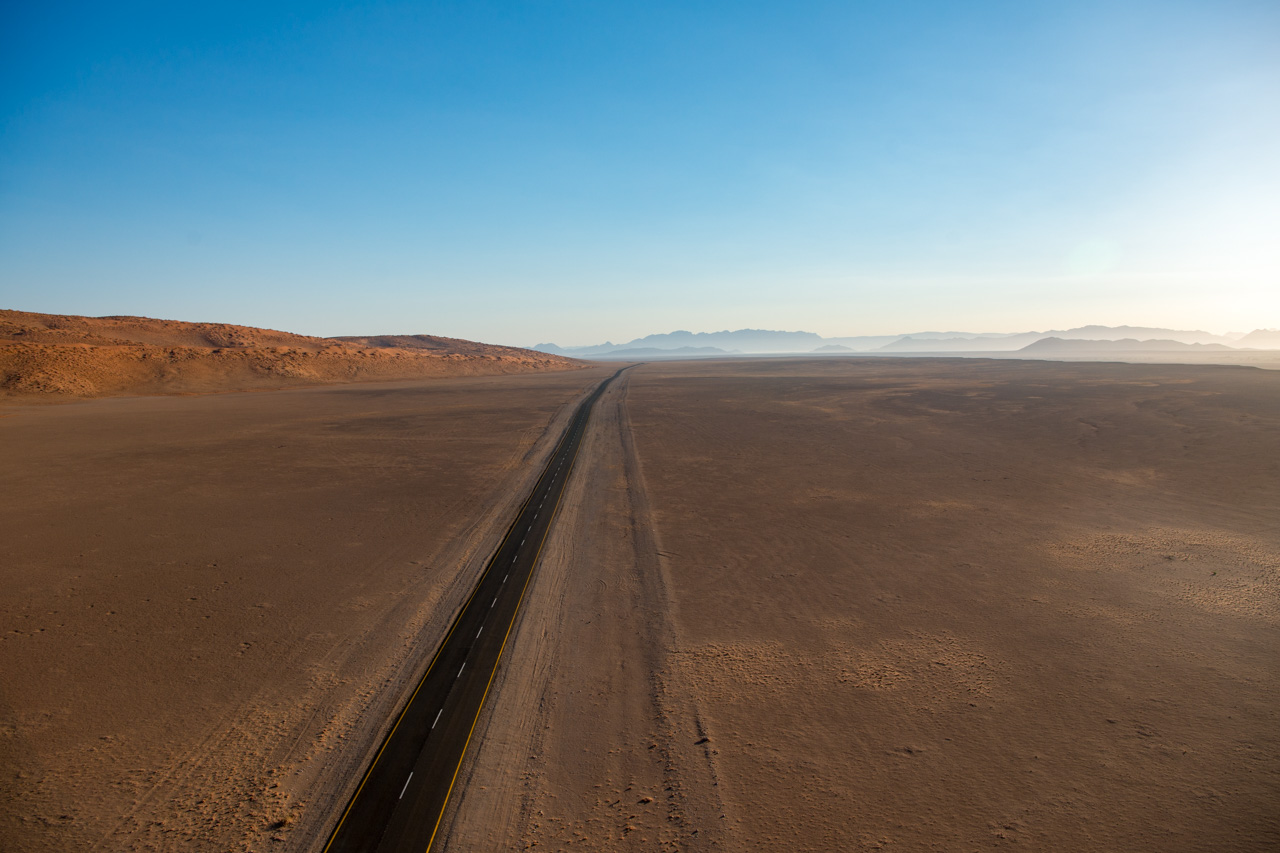
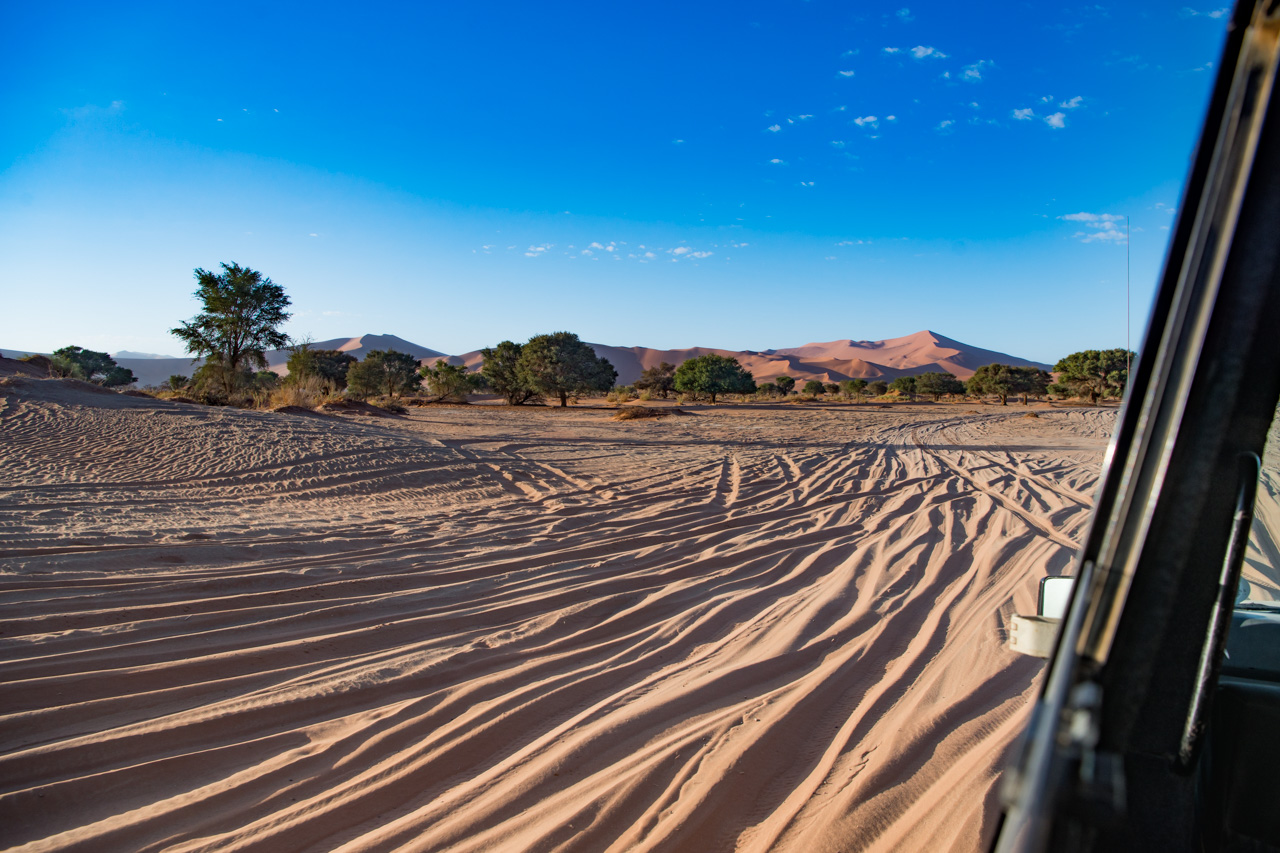
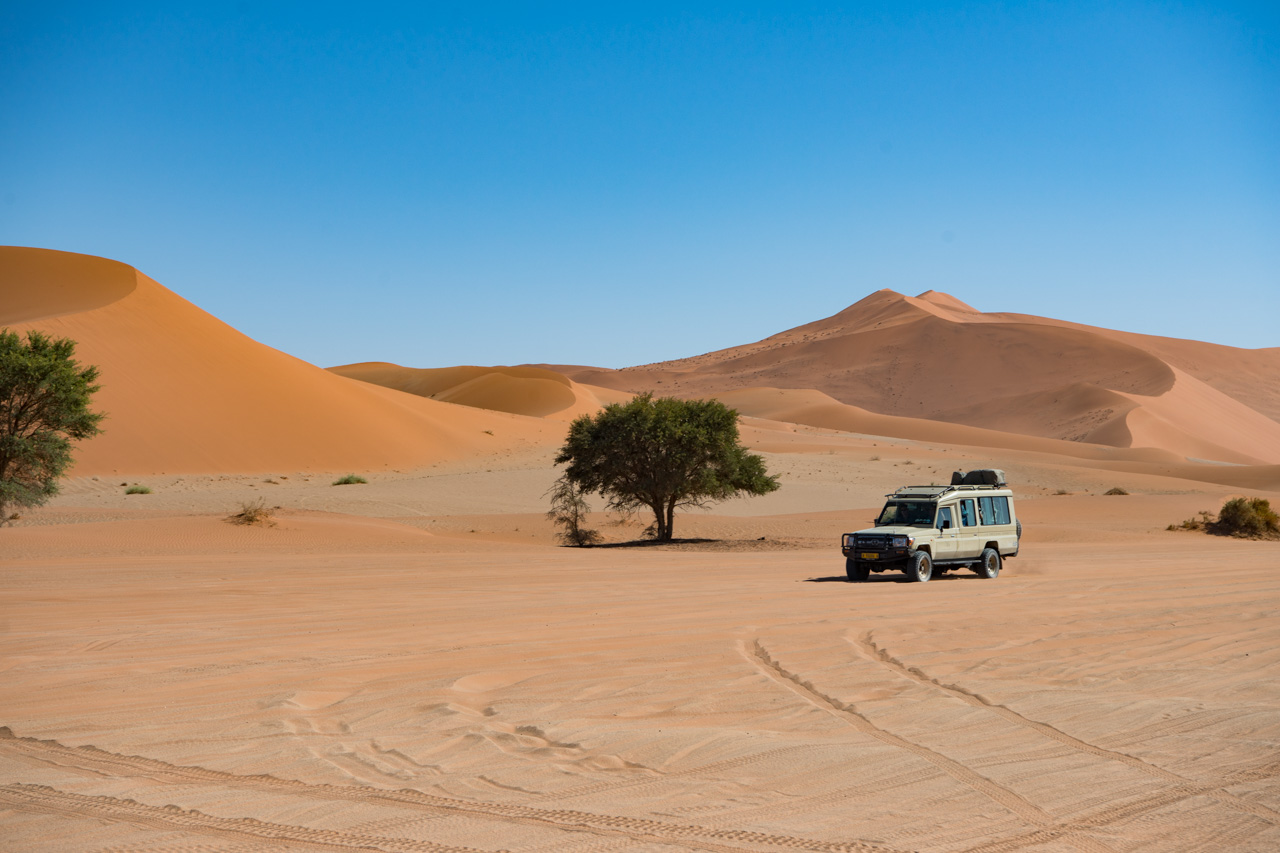

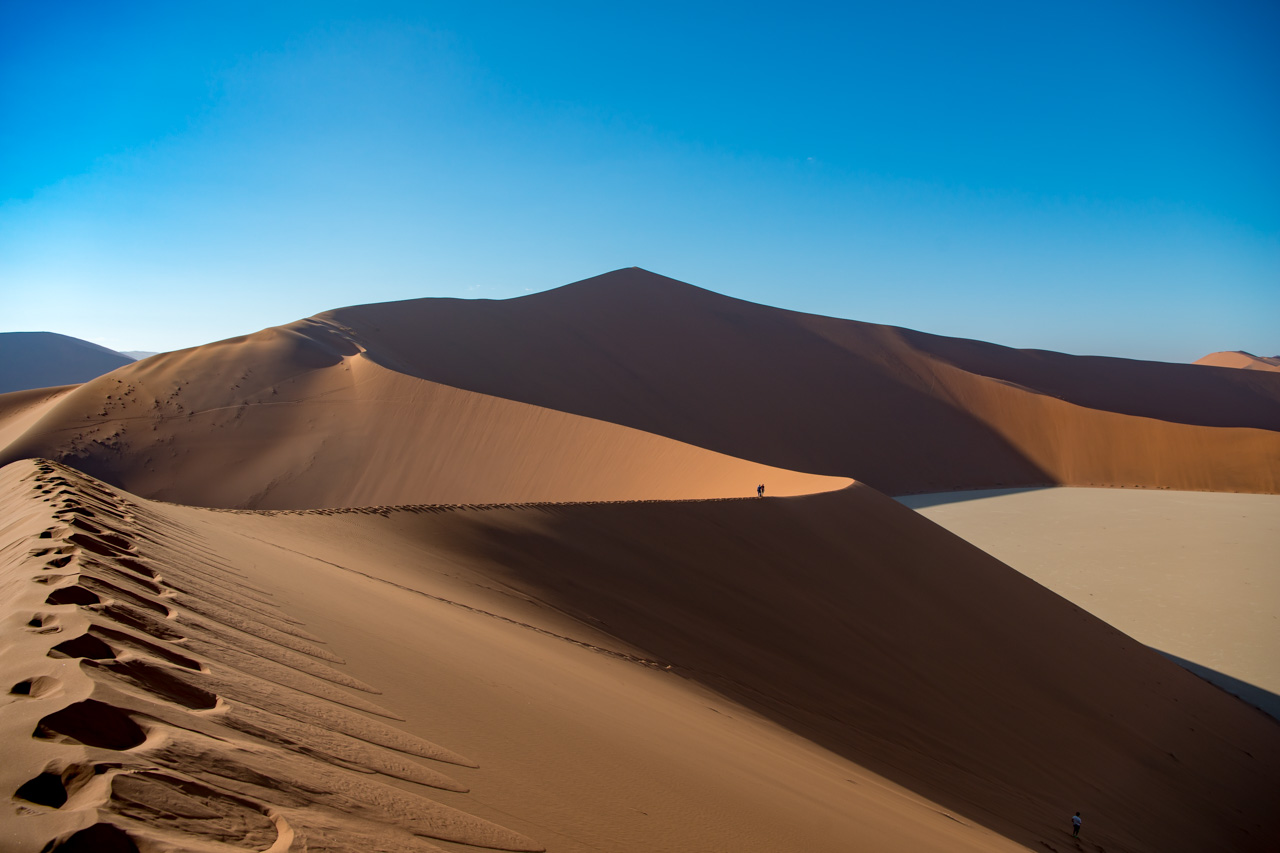
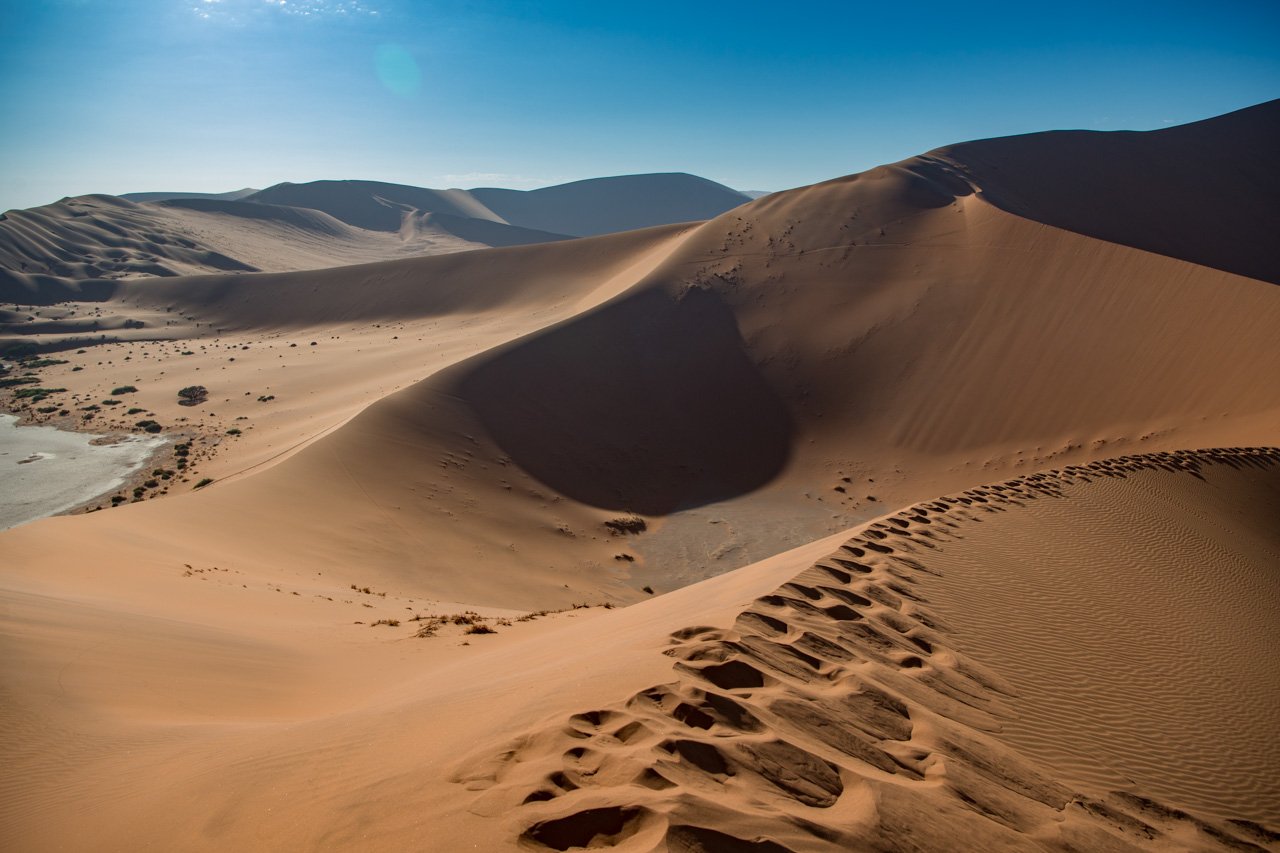
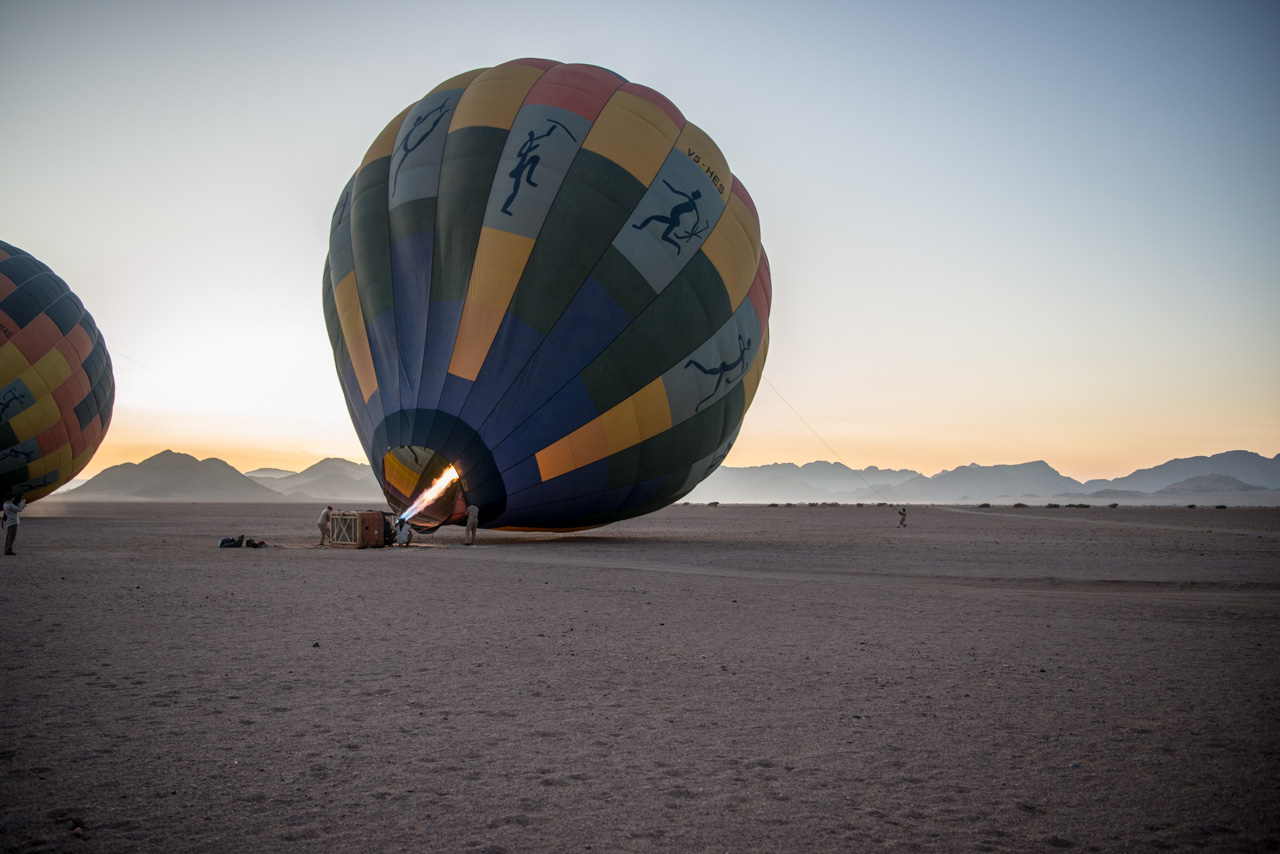

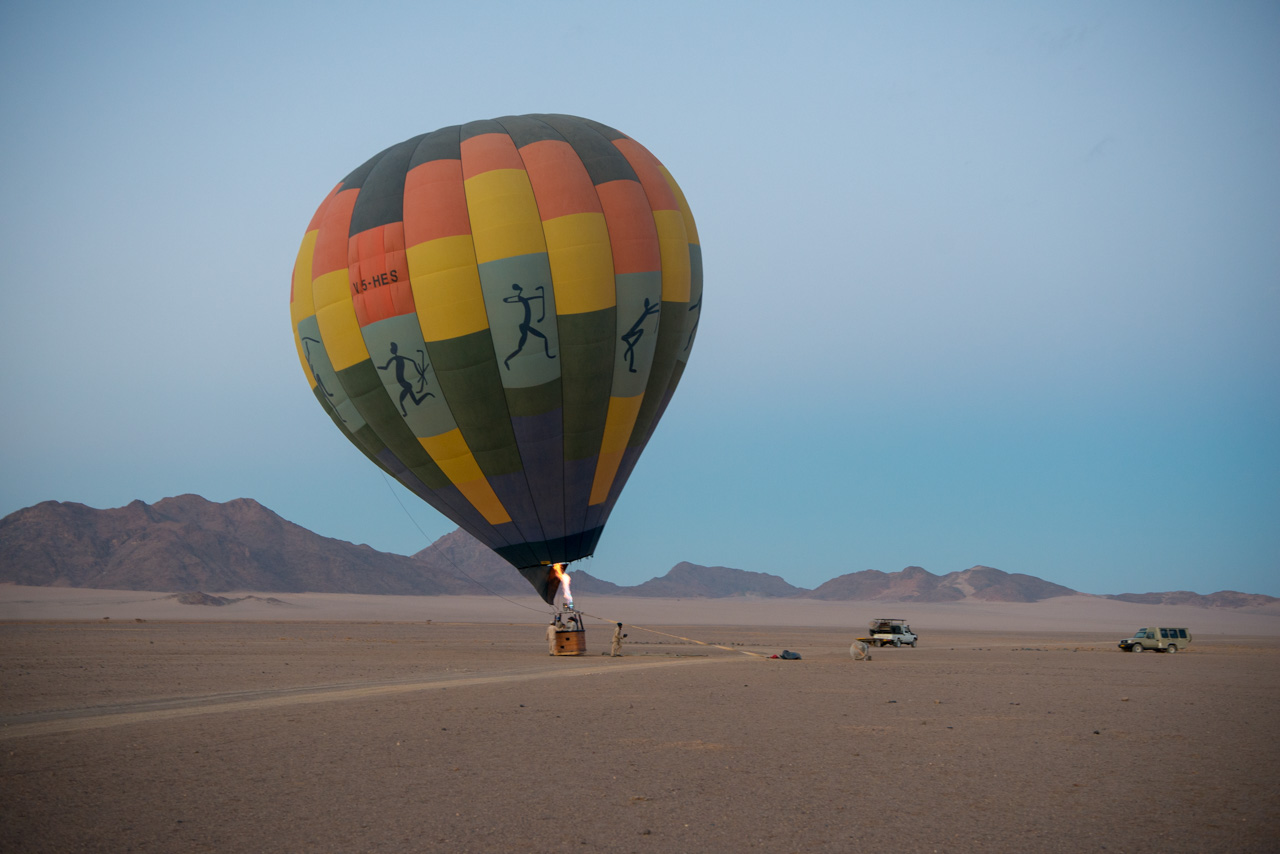
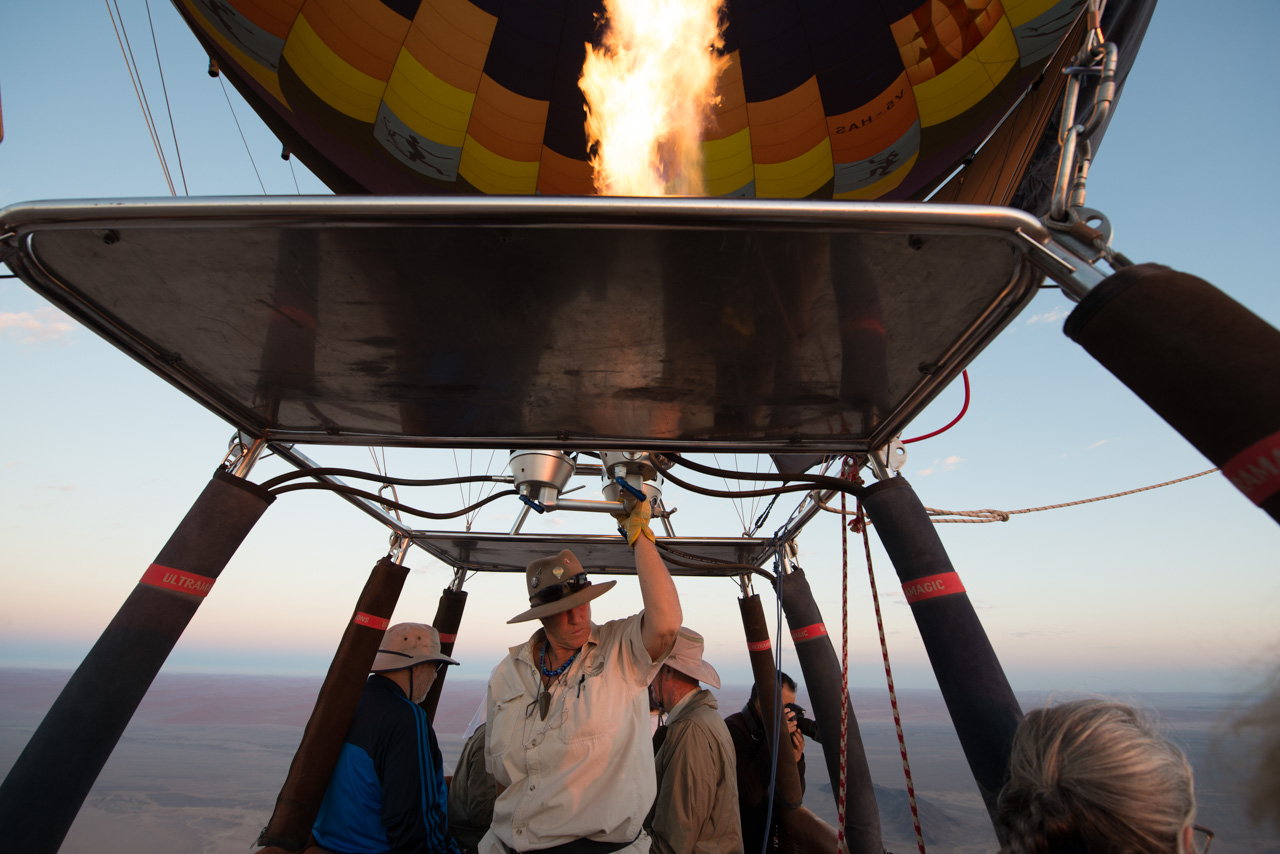
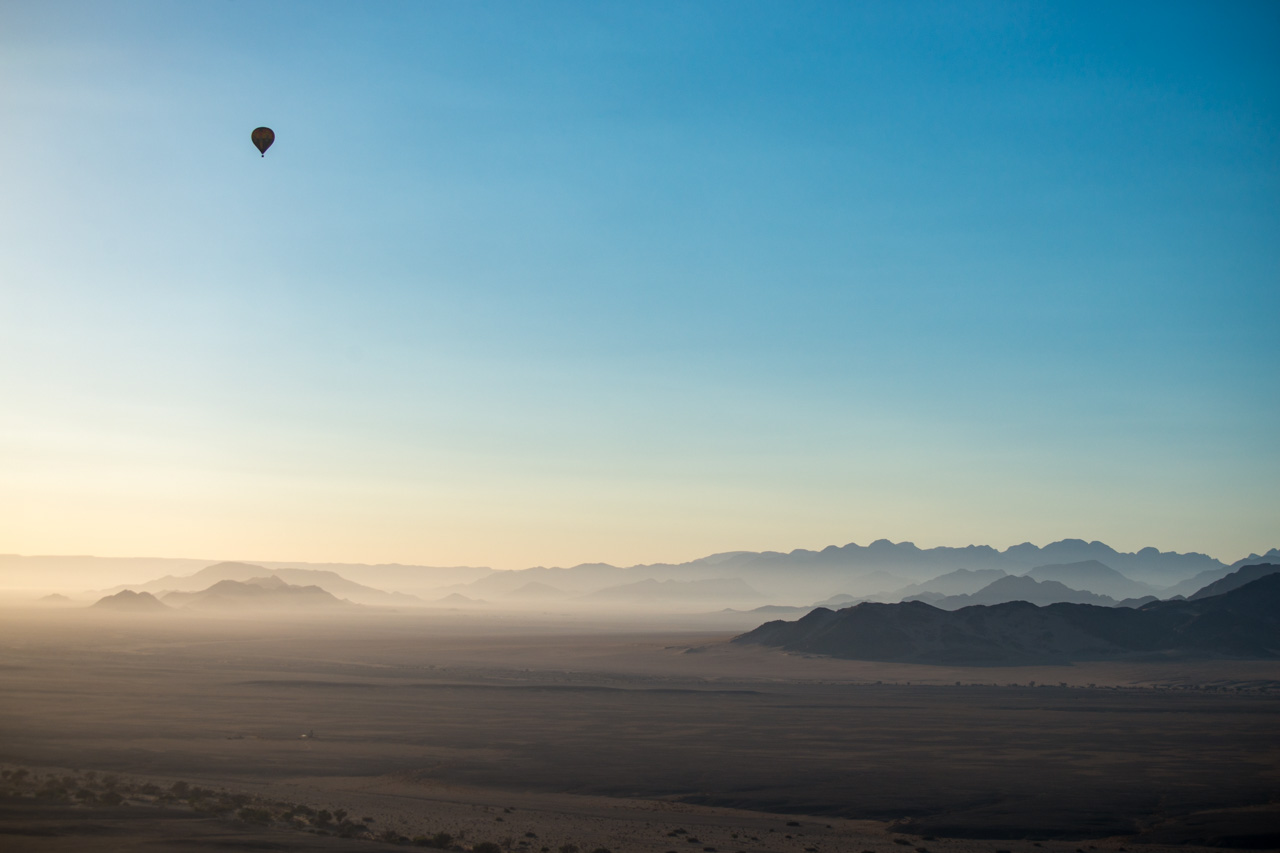
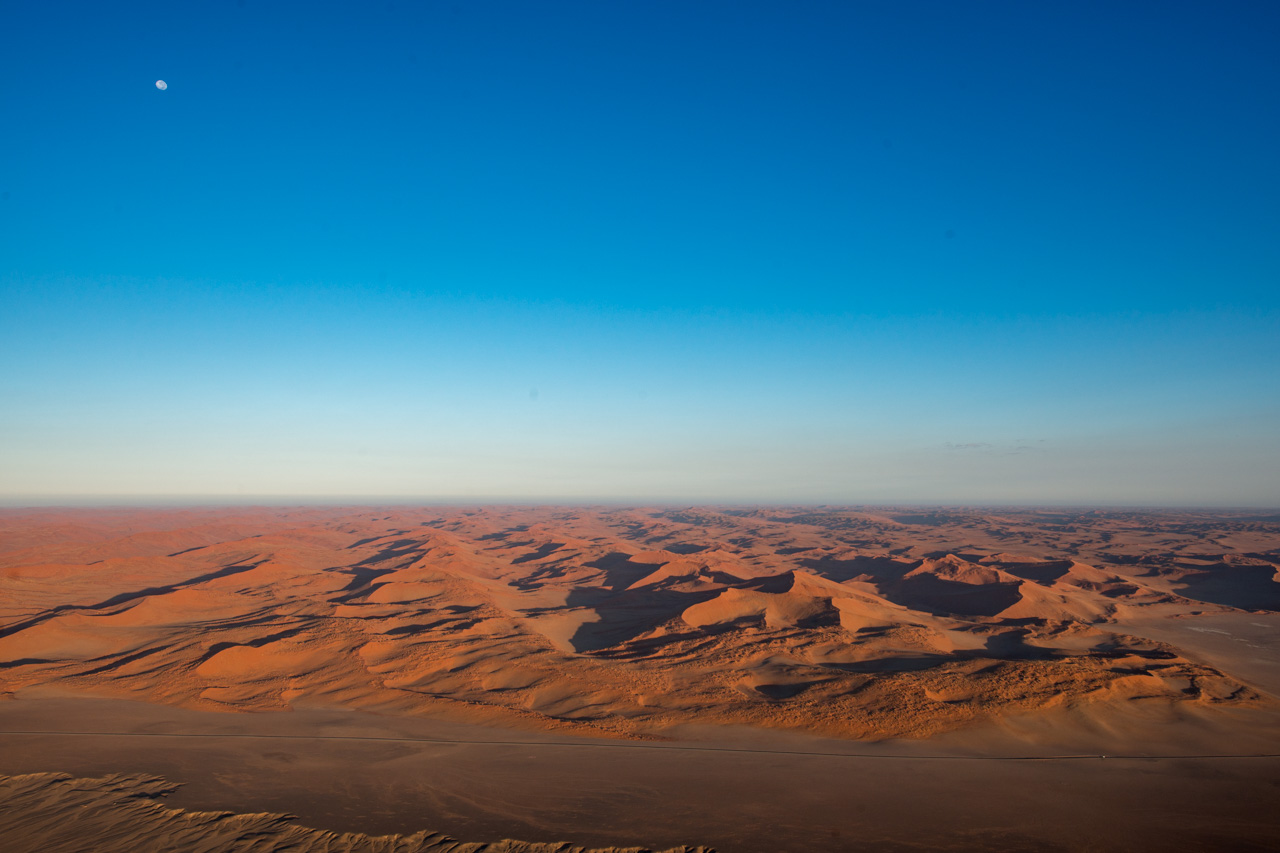
On landing (wherever the wind has taken you) there is a champagne breakfast waiting for you.

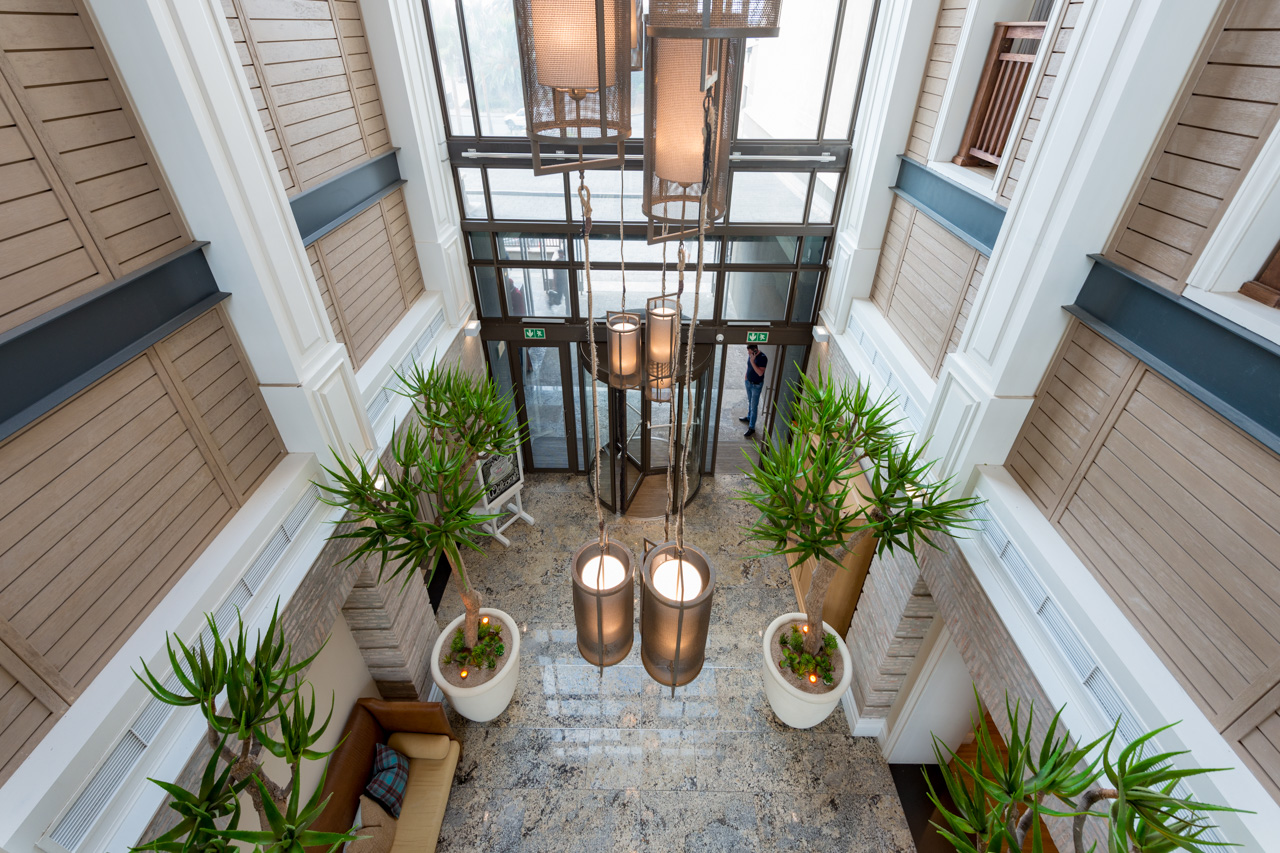
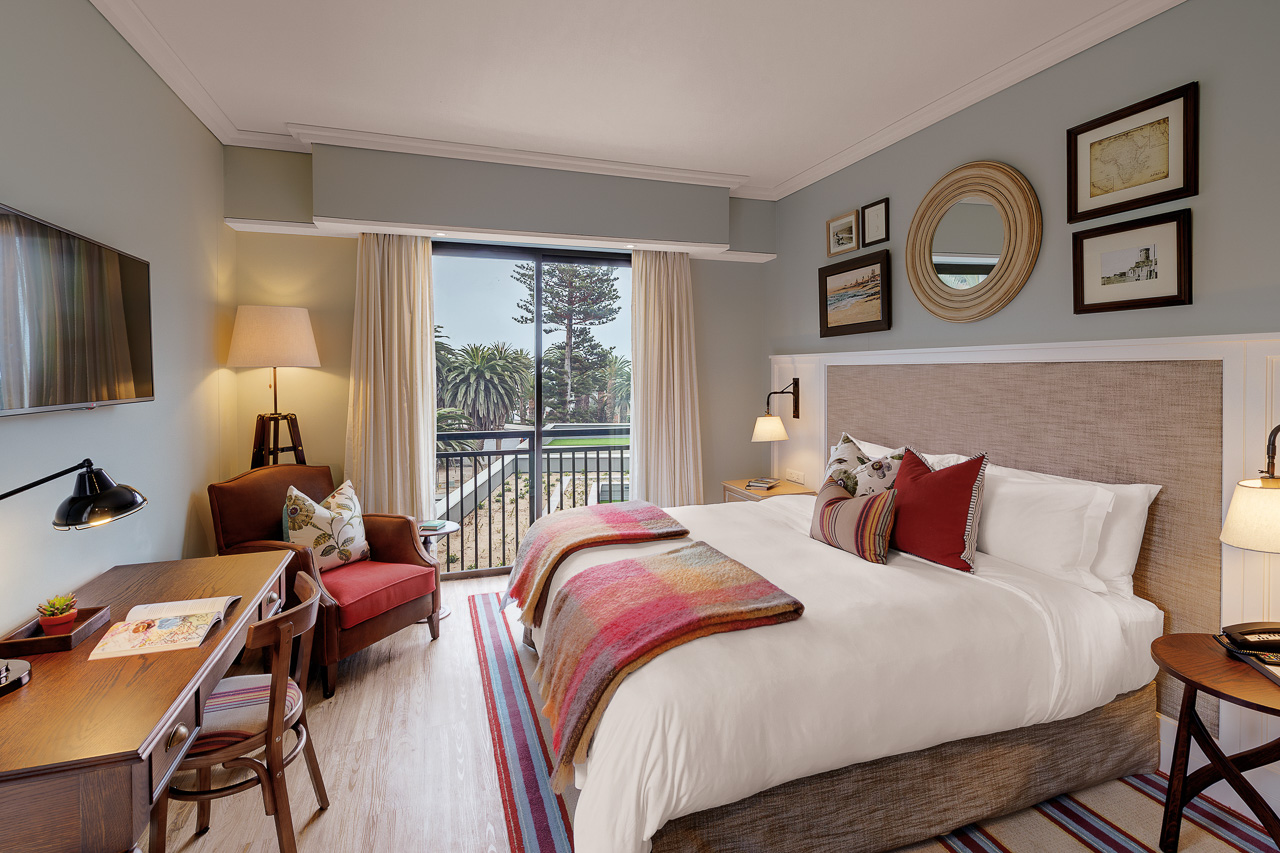
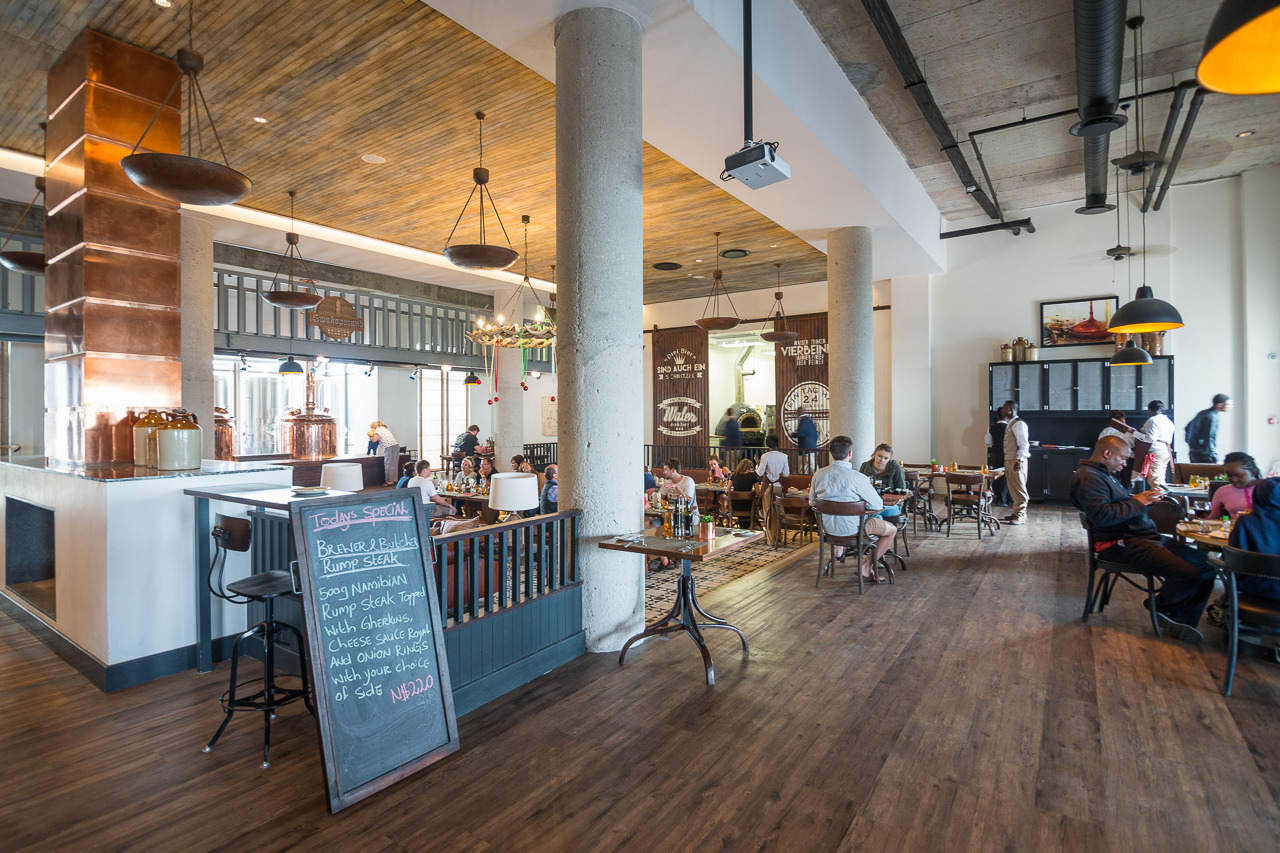
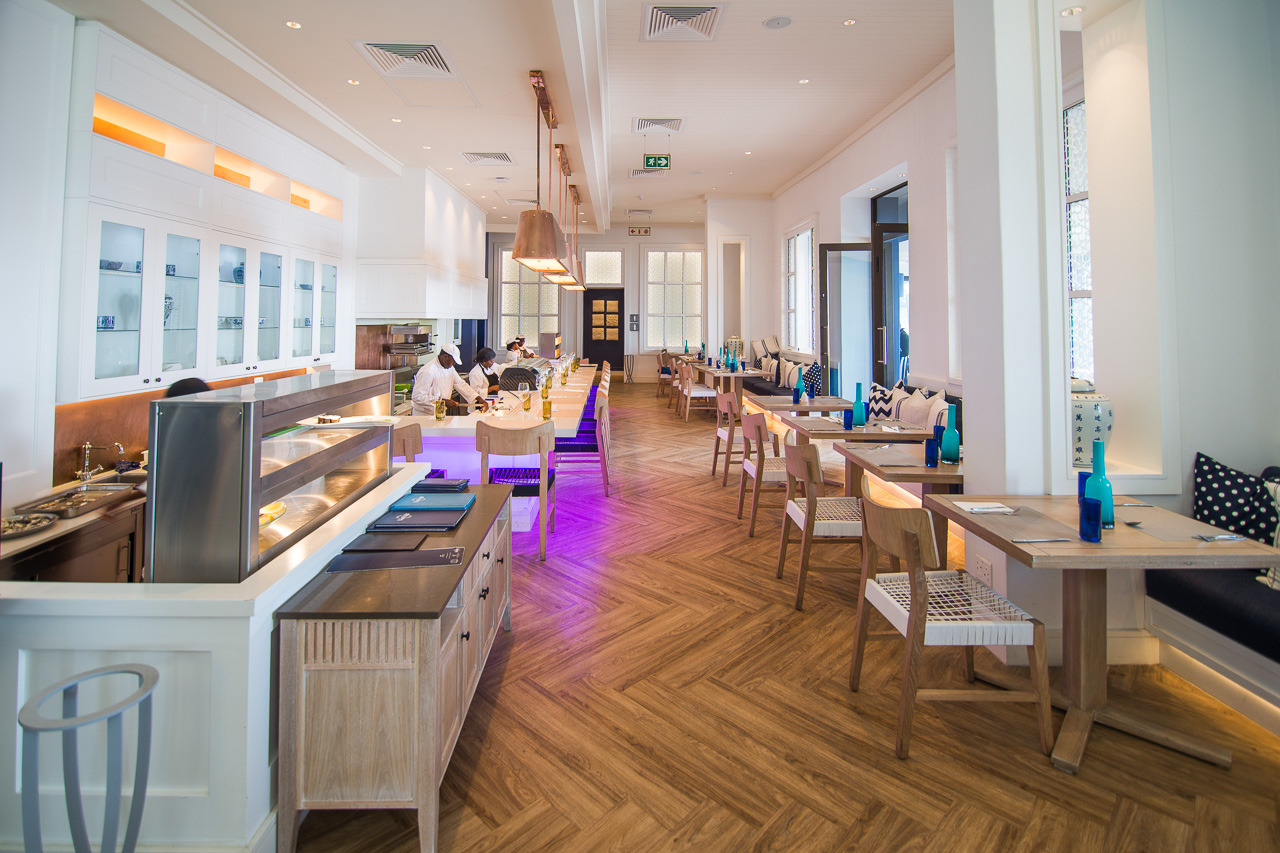
Accommodation The new Strand Hotel has set a new standard in Swakopmund. Uniquely located on the iconic and historic Swakopmund Mole and surrounded on three sides by the Southern Atlantic Ocean its 125 rooms and suites make this hotel one of the larger ones in town, but of those certainly the one with the best seaside location. All rooms have tea & coffee stations, mini-bars, hair-dryers, TV’s, free Wi-Fi Internet access, telephones and air-conditioning.
The Strand Hotel offers its residential guests and all casual visitors three exciting restaurants. The Farmhouse Deli is good for coffee, cake, sandwiches and fresh salads. The Brewer & Butcher welcomes beer and meat lovers. The Ocean Cellar caters for guests who prefer seafood, sushi, oyster and a glass of fine white wine.
The Strand Hotel is destined to become the social epicenter of Swakopmund for locals and tourists alike.
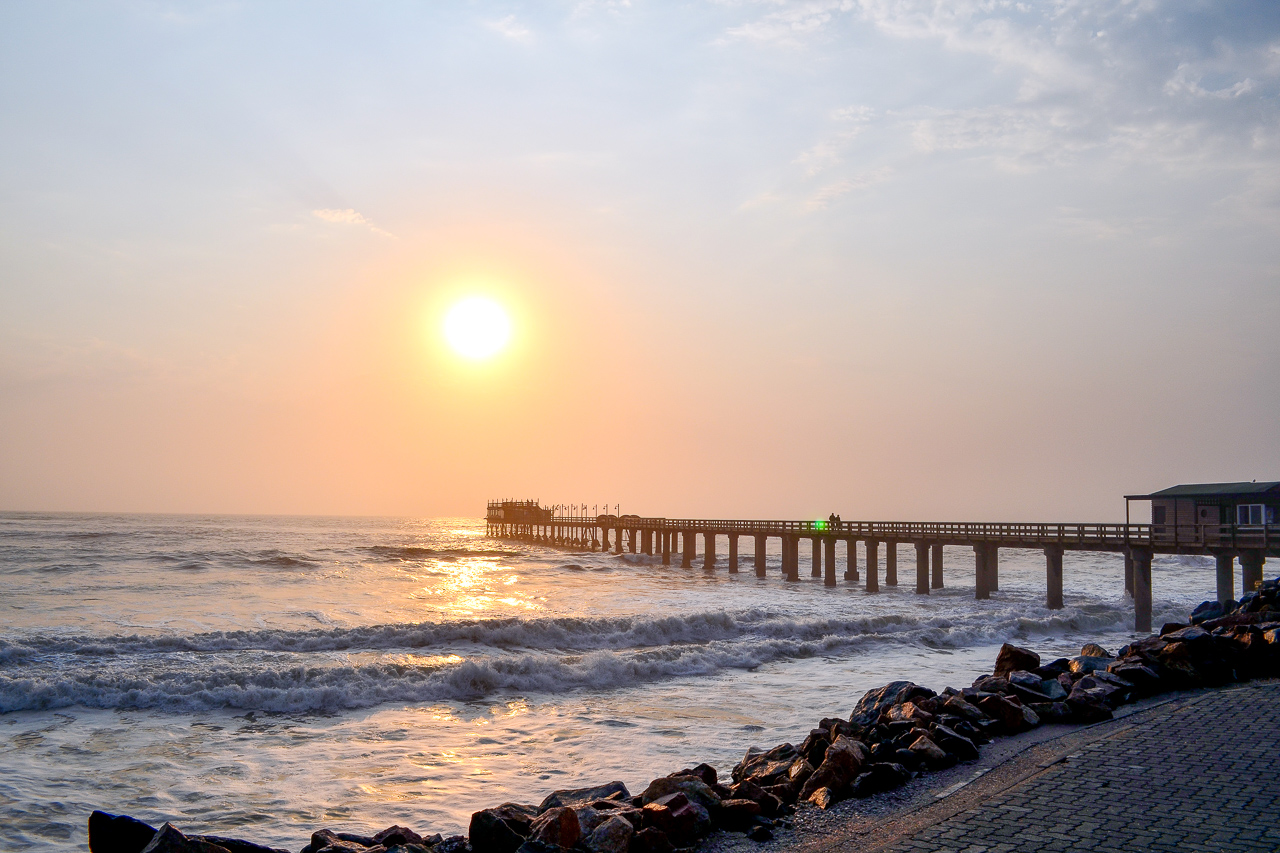
Swakopmund was the centre of German colonial rule, and relics of this chapter of its history can be found around every corner. Most noticeable of these is the long jetty, which stands witness to the German’s activities in this area and their attempt to create a usable port. Unfortunately, Swakopmund turned out to be wholly unsuitable for the task. Walvis Bay is a natural bay just 30 km south. It was occupied by the English as early as 1795, and later became a fish-processing industrial town under South African rule.
Swakopmund is charming. The old part of town is very pretty and offers several cafes, bakeries and, of course, the unavoidable beer houses. Time appears to have stood still in many parts, and it’s difficult not to keep rubbing your eyes in wonderment at the mix of German and African.
There’s a lot to do if you stay at Swakopmund: take a day trip southwards along the coast to Sandwich Harbour, hop on a boat at Walvis Bay and wait for the seals and pelicans to greet you, Kayak with seals, jump on a quad bike for a ride through the dunes, or just take a stroll along the beach and enjoy a tasty meal in one of the great restaurants. Swakopmund’s most famous landmark, the jetty, has been renovated and now boasts the appropriately named ‘Jetty 1905’ restaurant at its end.

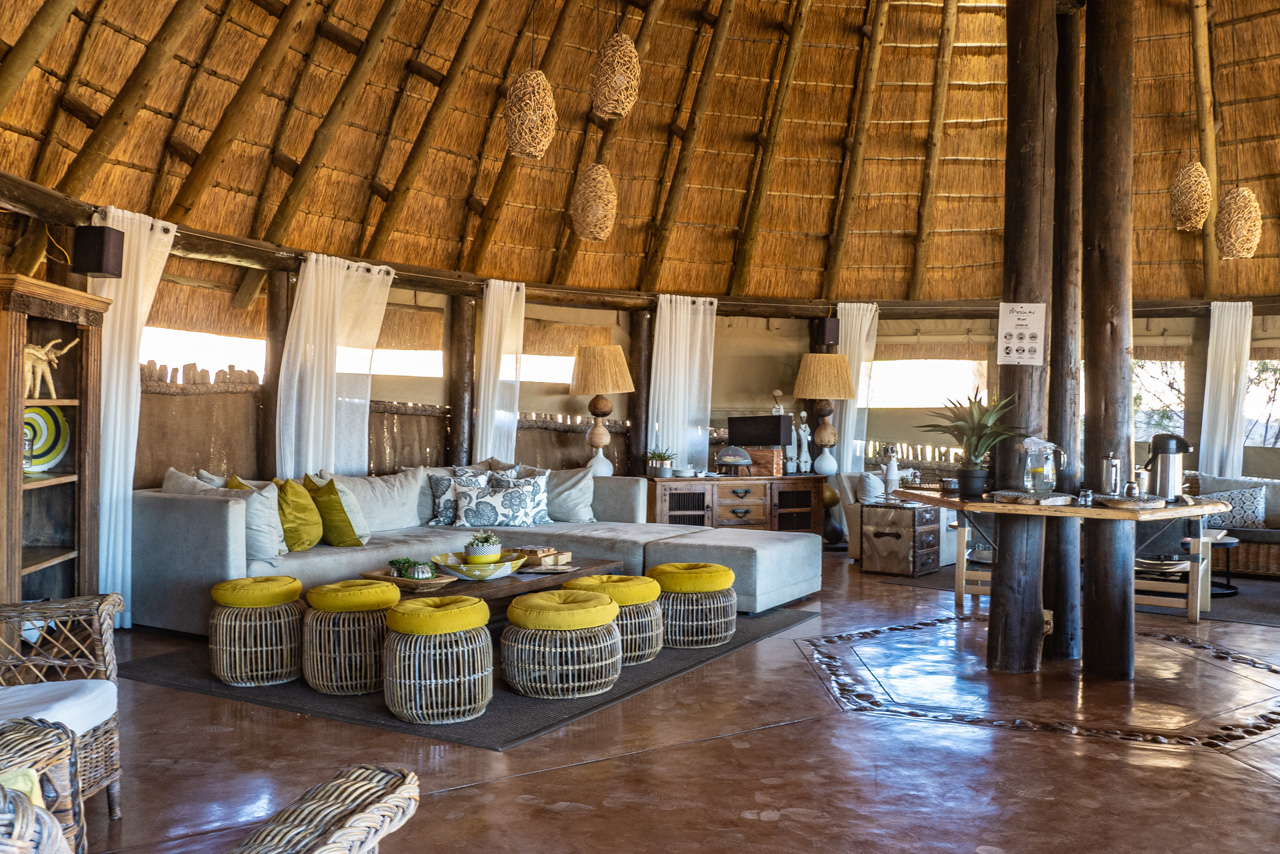
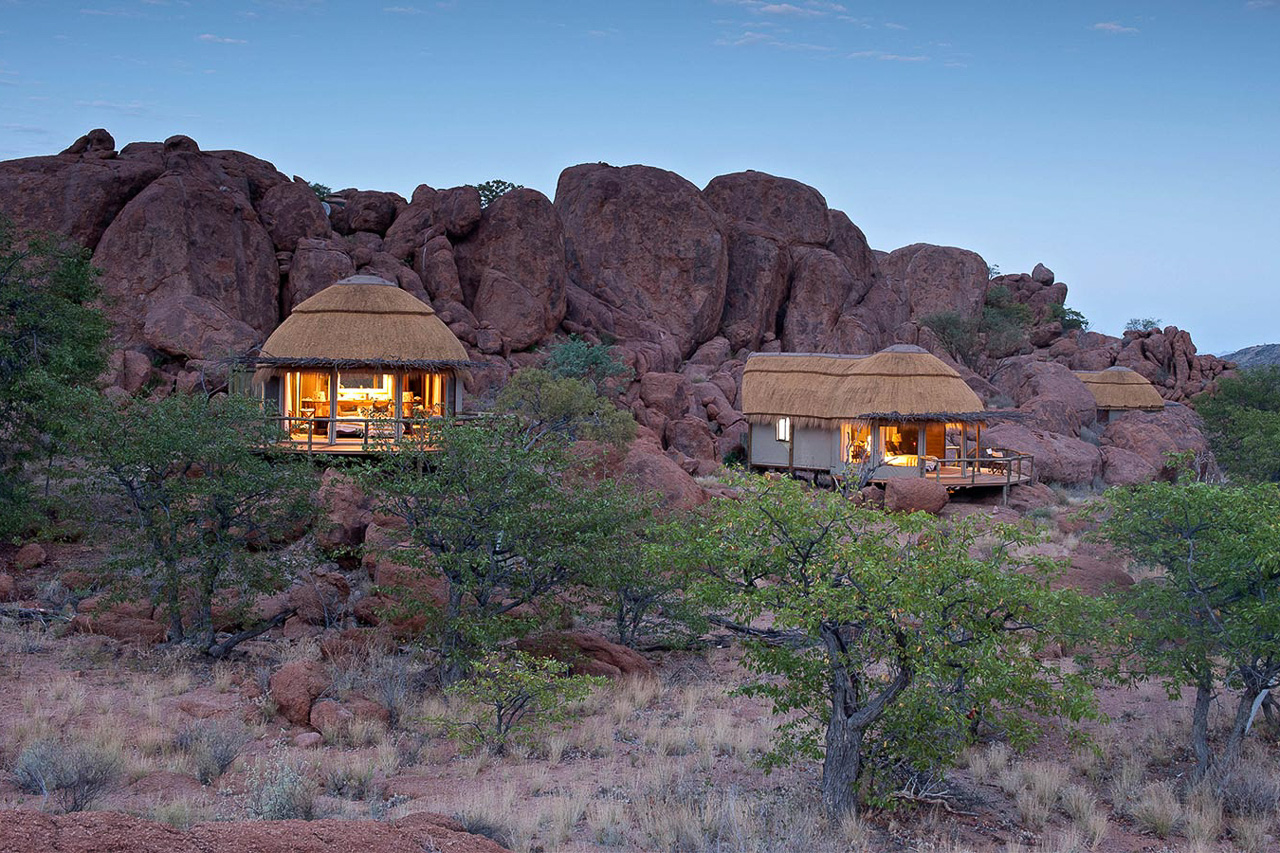
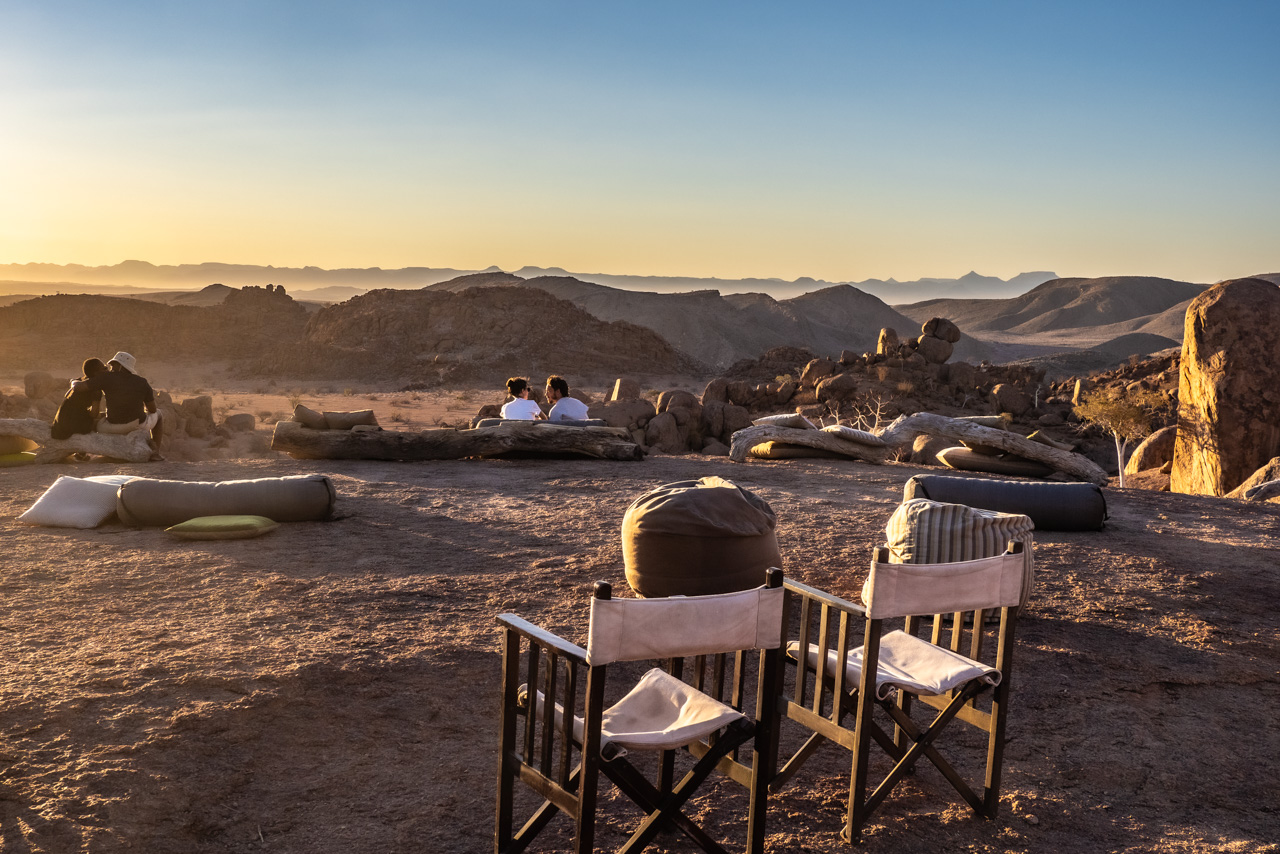
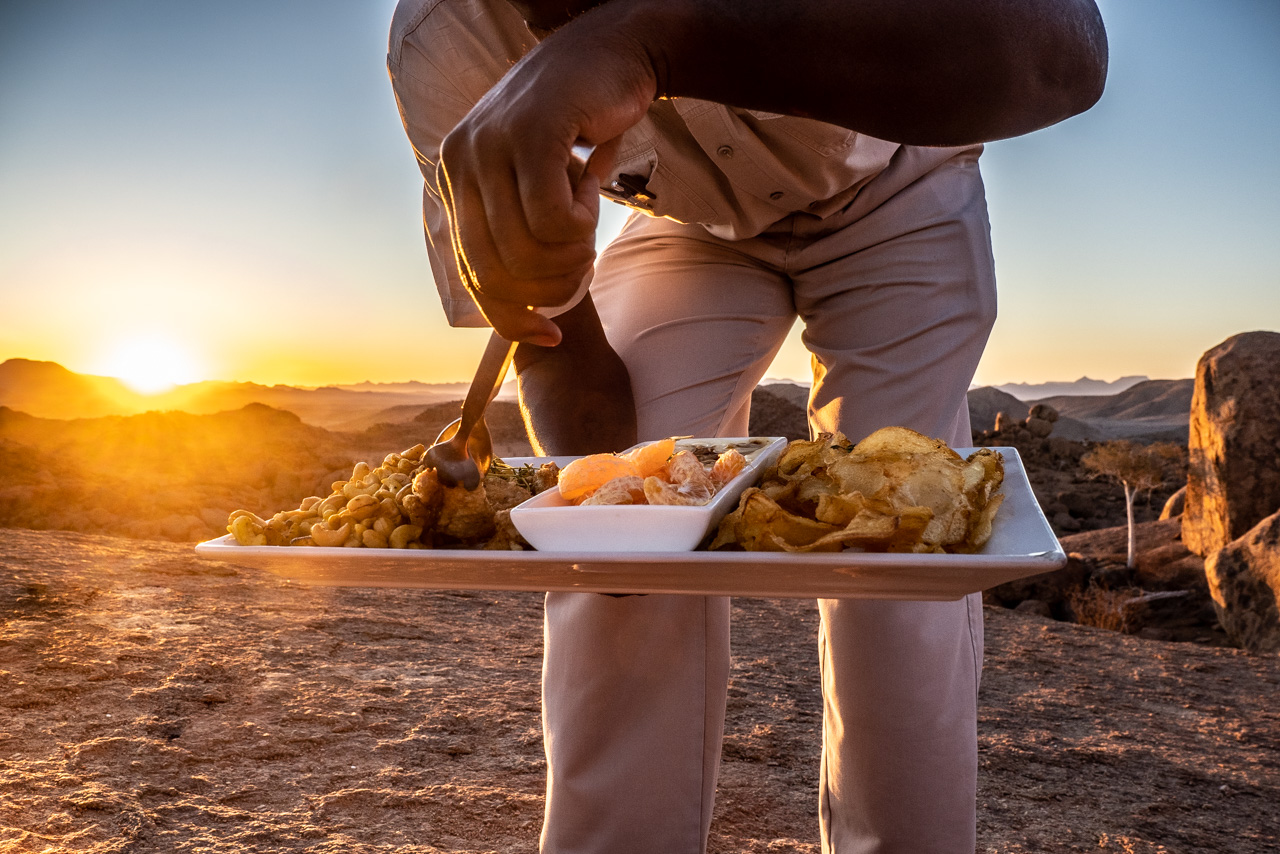
Accommodation
Mowani Mountain Camp comprises 12 charming rooms with high thatched roofs and comfortable verandas. The dome-like main roof leaves a window to the sky above the beds, stargazing from the bed so to say. The rooms are nestled between rounded boulders and blend in seamlessly with their surroundings. The room categories are defined by the quality of the view - accordingly there are 4 Superior View Rooms (No 1-4) with sunset view, 3 View Rooms (No 5-7) with view into a hidden valley and 5 Standard View Rooms (No 8-12). Some of the rooms have been extended with a canopy, under which a dome tent is placed, accommodating two children. Alternatively, these beds can be added to the room if parents prefer.
Mowani also offers a Luxury Room, a Mini Suite and the Mountain Suite with butler service, lounge and private dining area. These three rooms are larger and offer more privacy than the other rooms, but only the Mountain Suite stands out with a truly magnificent view.
The central area includes a small rock swimming pool with great views, lounge, restaurant and an extra wifi lounge. In the evening most guests visit the rock-top viewing plateau to enjoy the sunset. The sundowner drink is added to the view upon request.
Just across the road lies Camp Kipwe, Mowani‘s sister camp.
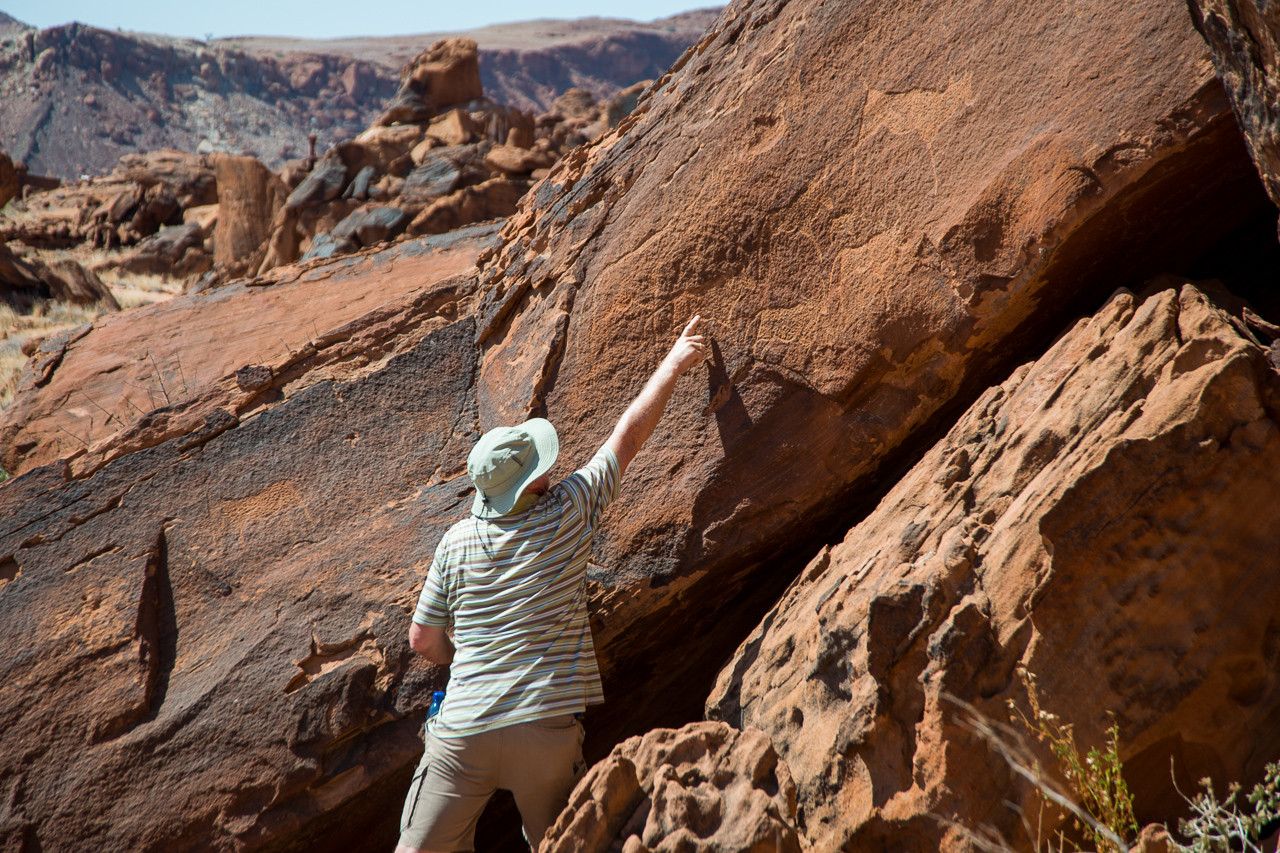
Twyfelfontein was declared a World Heritage Site in 2007 because of its significance as one of the most important sites of African rock engravings. The area is home to one of the few watering holes in the entire region, and one which the local farmers didn’t find particularly reliable: roughly translated, the name Twyfelfontein means ‘sometimes there’s water, sometime’s there isn’t’!
Today, some 40’000 guests from around the globe visit the rock engravings, which has made Twyfelfontein one of Namibia’s destination hotspots and therefore quite busy – visitors can’t expect to have the rock engravings all to themselves.
This region had been familiar to its ancient residents for a long time: they gathered close to the only source of water during the dry season, carried out their rituals, and drew and carved their experiences onto and into the slabs of rock around them. The naturally occurring iron oxide in the sandstone formed a protective layer (the so-called ‘desert varnish’) over the rock engravings. This layer has slowed down the weathering process and allowed us to admire these thousands-of-years-old works of art today. Many of the engravings depict hunting scenes with giraffe, antelope, zebra, ostrich, rhino, elephant and lion – and interestingly enough, also a seal! Humans are rarely depicted. The drawings are often surrounded by geometric patterns.
To avoid contamination and vandalism, guests may only visit the area with a guide, who will highlight the most famous motifs, including the lion with a kink in its tail and the dancing kudu. The tour takes about an hour for the first motifs, and a further hour if you wish to see the rest. It is best to visit in the early morning or late afternoon in order to avoid the worst of the heat.
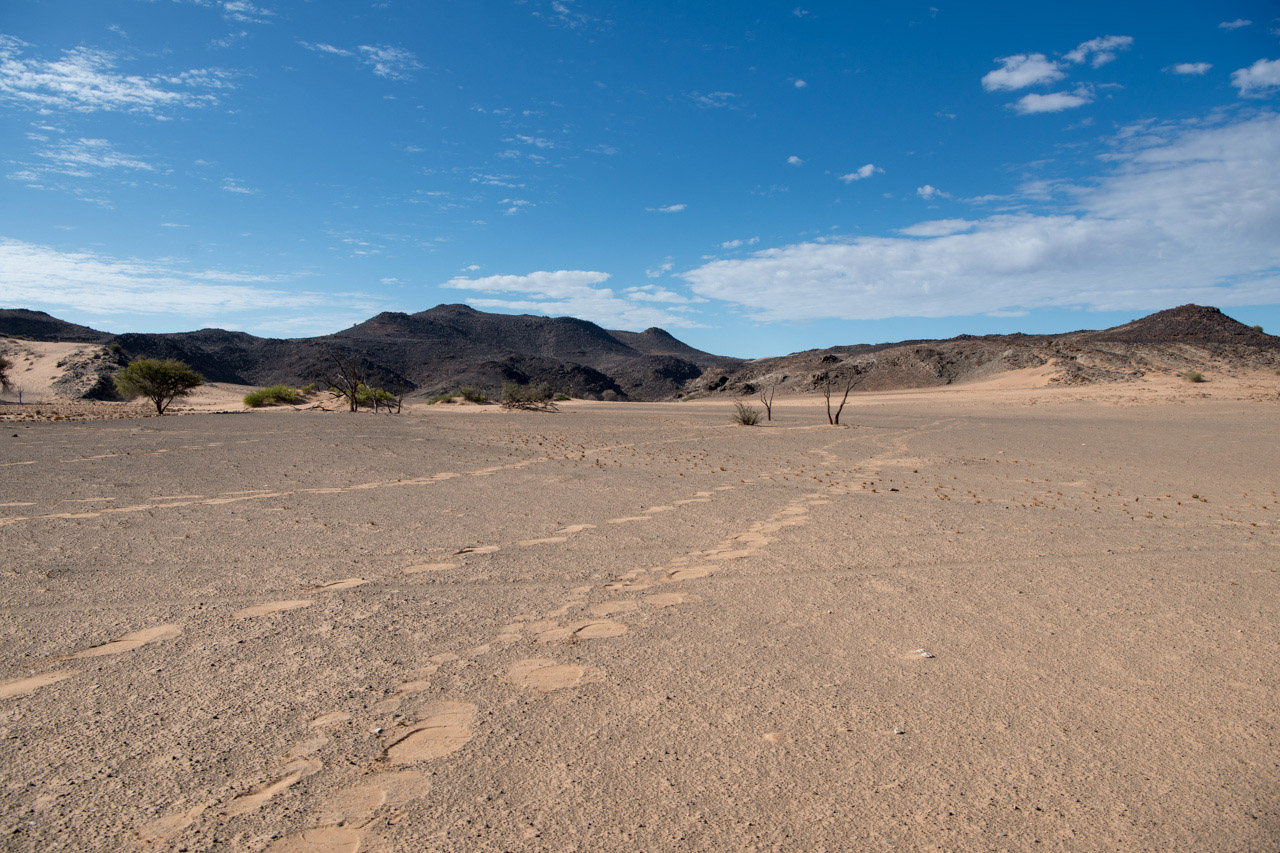
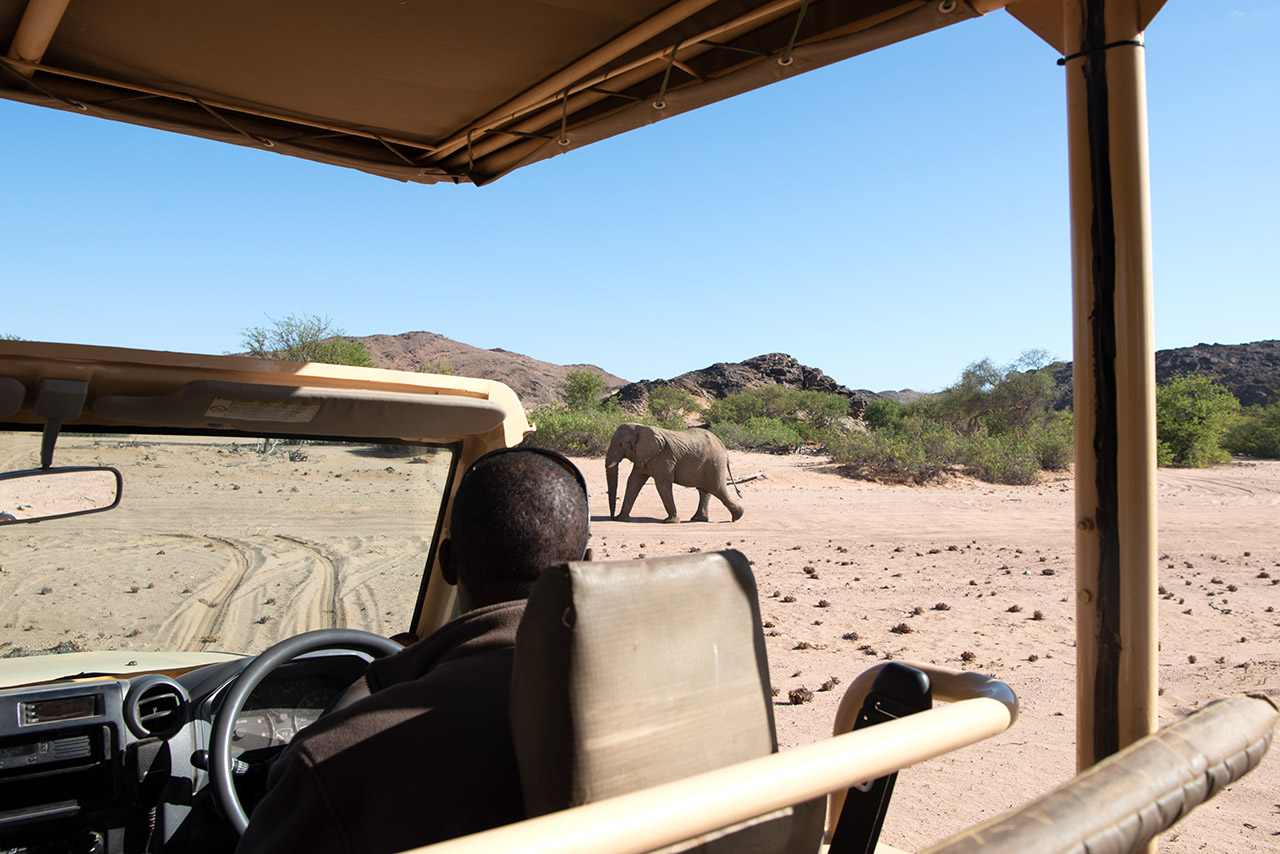
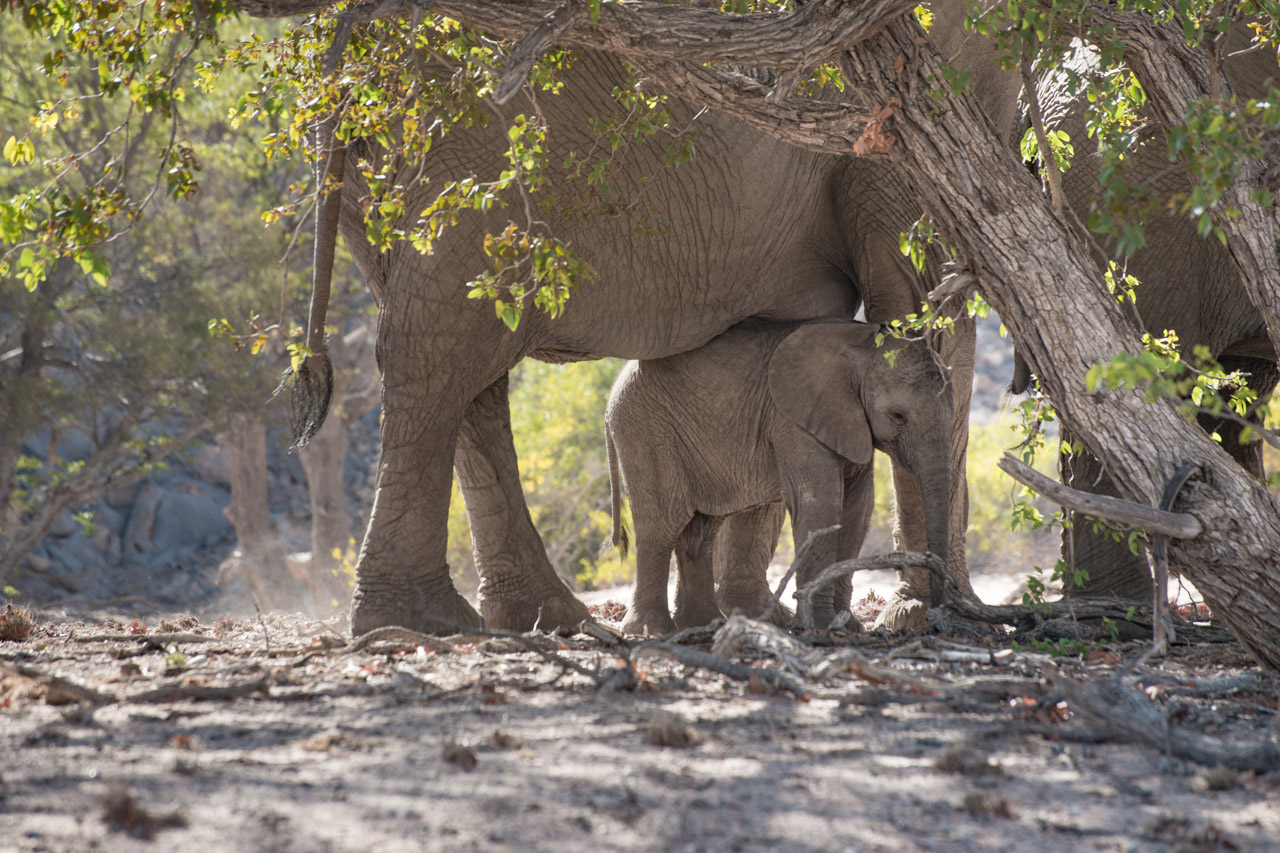
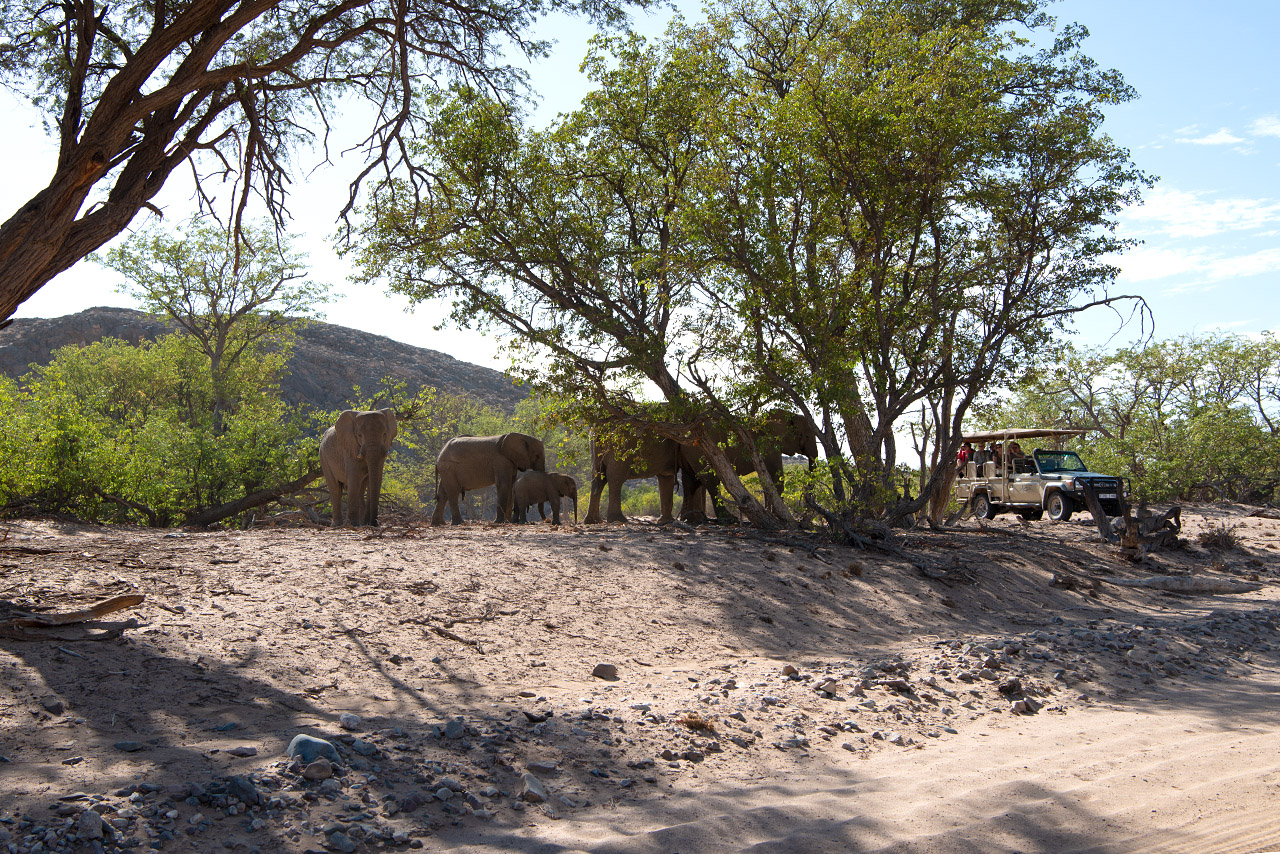
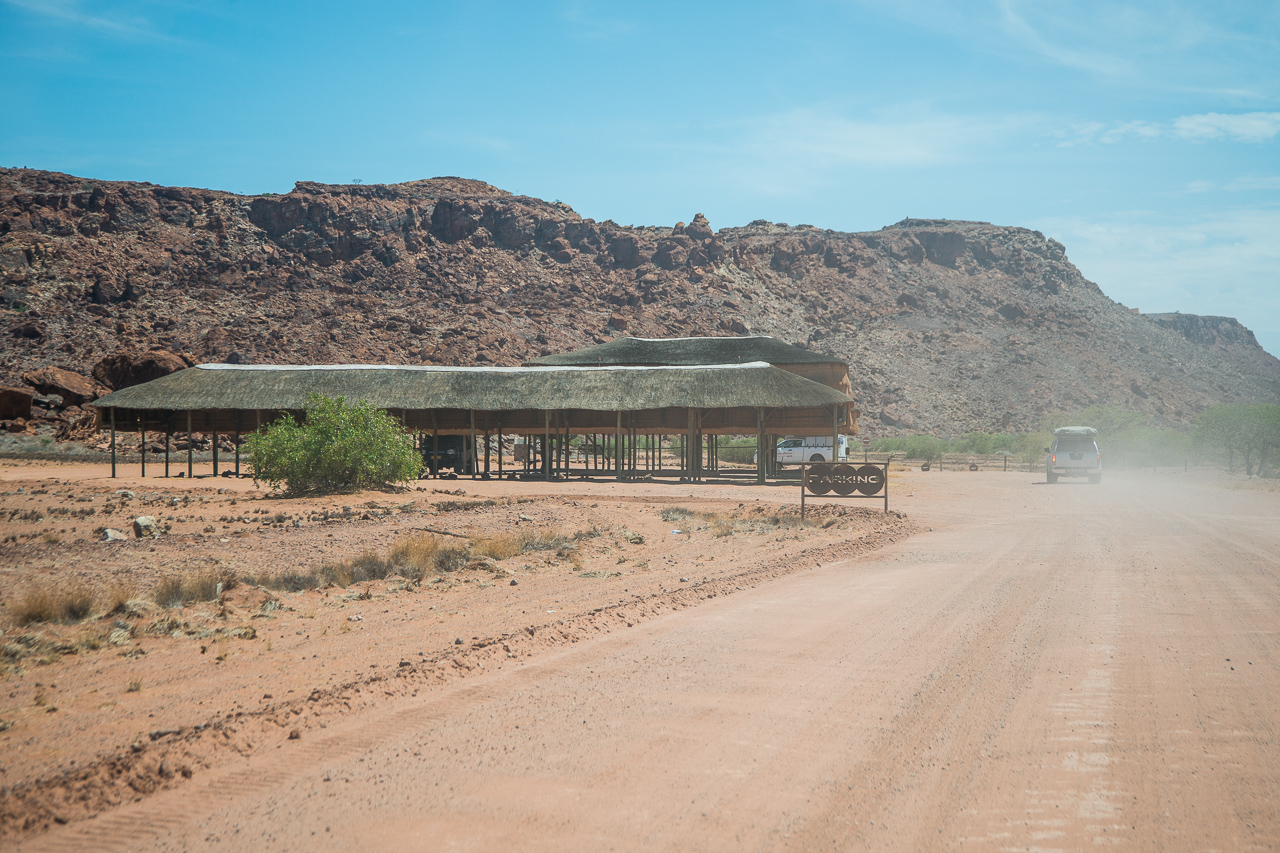
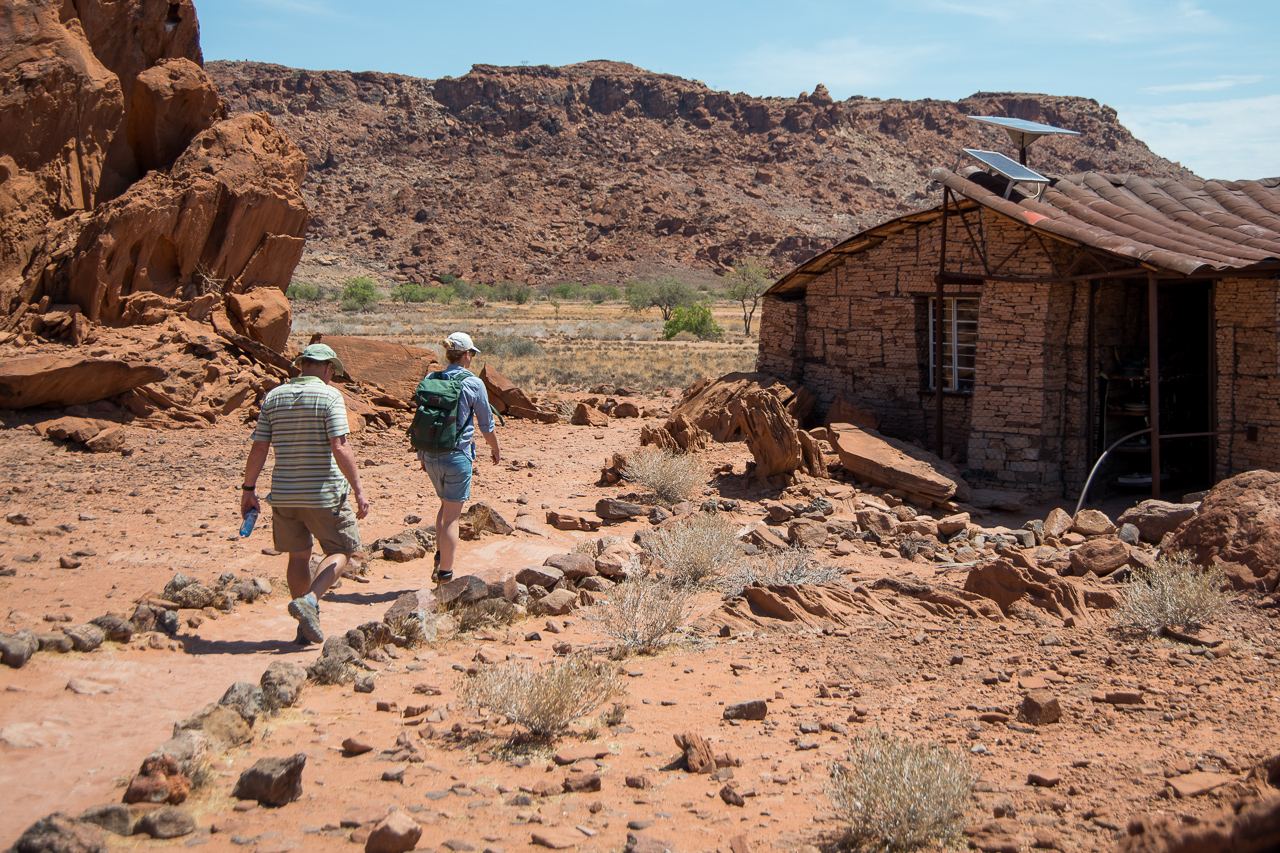
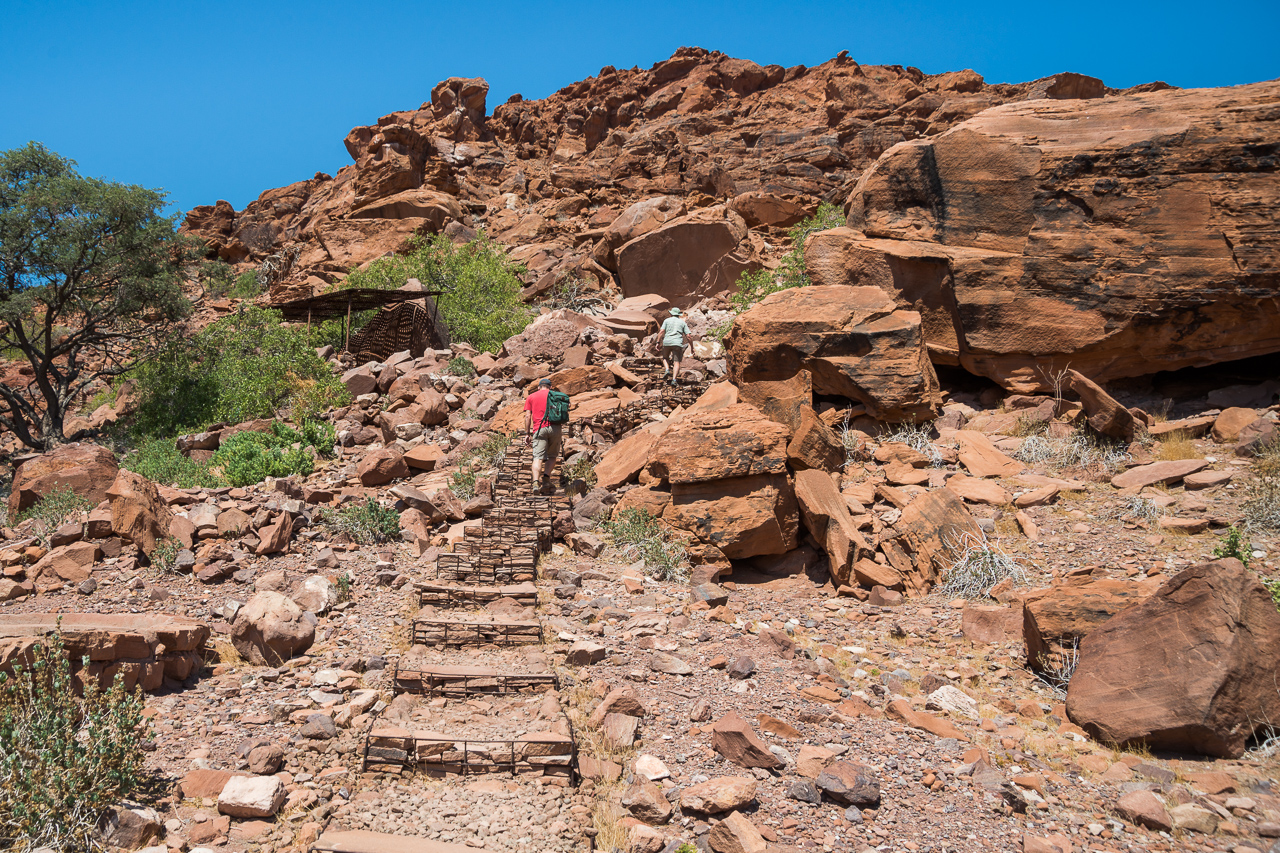
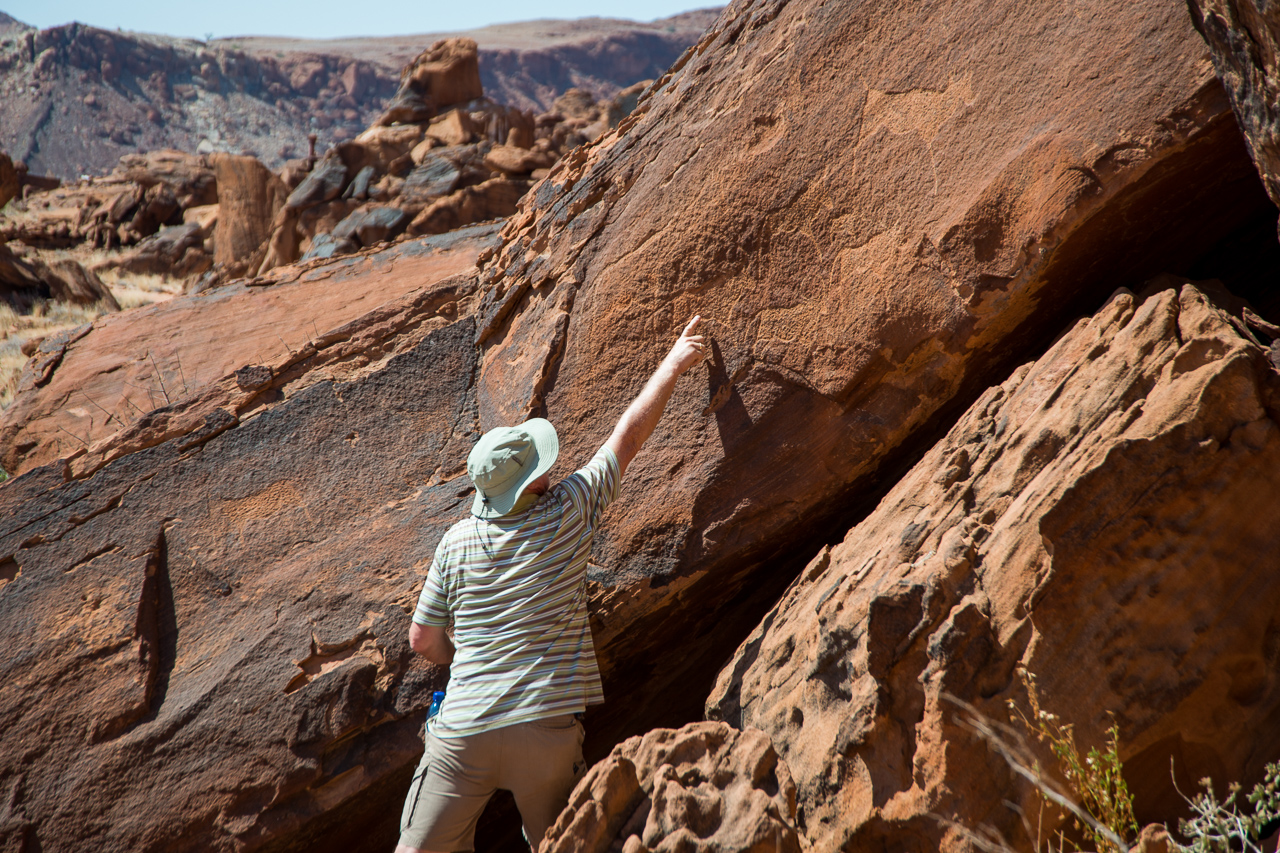
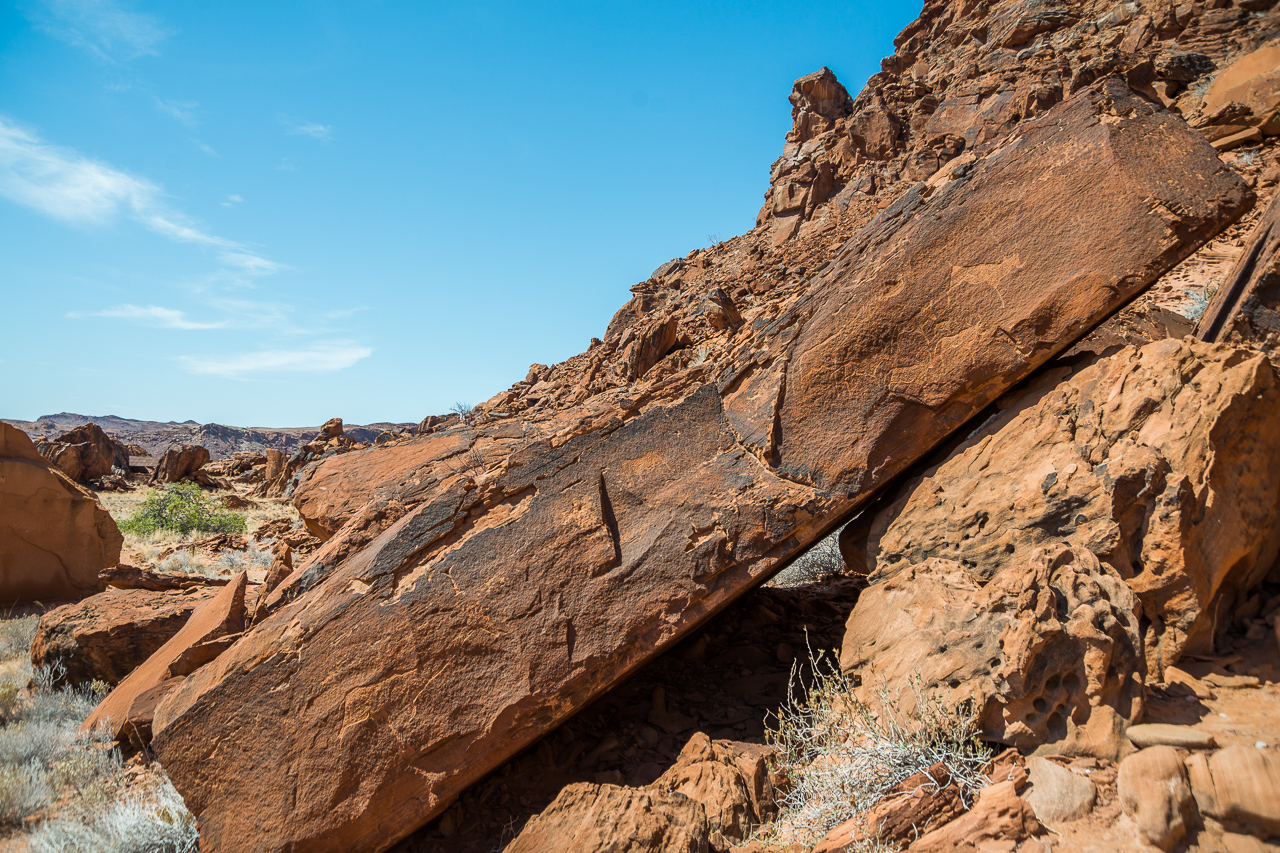
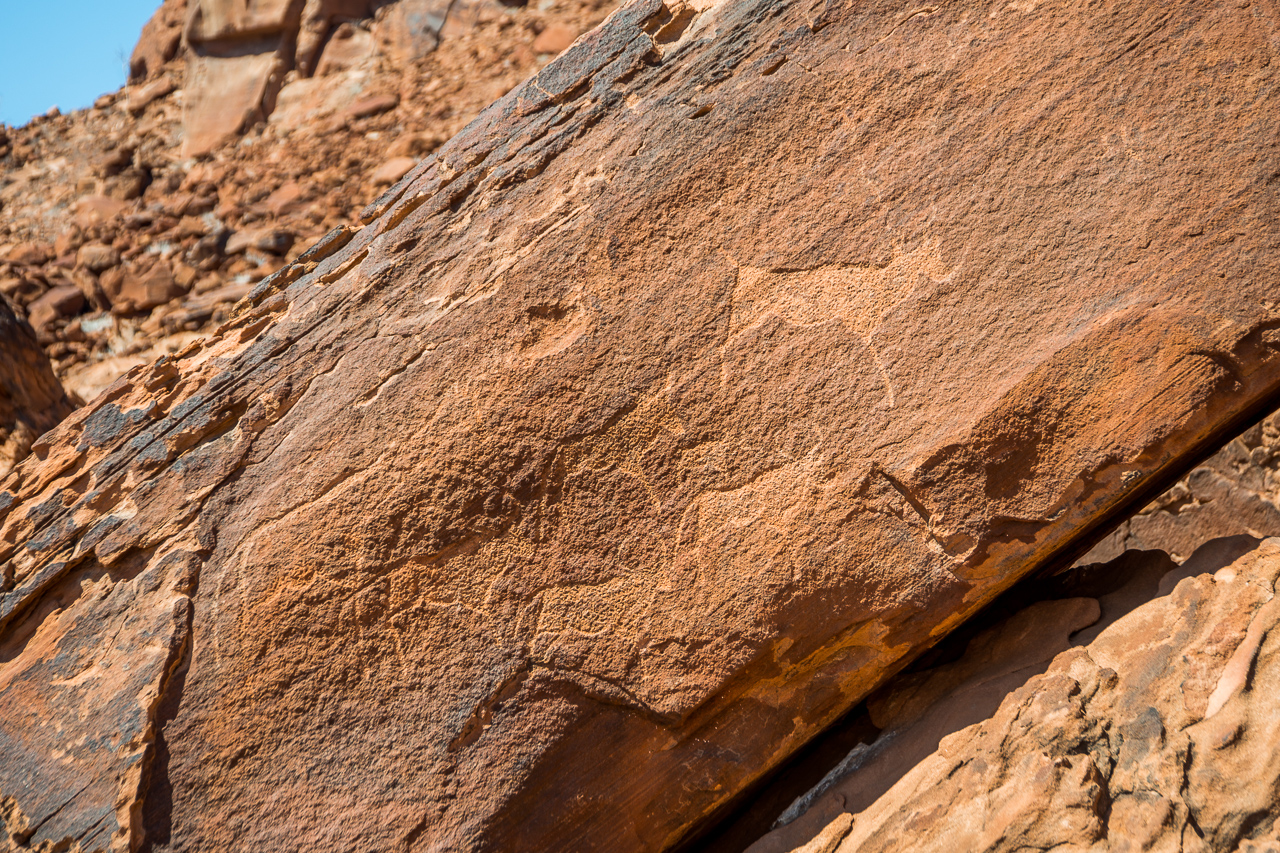
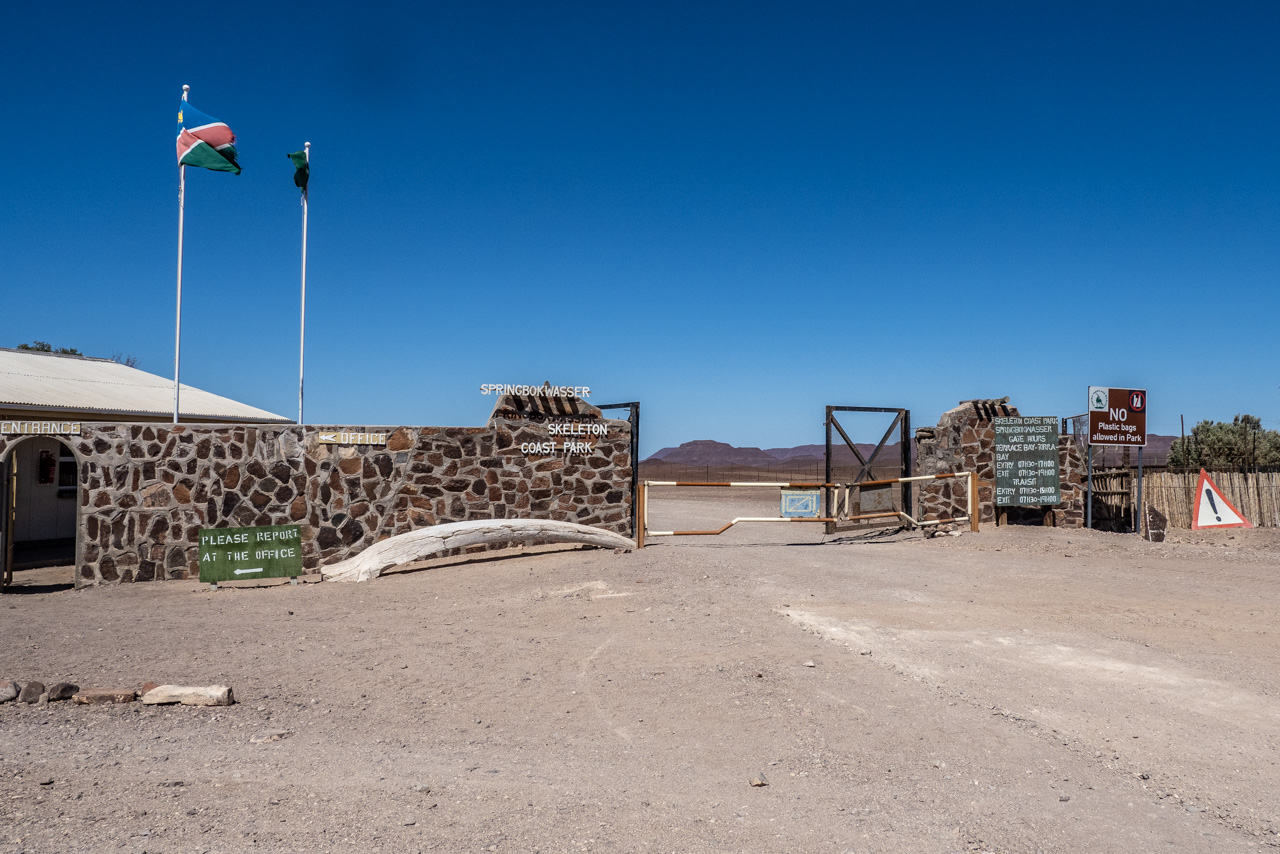

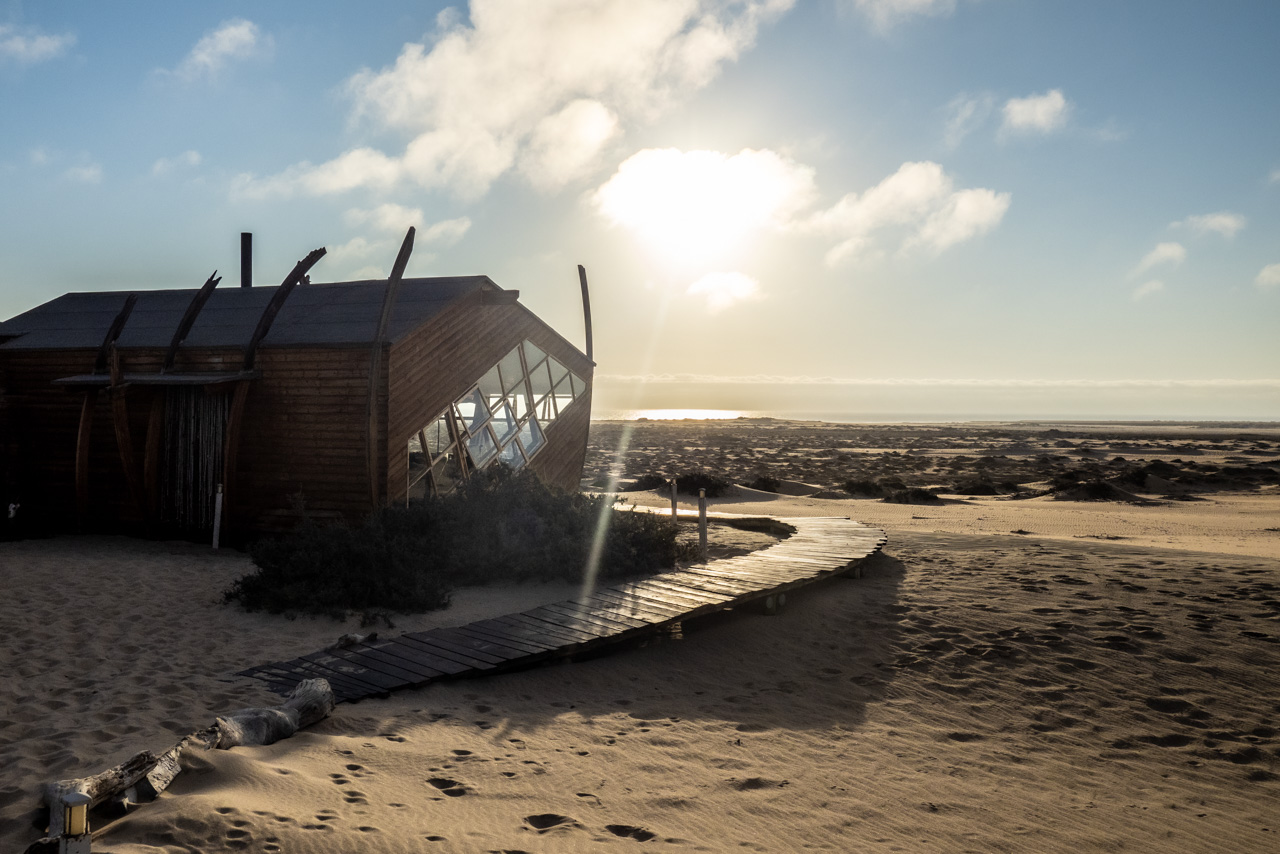
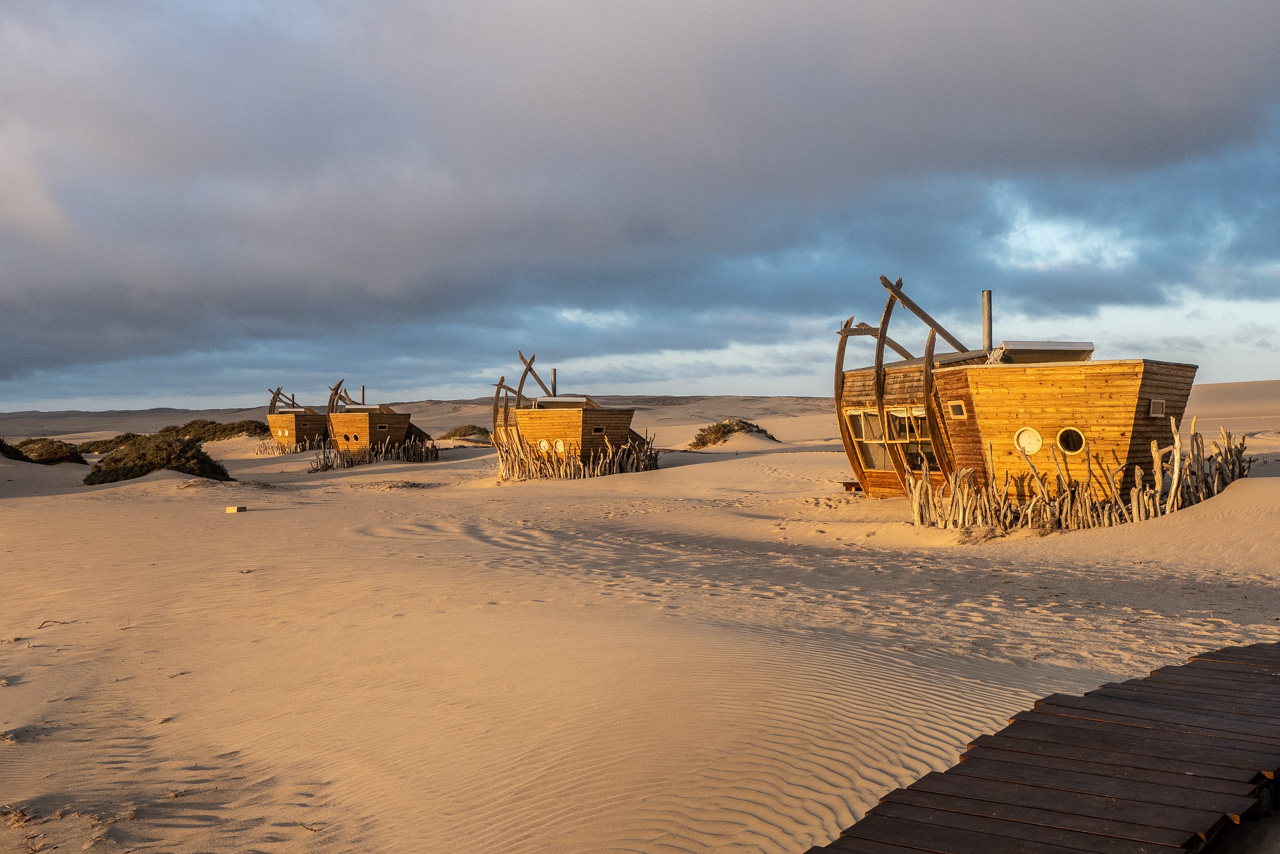
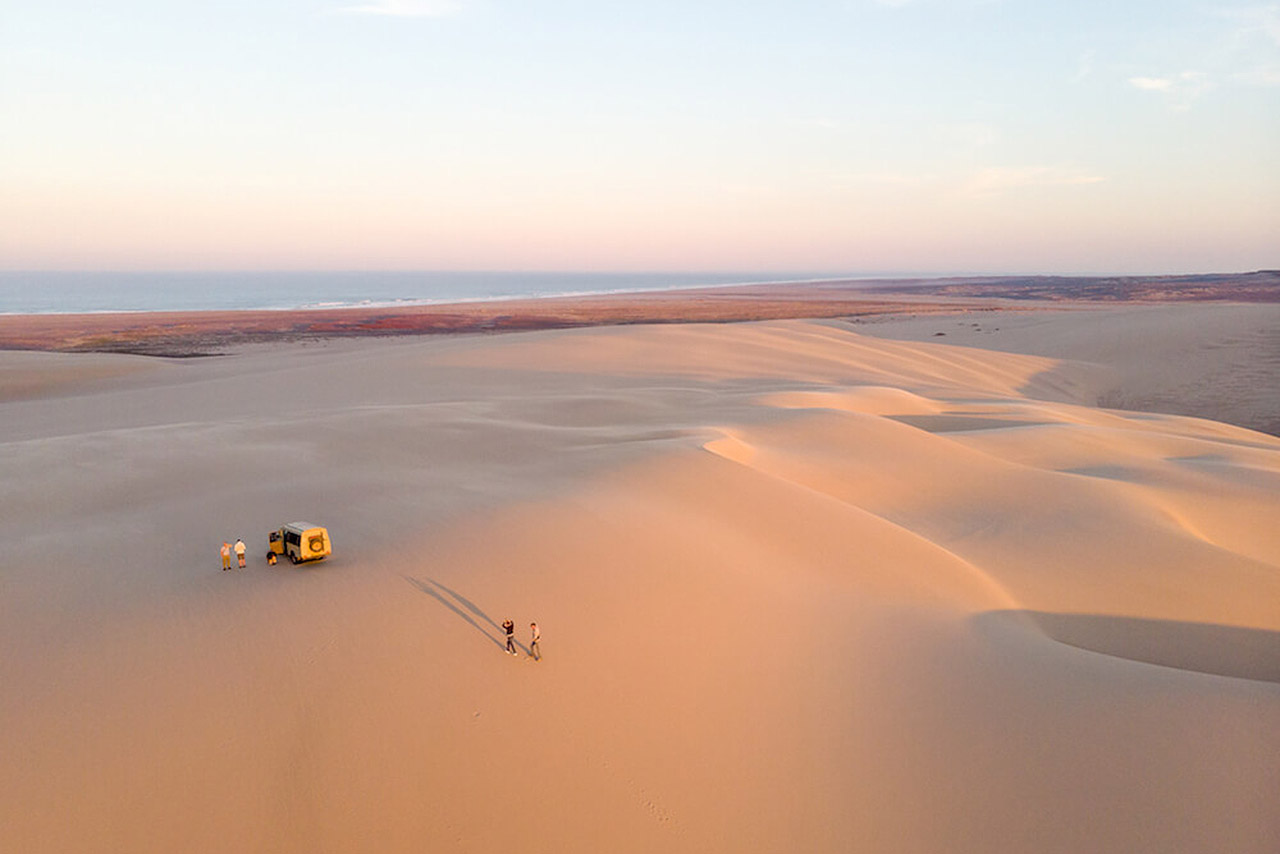
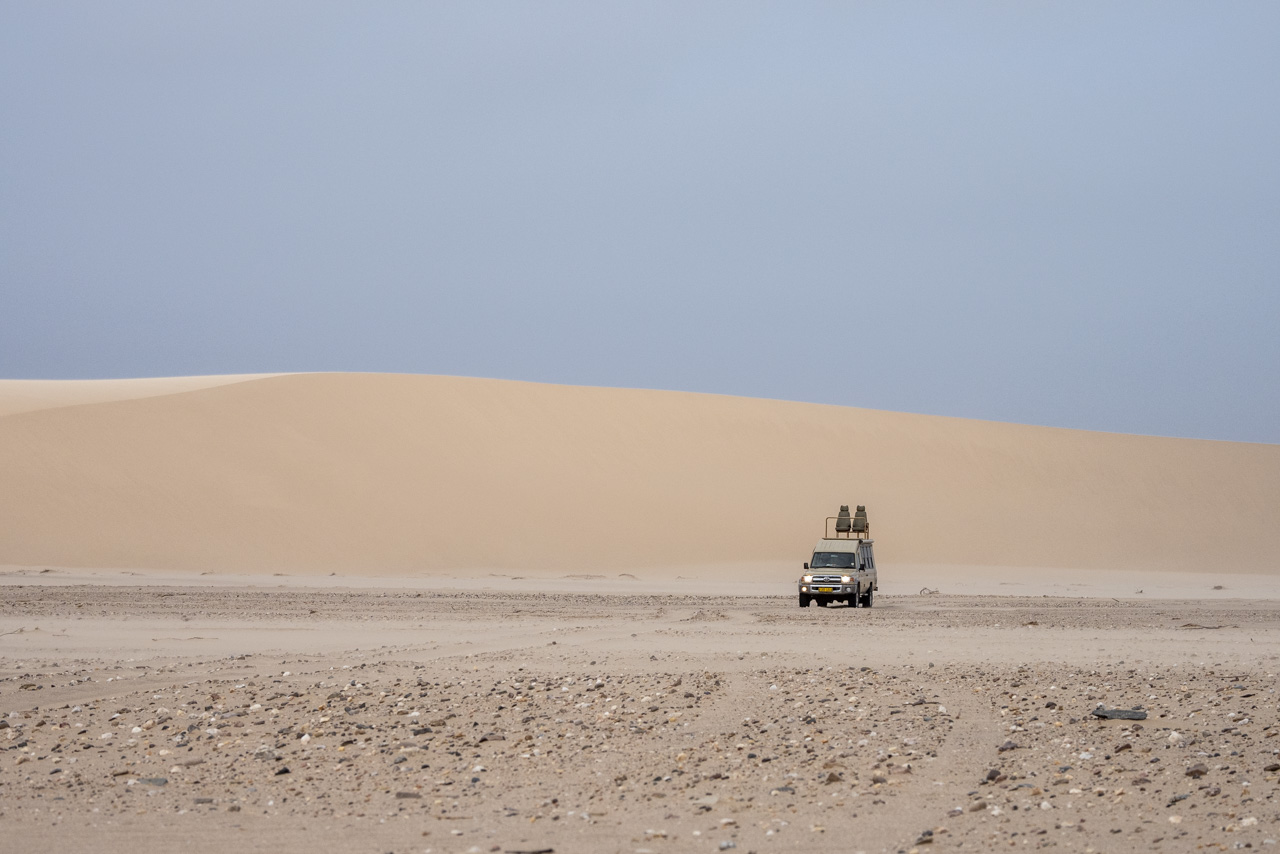
Accommodation
The Skeleton Coast is a special place. Rough, sometimes inhospitable, secluded and majestic, and for that very reason attractive. Shipwreck Lodge is the only lodge within the Skeleton Coast National Park. It is located a few hundred meters inland on the first sand dunes, but the sea is clearly visible and can be reached on foot in about 30 minutes.
Each of the 10 rooms have been constructed to resemble the shipwrecks that line the beach, slightly inclined in the sand and bracing itself against the stiff sea breeze. Large windows allow a clear view of the sand dunes and the sea. The cozy bedroom has wooden ceilings and a warming stove for the cold days. A dressing room with tea/coffee station connects to the bathroom, which is equipped with a double sink, shower, toilet and portholes. All rooms have a sofa, which can be used as an extra bed for a triple, or even as a double bed for families with two children.
The first part of the Skeleton Coast from Swakopmund to the north is open to the public. The Skeleton Coast National Park itself, a 16,845 km² large nature reserve, was founded in 1973 and later linked to the Namib-Naukluft Park via the Dorob National Park.
The southern entrance of the park is located after mile 108 near the mouth of the Ugab River. If you want to enter the park from Damaraland, you have to go through Springbokwater Gate. You have to register in any case, but the permit is free of charge.
Access to the lodge is by light aircraft (charter) to Möwe Bay, followed by a road transfer to the lodge that takes about two hours. This is usually combined with a visit to the seal colony and various shipwrecks as part of a first afternoon activity.
If you are self-driving, please park your vehicle at Möwe Bay where a guide from the lodge will pick you up at 3pm. Only Self-Drivers who continue to Hoanib Valley Camp are allowed to bring their vehicle to to lodge in convoy with the camp's guide at 3pm. There are some deep sandy passages to master and confidence in driving is essential.
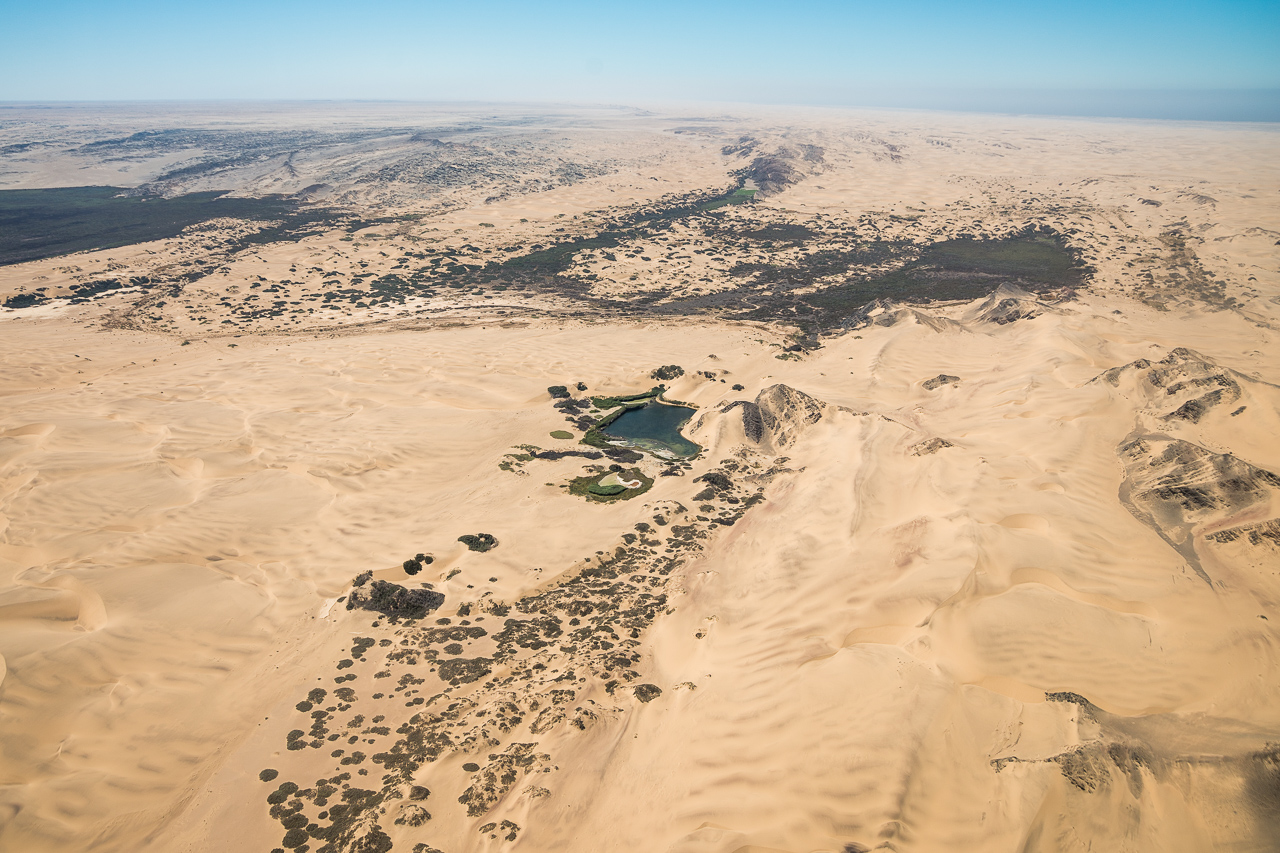
Daytime temperatures in Namibia can, for example in the Namib Desert, reach 50°C during the summer months, but also drop to 0°C at night, which is a massive fluctuation. The coast receives little to no rain because cold ocean currents from the Antarctic (Benguela Current) create offshore crosswinds that prevent clouds from reaching the mainland (similar to the Atacama Desert in Chile). However, this leads to an increase in the formation of fog, making it difficult for ships to navigate.
More than a thousand shipwrecks strewn the length of the coast bear witness to the region’s many tragic events. John Henry Marsh coined the term ‘Skeleton Coast’ in his account of the Dunedin Star shipwreck.
Despite this, there is still an abundance of life along the Skeleton Coast – the ocean is teeming with fish and plankton, which in turn attracts whale. There are also large colonies of seal at Cape Cross, Cape Fria and Möwe Bay, for example, and these attract hyena and jackal.
The first section of the Skeleton Coast, from Swakopmund northwards, is public. The neighbouring Skeleton Coast National Park, a 16’845 km² nature reserve that was proclaimed in 1973, is now joined seamlessly to the Namib Naukluft Park via the Dorob National Park. The southern entrance to the park is at mile 108, close to the Ugab River estuary. A permit is necessary to enter the park. It is possible to drive through the southern part, and most people leave again via the Springbokwasser Gate in the direction of Damaraland. It is forbidden to drive in the northern part of the park, from Terrace Bay to Kunene Mouth, unless you have a very rare tour operator’s permit.
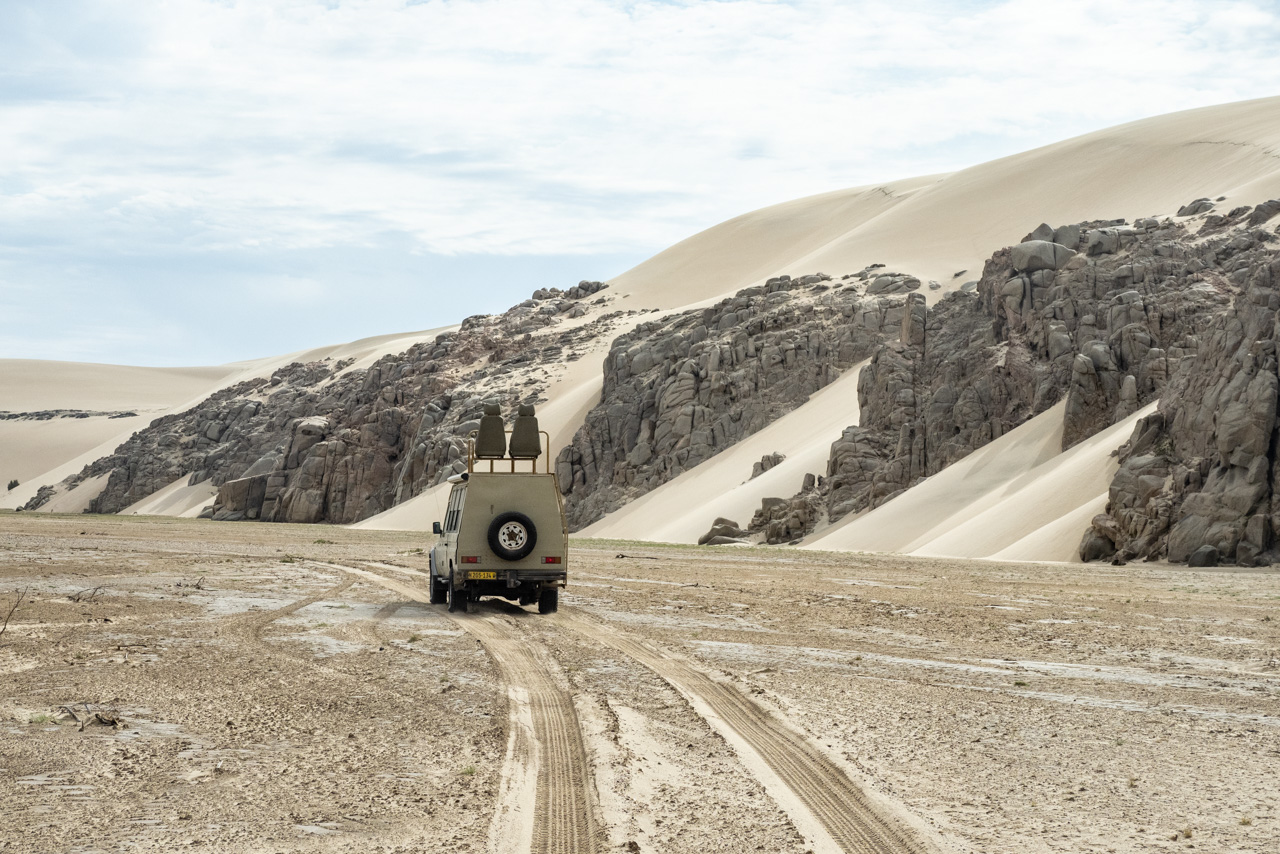

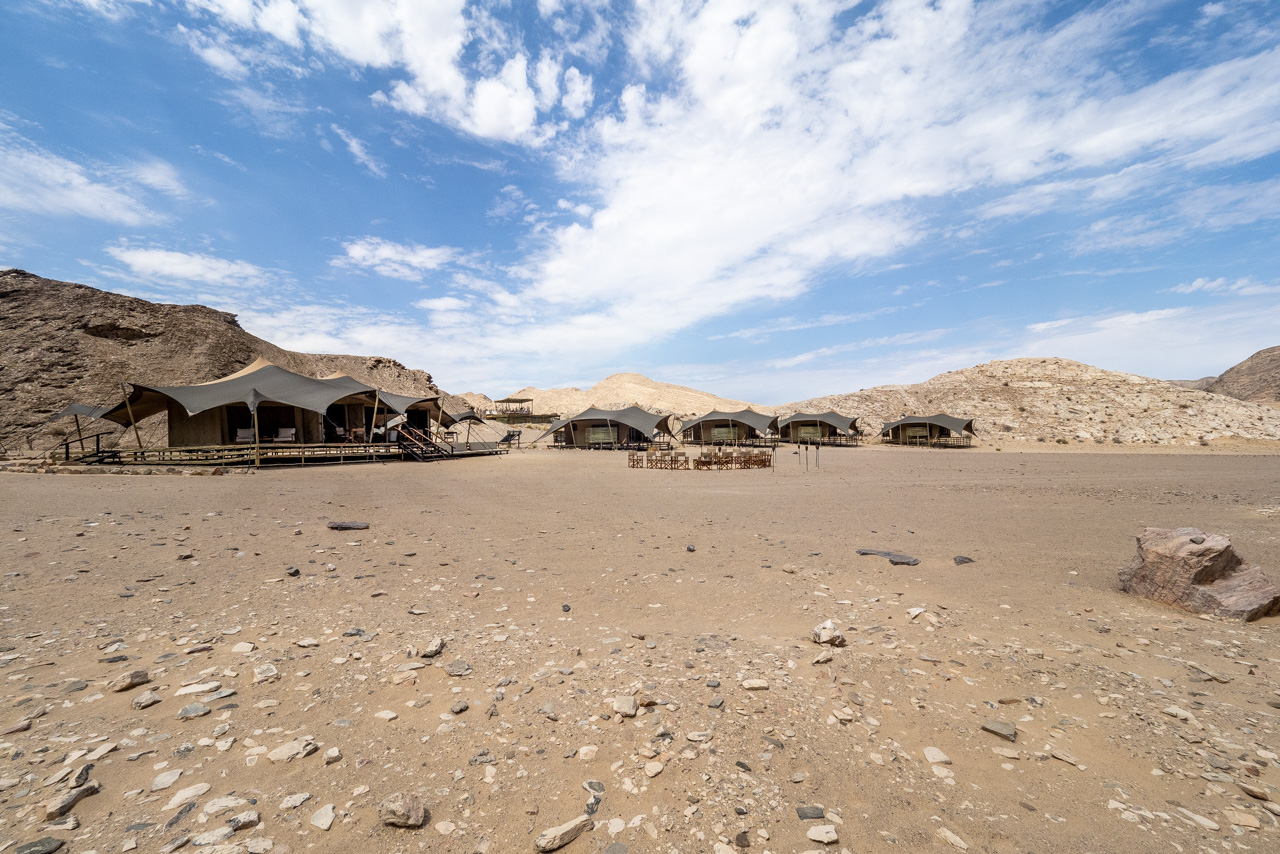
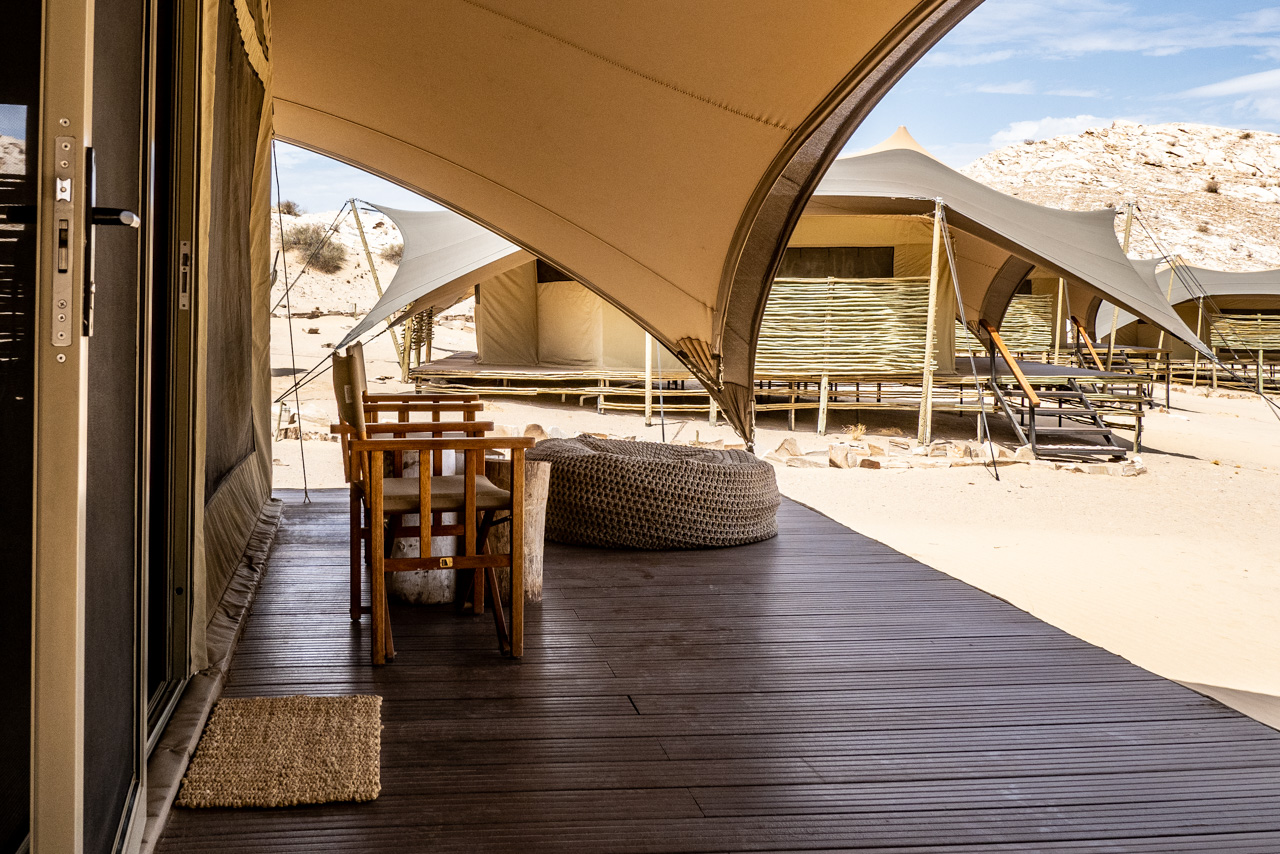
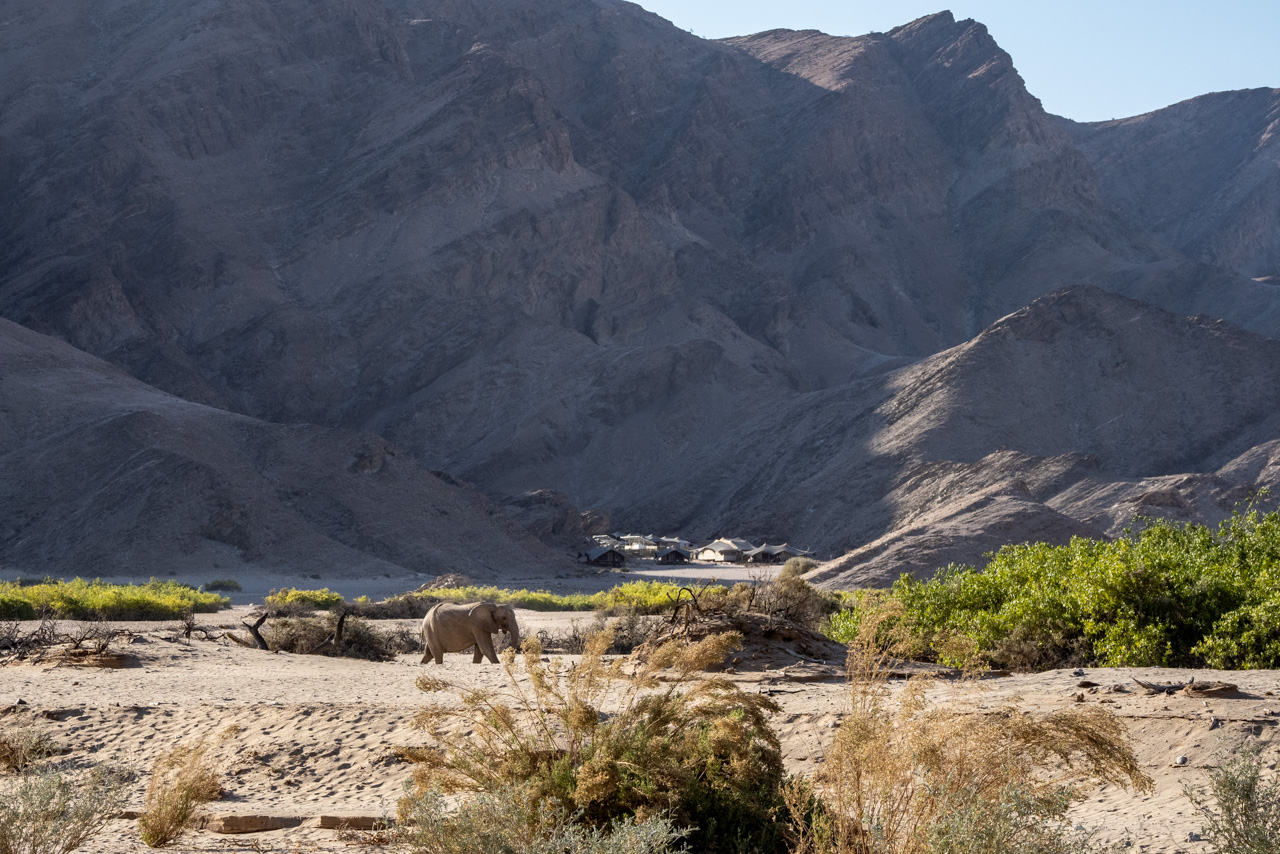
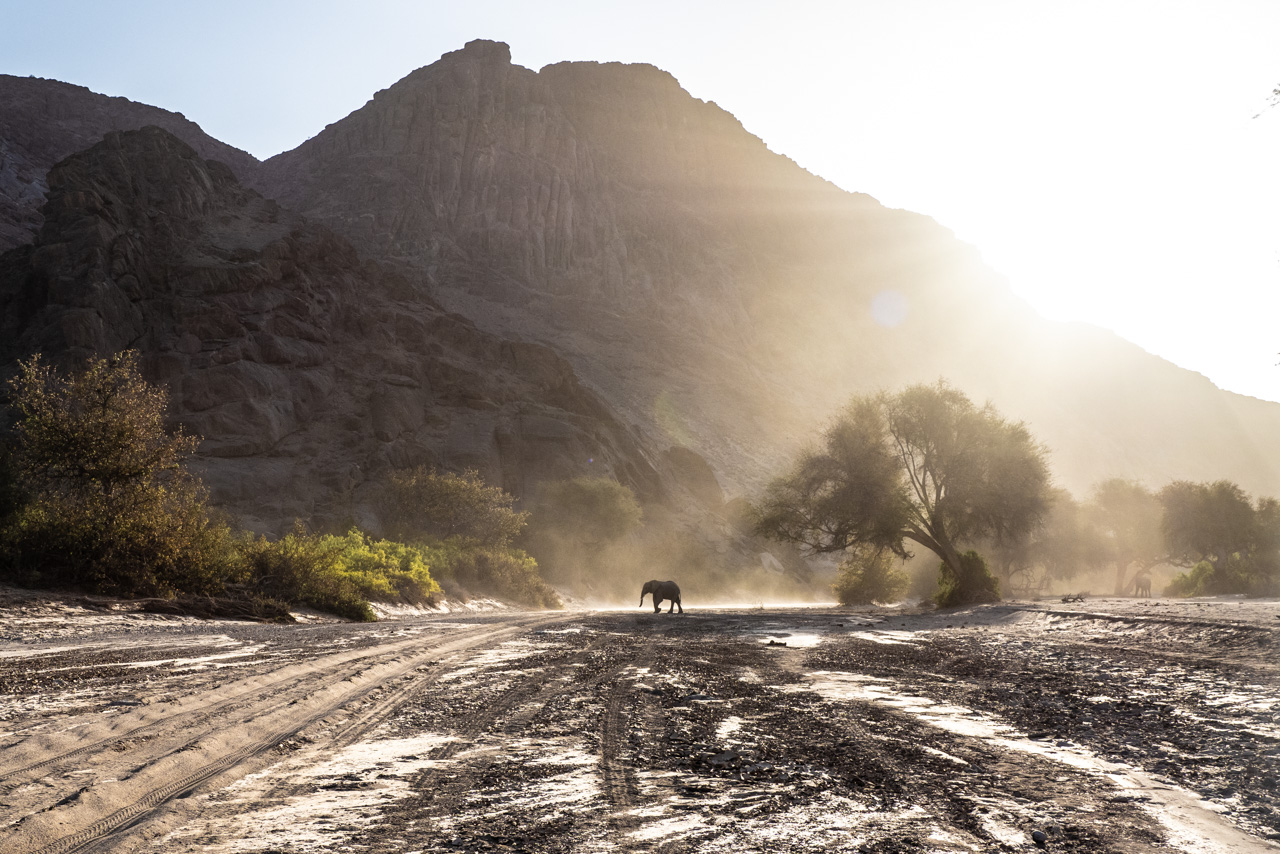
Accommodation Hoanib Valley Camp is a new camp in the Hoanib Valley. It offers six tents with en-suite bathrooms, indoor & outdoor shower and a shaded outdoor lounge. One of the tents is larger and is used for families.
The six guest tents blend almost perfectly into the rugged environment. The colours, textures and patterns are inspired by the experience of the Hoanib; the rich ochre of the dunes, the geometric patterns of the Himba people and, of course, the giraffe that inspired the project.
The camp is a joint venture with the local community and with the NGO the Giraffe Conservation Foundation (GCF).
The area is part of the Kaokoveld, a land of rugged scenery, mountains, vast plains, and dry riverbeds inhabited by incredible desert-adapted plant and animal life.
Self-Drivers can either drive to the camp from Sesfontein (4 x 4 required) or leave the vehcile at Sesfontein at a secure parking. The camp organizes transfers, leaving Sesfontein at 3pm and departing from camp at 09 am.
Flights are planned from Windhoek to Fort Sesfontein, and down to Shipwreck Lodge.
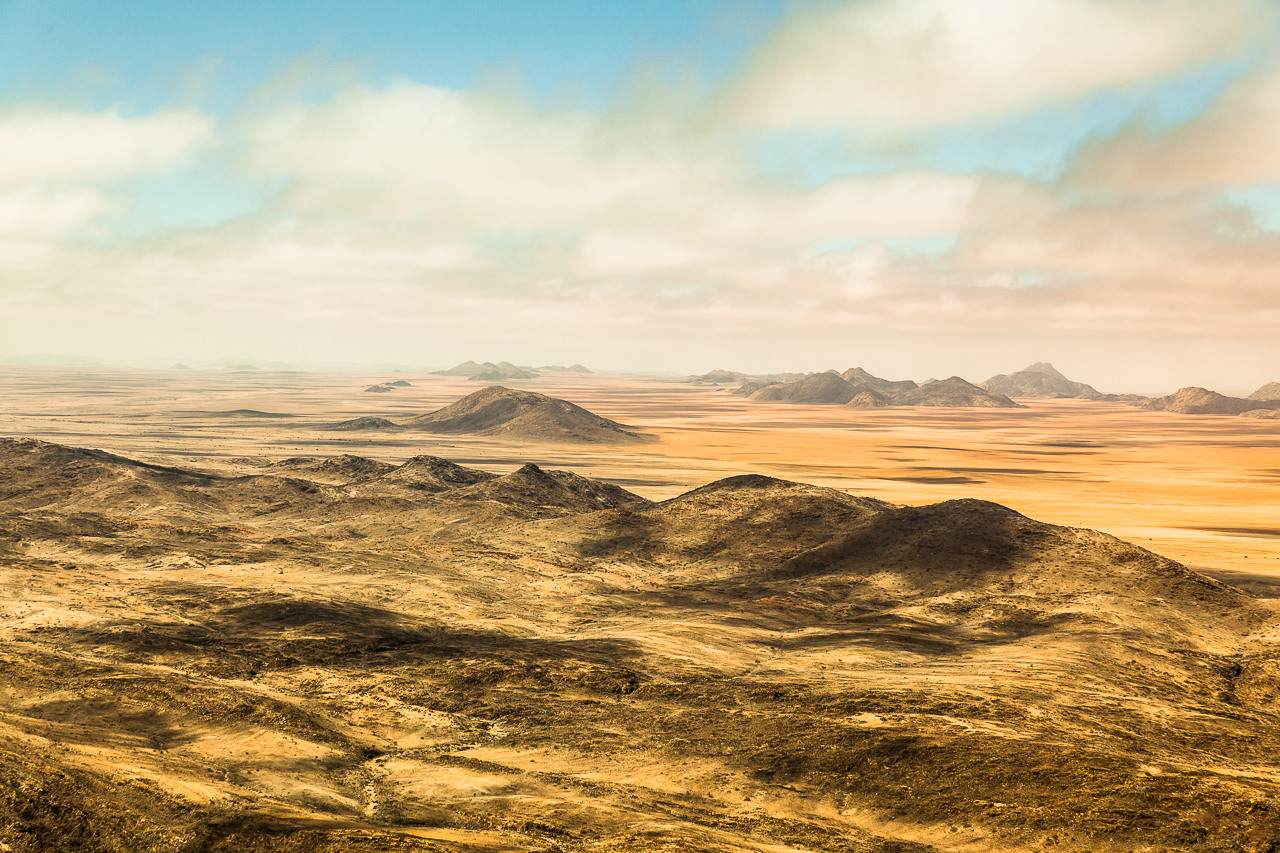
The Kaokoveld covers an area of around 50’000 km², and includes the region between the Hoanib River and the Kunene River, which marks the Angola border; the Skeleton Coast National Park marks the western border. There is little to no infrastructure here, which means the Kaokoveld is one of the few true wildernesses still in existence. The few people you’re likely to come across in this region are the semi-nomadic Himba, who have learned to survive in this sometimes extremely arid environment.
The western part of the Kaokoveld, from Sesfontein up to the Epupa Falls, is less interesting for us. We stick to little-known tracks in the hinterland and never travel on tarred roads in the Kaokoveld. Riverbeds are our roads and the starry sky is the roof above us.
If you like a combination of camping in remote places and staying in beautiful lodges, then our Kaokoveld Expeditions are perfect for you. Not only is the landscape fascinating here, we also often come across desert elephant, giraffe, zebra, oryx and sometimes even lion and rhino. This is one trip you will never forget.

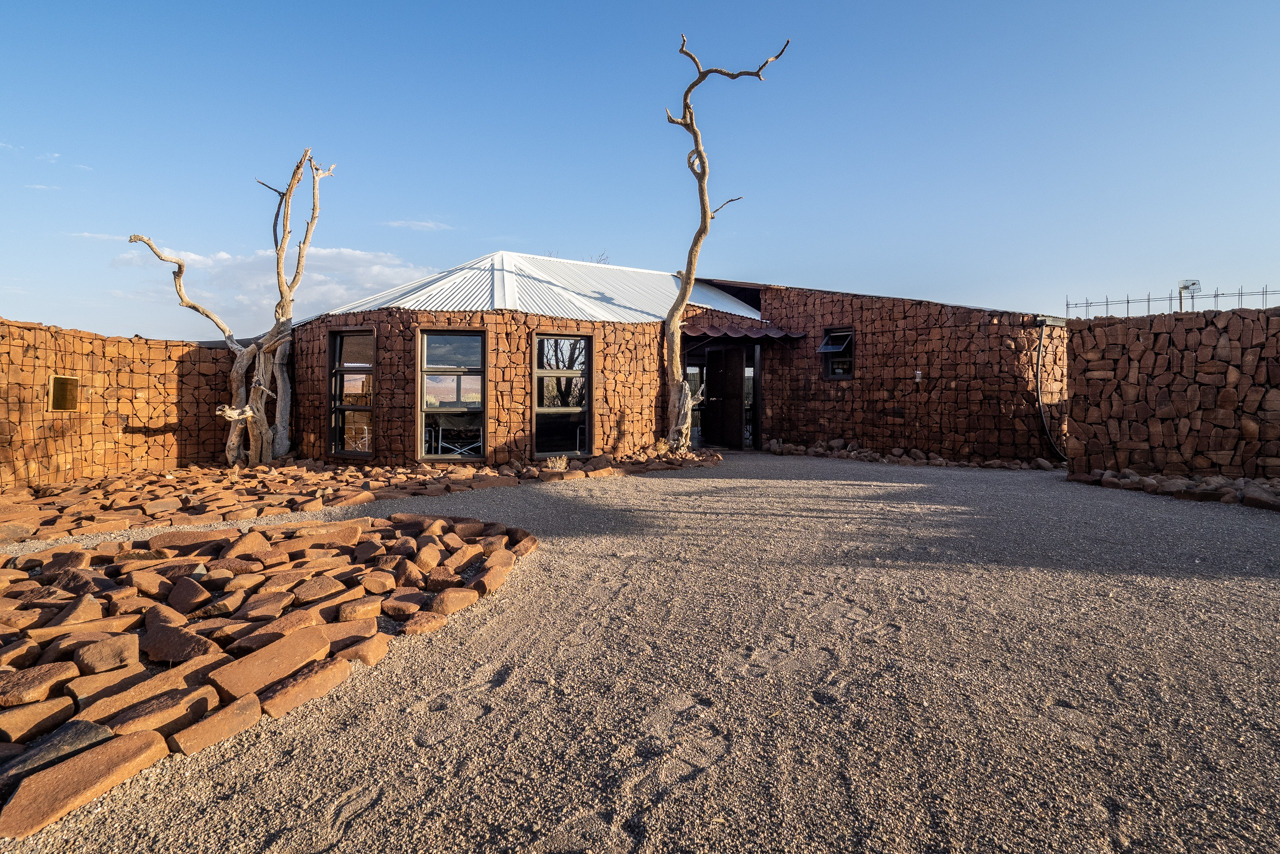
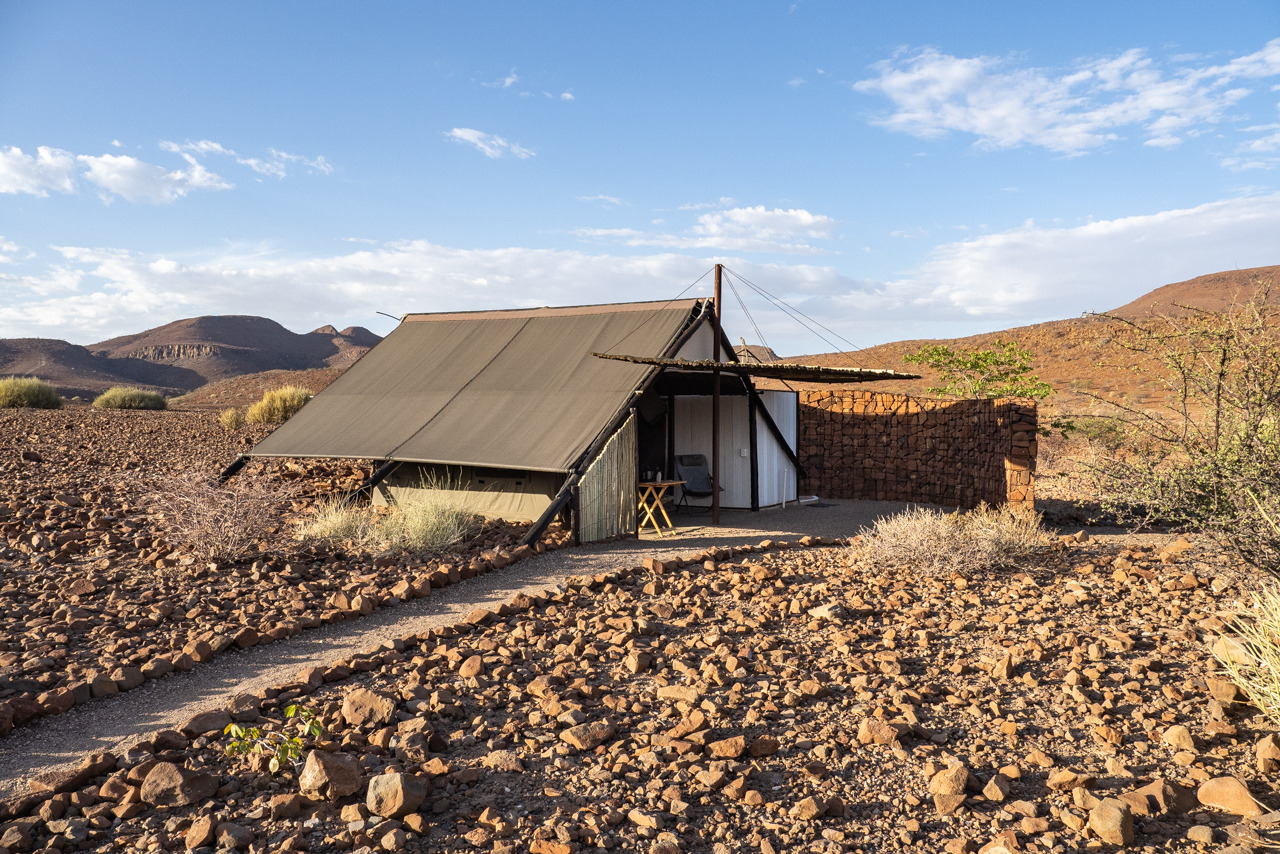
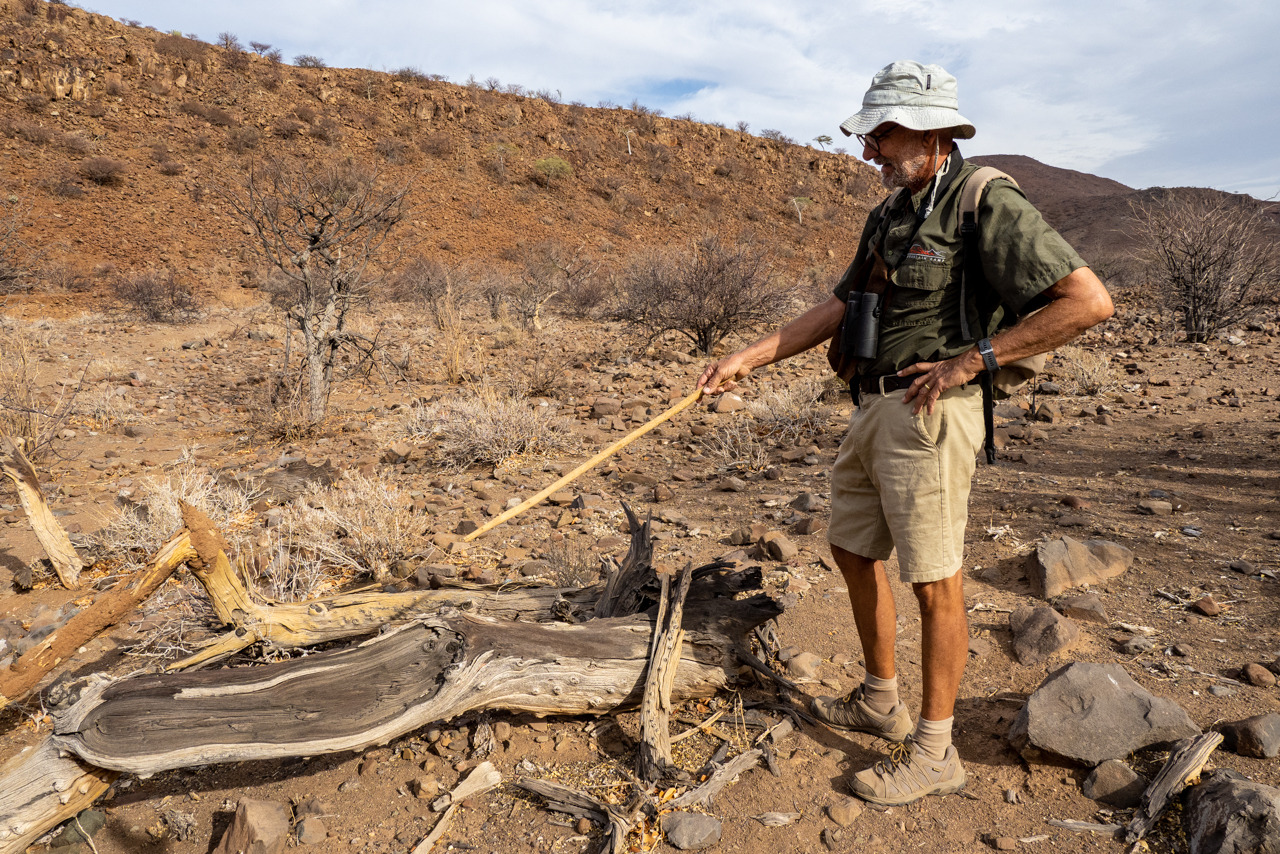
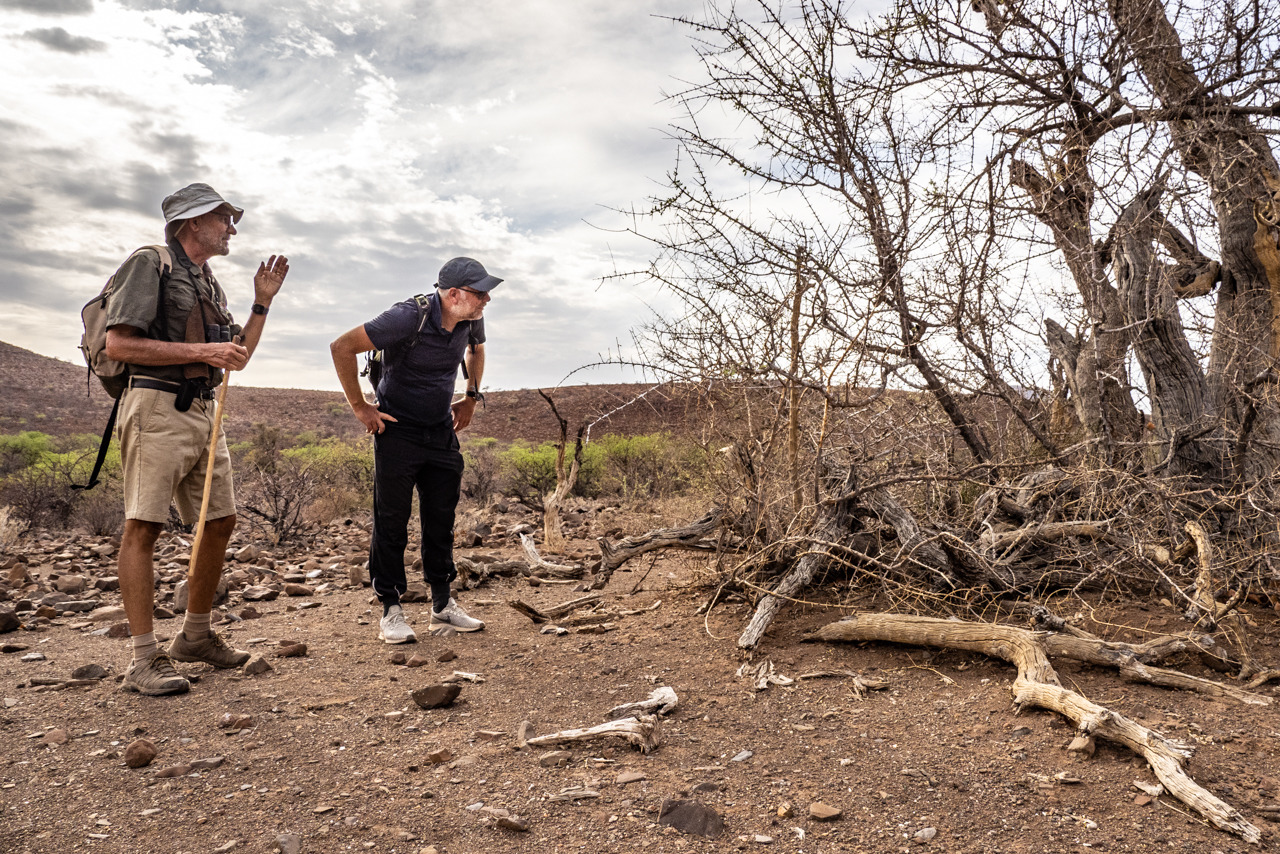
Accommodation
At Etendeka Mountain Camp everything revolves around the fantastic environment and its preservation. Nature is the main focus; the camp is kept simple and functional without sacrificing atmosphere and comfort. The food is delightfully fresh and is partly prepared on the open fire - nowhere in the world does it taste better than beneath the starry African sky.
Ten guest tents with outdoor bathrooms, bucket showers (hot and cold) and great mountain views serve as accommodation. Owner Dennis and his guides pass on their passion to their guests in a relaxed and honest way. The entire camp is solar powered; if you are looking for an eco-lodge worthy of the name, it is Etendeka Mountain Camp.
The two simple but charming walking camps (Etendeka River Camp and Etendeka Hill Camp can be visited as a stopover on a longer hike. Camp beds with duvets and pillows are placed on covered platforms and offer some basic comfort. A private bush shower and toilet are part of your «room» under the stars. The roof can be removed for an unobstructed view of the starry sky.
Self-drivers park their rental vehicle at Palmwag Lodge and are picked up at 4pm for the 18km trip to camp. The transfer takes about 1.5 hours.
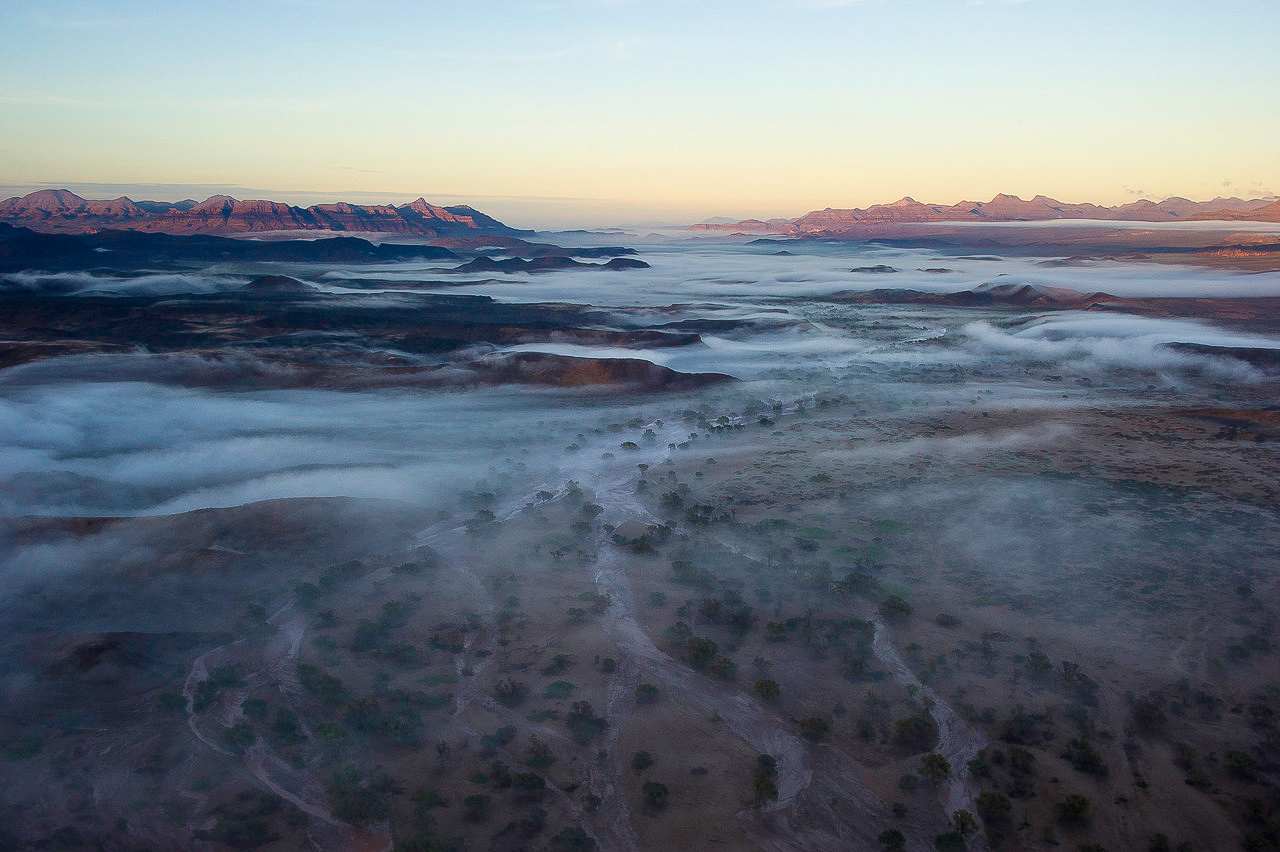
Famous formations include Namibia’s highest mountain (Königsberg in the Brandberg Massif, 2606 m), the Vingerklip (a rock needle) and the Spitzkoppe (Namibia’s 700 m high Matterhorn). It is also well worth visiting Twyfelfontein to see the world-renowned rock engravings – a little touristic, but also a World Heritage Site.
The remote west of Damaraland is particularly interesting. It includes the Palmweg Concession with its abundance of rhino, and the Torra Conservancy, which is also a haven for desert elephant.
Fog often forms over the cold water of the Atlantic at night, carrying much needed moisture to plants up to 20 km inland. Depending on the time of year, the fog disappears again shortly after the scorching Namibian sun rises. The densest fog can be found along Skeleton Coast during the winter months; the best weather can be found here from November to March (hot season).
Various rivers flow from east to west through Damaraland, but they are mostly dry and only flow during the wet season. The main rivers are called Huab, Ugab, Uniab and Koigab. The edges of these river valleys support trees such as mopane, camel thorn, ana tree and various shrubs, which in turn attract a list of animals from the surrounding area, including desert elephant, which has adapted to the region’s harsh and barren conditions. Other wildlife that can be spotted here includes oryx (gemsbok), kudu, Hartmann’s mountain zebra, giraffe and springbok. Visitors can also, but rarely, catch sight of lion, leopard and very shy rhino.
We love Damaraland because of its beautiful landscape. Spotting wildlife, such as desert elephant, just makes it all the more beautiful.

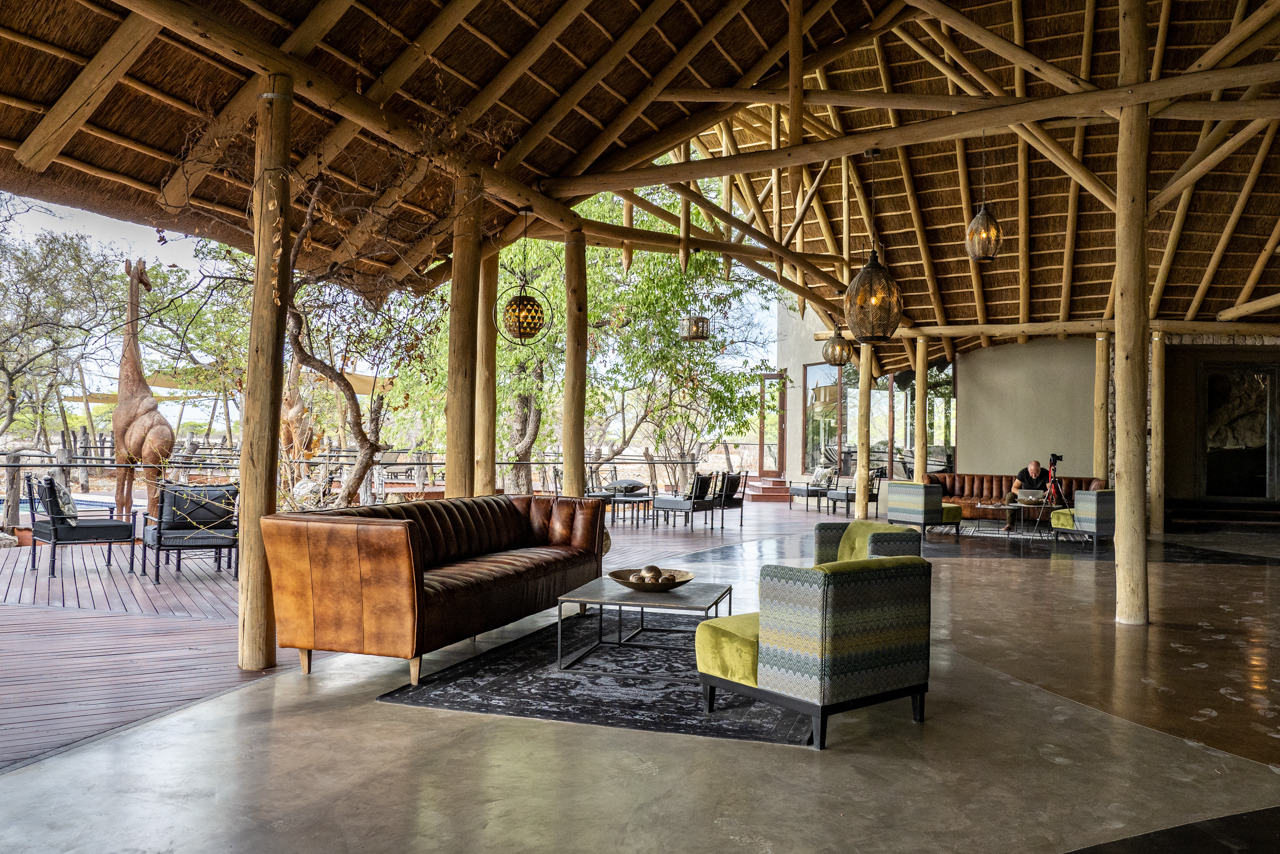
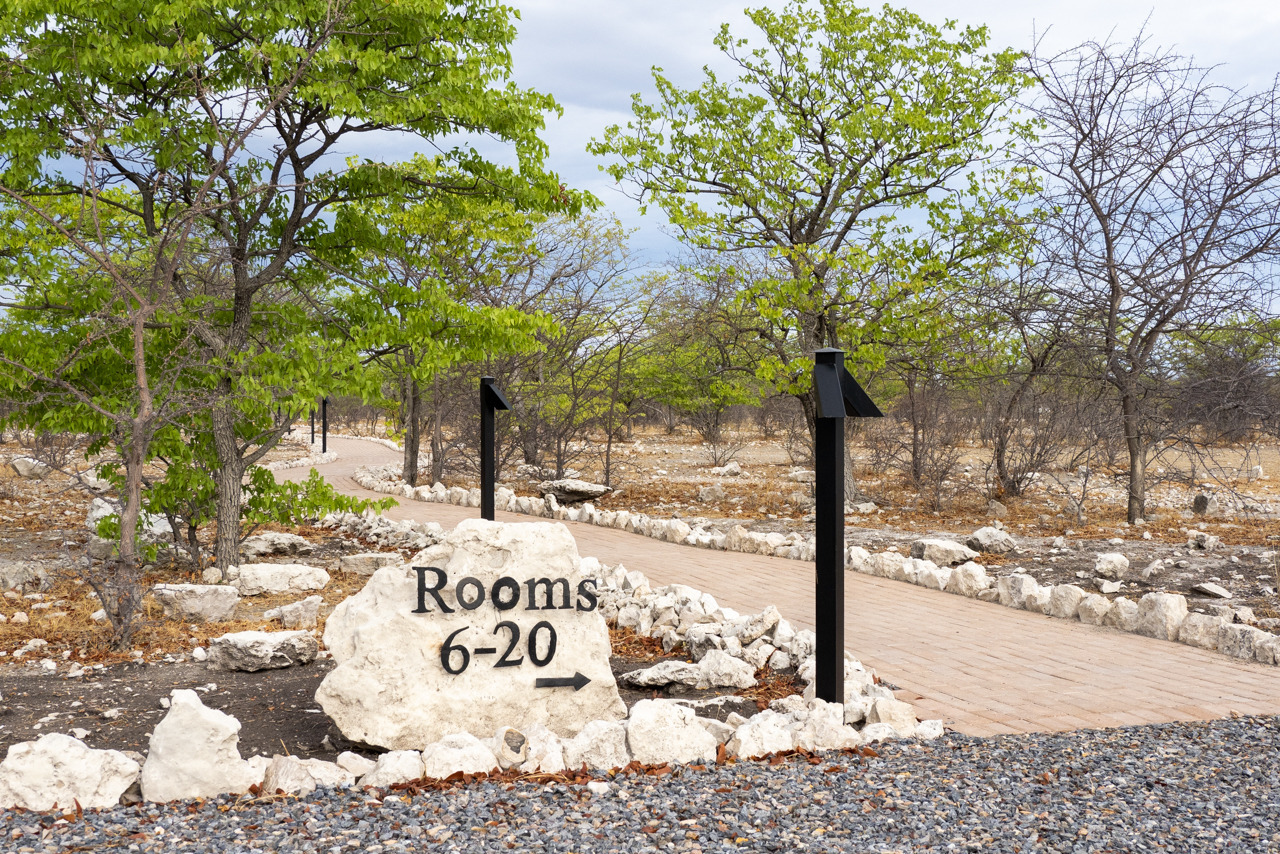
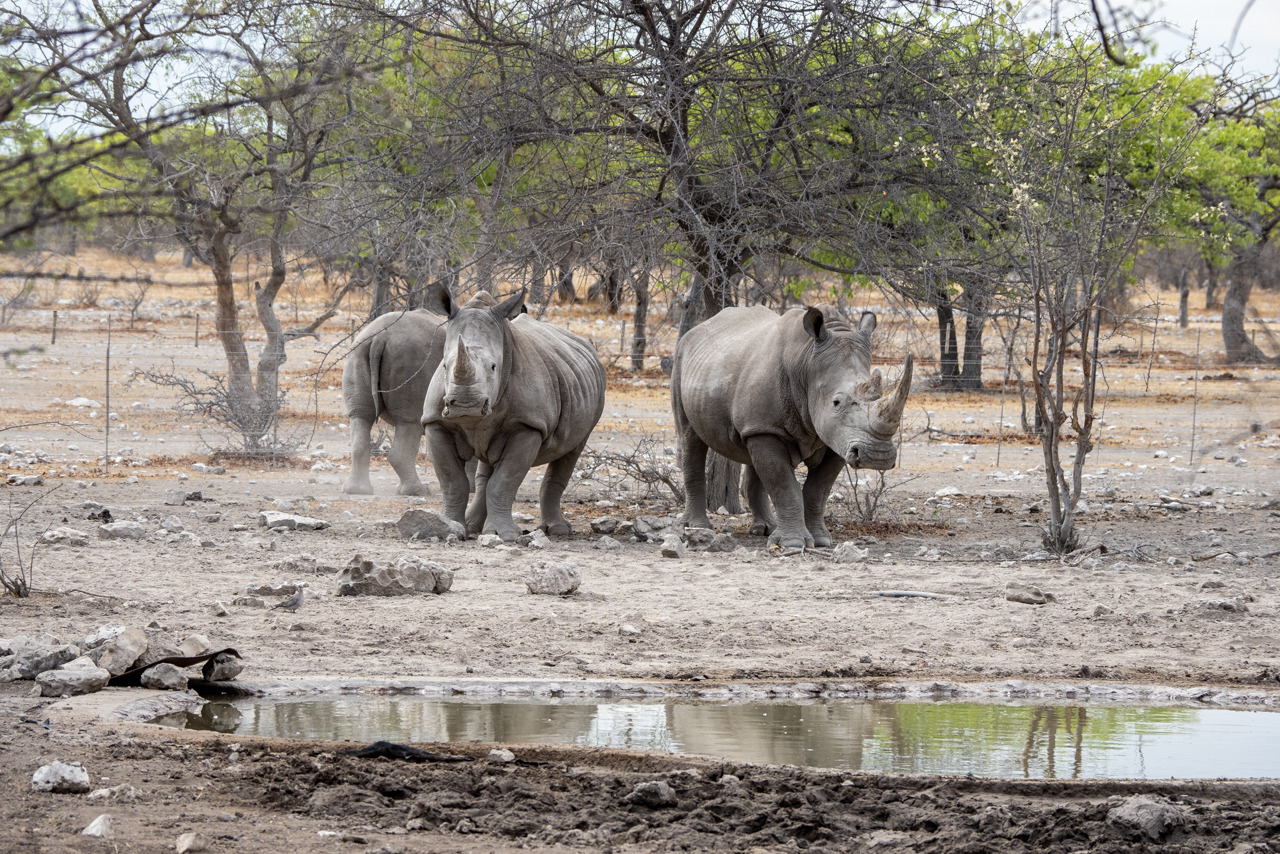
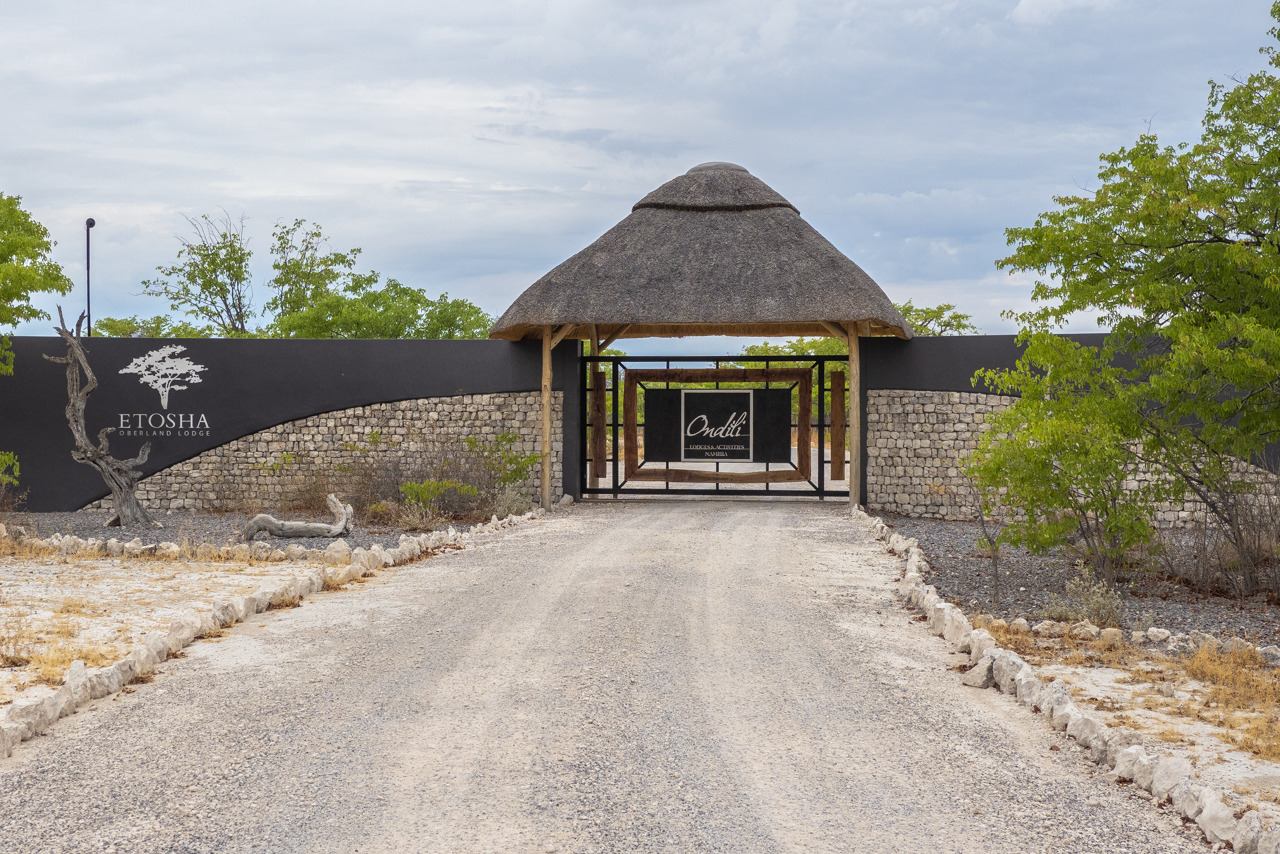
Accommodation
Etosha Oberland Lodge offers an ideal base for exploring Etosha National Park. The lodge is designed in a modern safari style and offers 20 tent chalets that are pleasantly private and spacious. Each guest unit has an ample bathroom, an open lounge and private seating area as well as air conditioning, fridge and coffee/tea making facilities. The required power is generated by the lodge‘s own solar system. There are also three family rooms with an extra bedroom.
The main building of Etosha Oberland Lodge is surrounded by tall mopane trees. The restaurant and its terrace offer views of the waterhole, where animals may pass by anytime. Other amenities include a swimming pool, bar and a spacious lounge area with various sofa corners where guests can relax after their safari. The curio shop exclusively offers products by artists from Namibia.
Wifi both in the main building and in the rooms.
The Etosha National Park is one of the most important nature reserves in southern Africa. It exists since 1907 and covers an area of 22,270 km². The central and eastern sections consist mainly of various silvery-white shining salt pans, which have made Etosha famous. In the dry season the park, the animals and the vehicles are covered in a whitish haze of salt dust.
On the southern shore of the huge Etosha Pan (130 x 50 km) there are several waterholes, which magically attract the animals from the surrounding area during the dry season. The three large state camps Okaukuejo, Halali and Namutoni connect Anderson's Gate in the south with the von Lindequist Gate in the east. The western part towards Galton Gate is much more wooded and less frequented by visitors, but it also offers less trails to drive around and find wildlife.
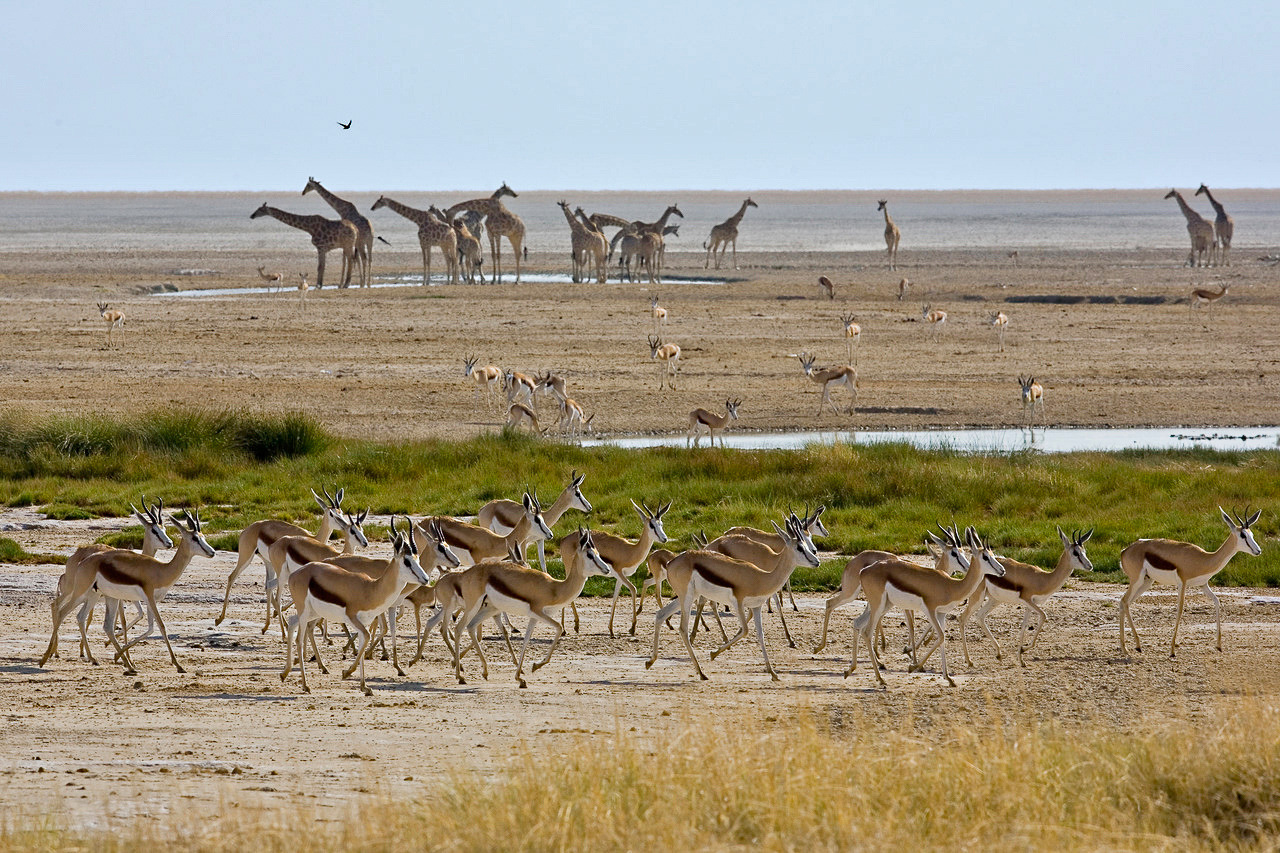
The park thrives mainly on these artificial waterholes, which attract countless animals in the dry season. With the onset of the rainy season, the animals are much less dependent on these waterholes and more difficult to find. The Etosha Pan itself can then contain up to 10 cm of water, and the park becomes more exciting for birdwatchers.
There are a few government camps in the park itself, most of which offer a less favourable experience. The good accommodation is located outside the park in private areas, in the east these are Mushara and Onguma, in the south it is the private Ongava area.
Namutoni and Okaukuejo are the two main camps at the eastern Von Lindequist Gate and the southern entrance to Etosha at Andersson's Gate respectively. The quieter Halali Camp is situated between the two. The state camps are very large and offer chalets, campsites, petrol stations and large picnic areas. If you are looking for a private experience, this is certainly not the place for you. Most of the roads run between these three camps and lead visitors to the various waterholes.
The western part of Etosha opened to visitors in 2011. This part of the park is very different from the area around the Etosha Pan, it has many more bushes and trees, less traffic, but also less to see.
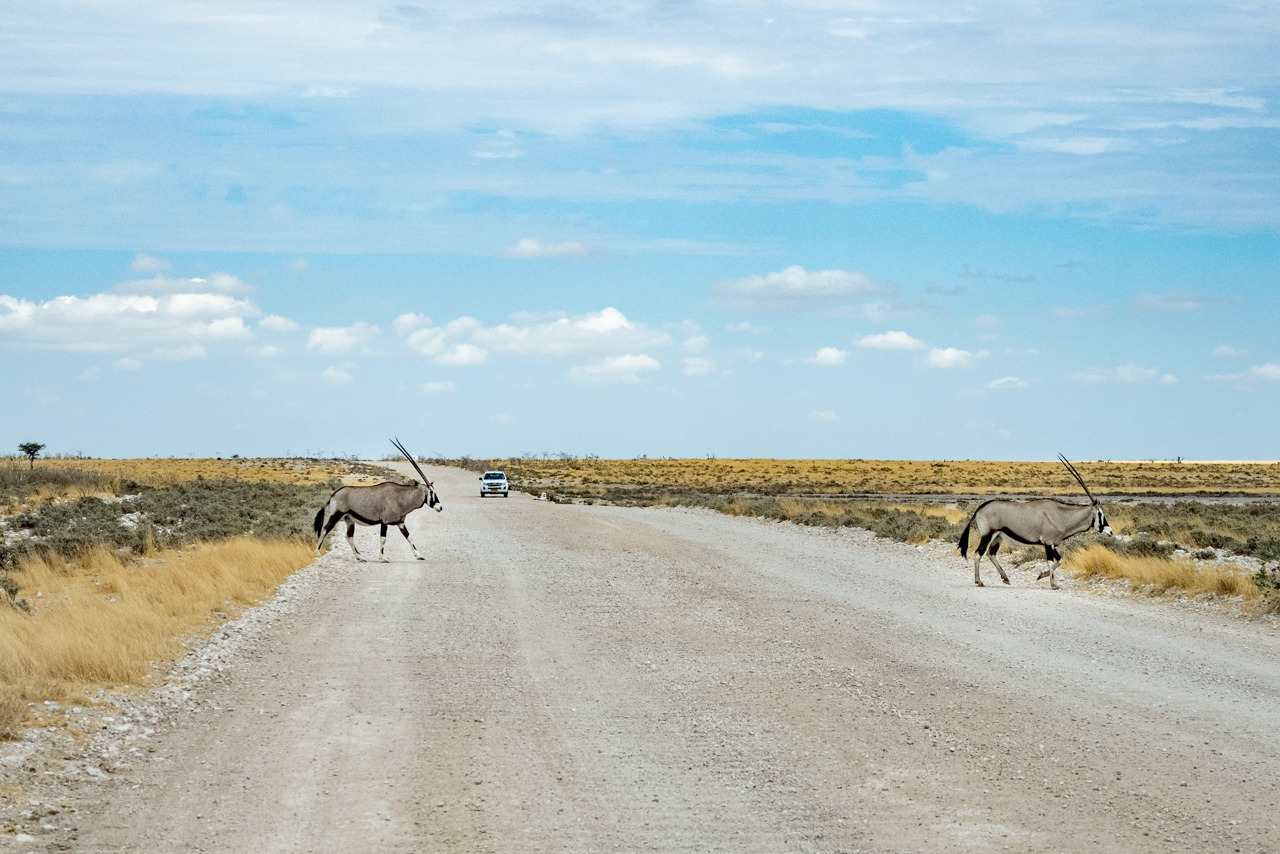
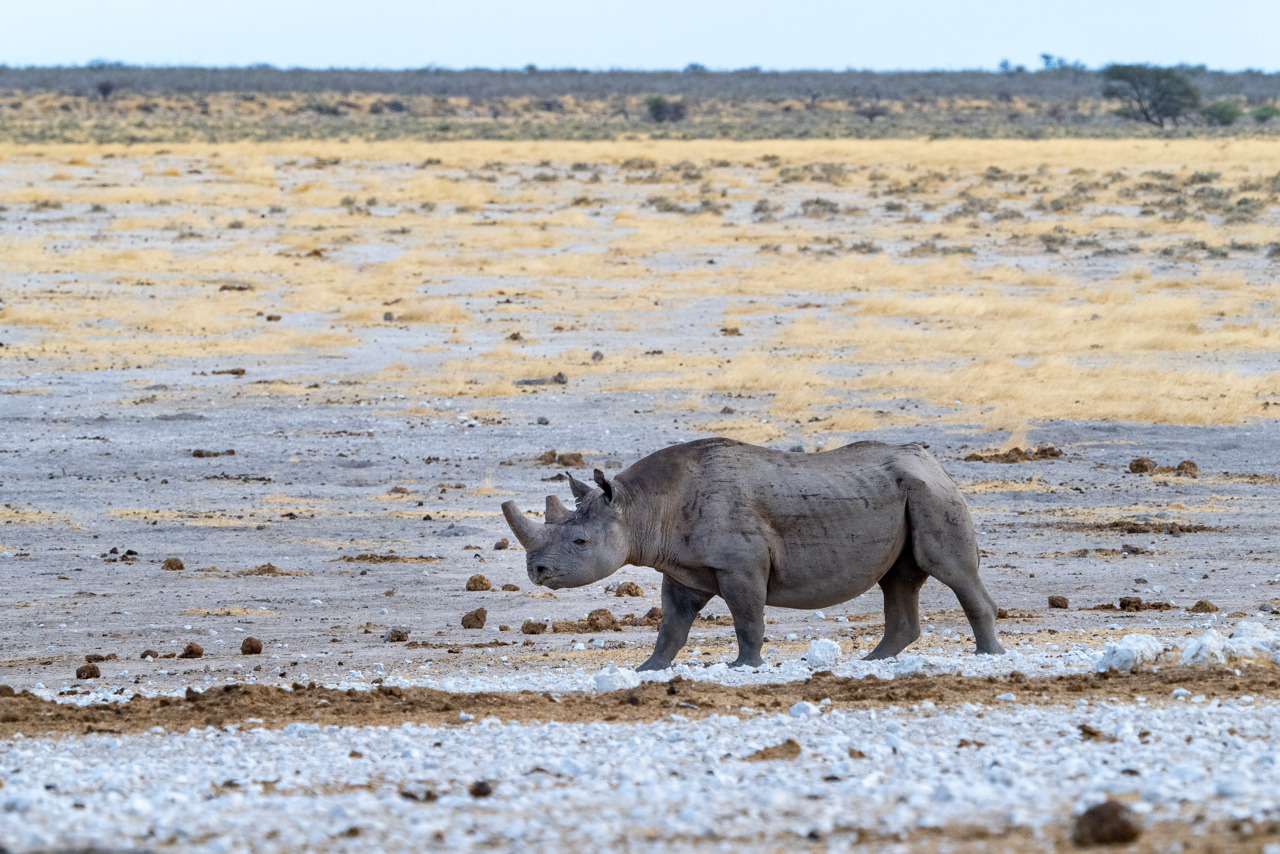
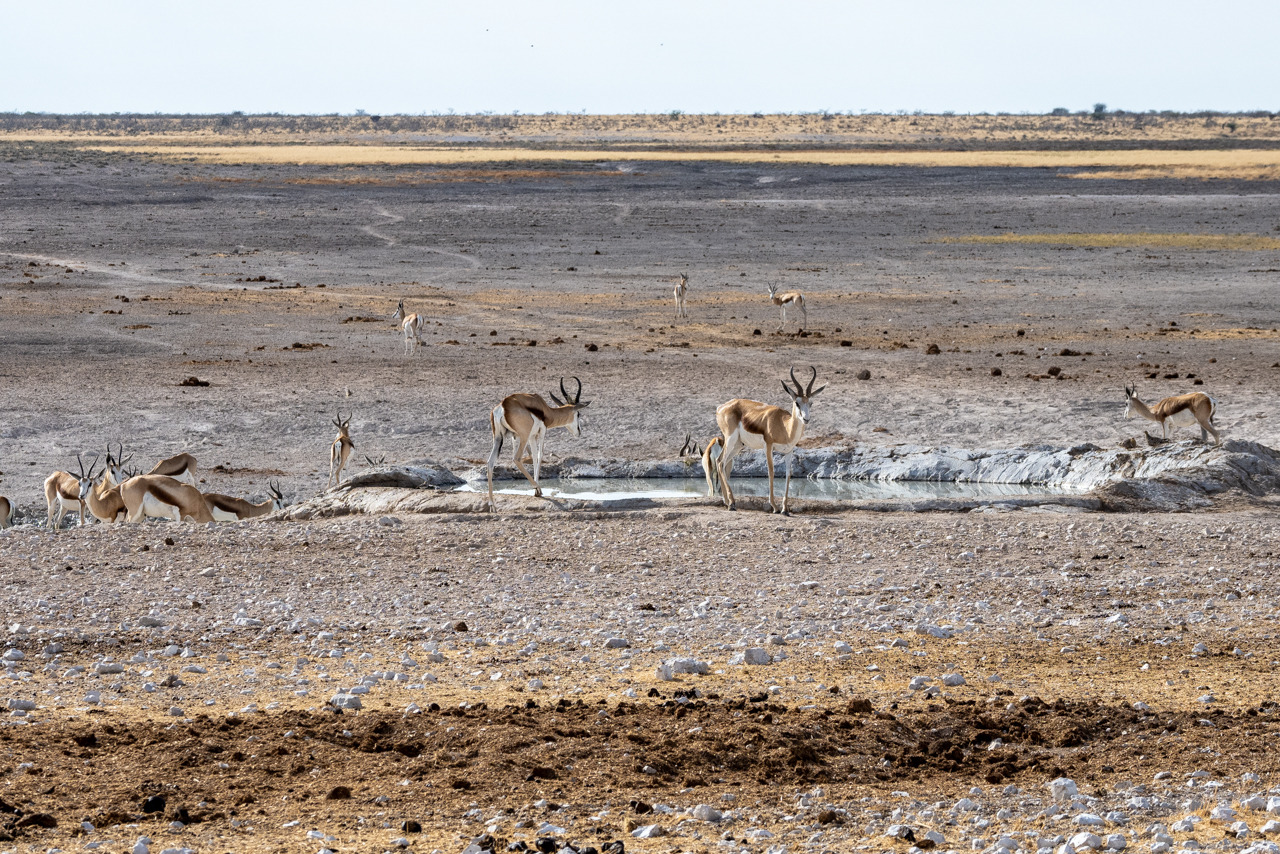
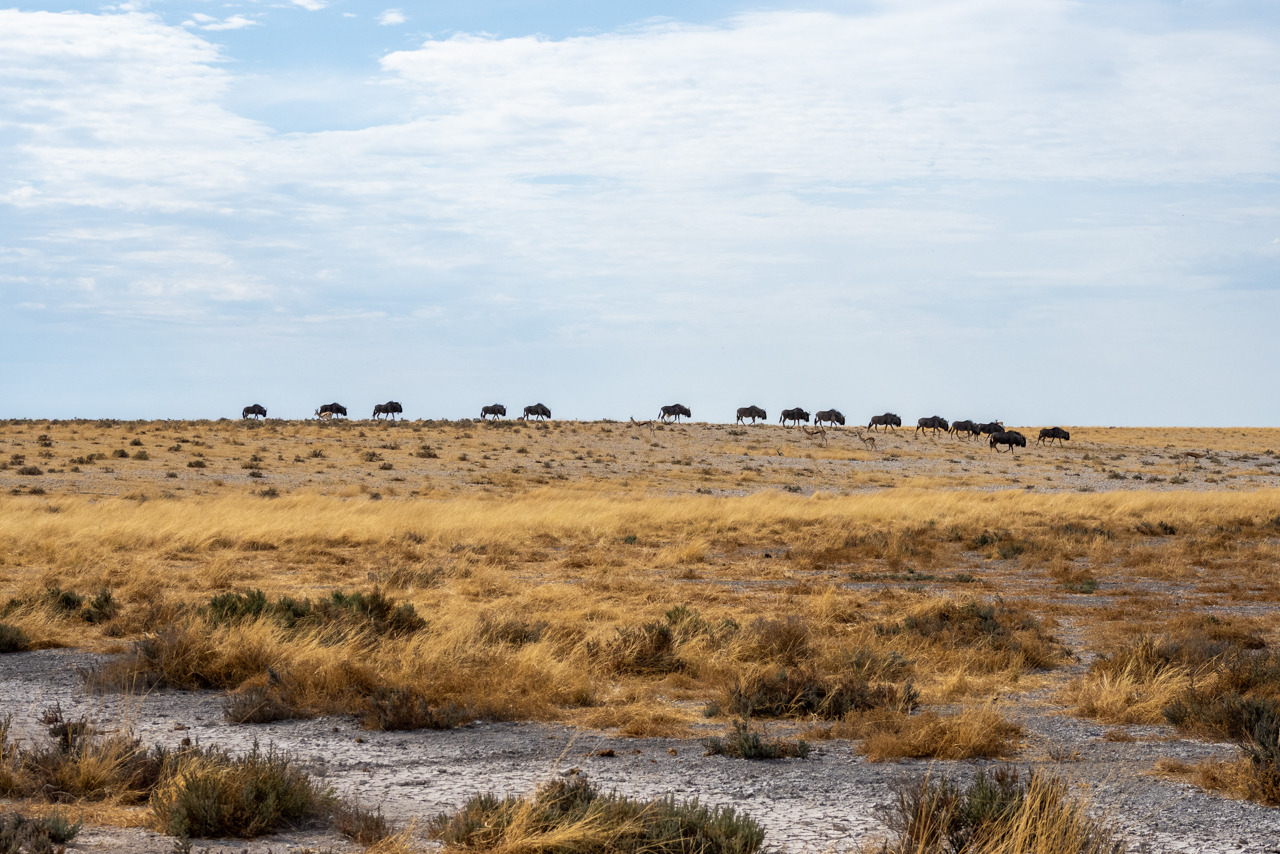
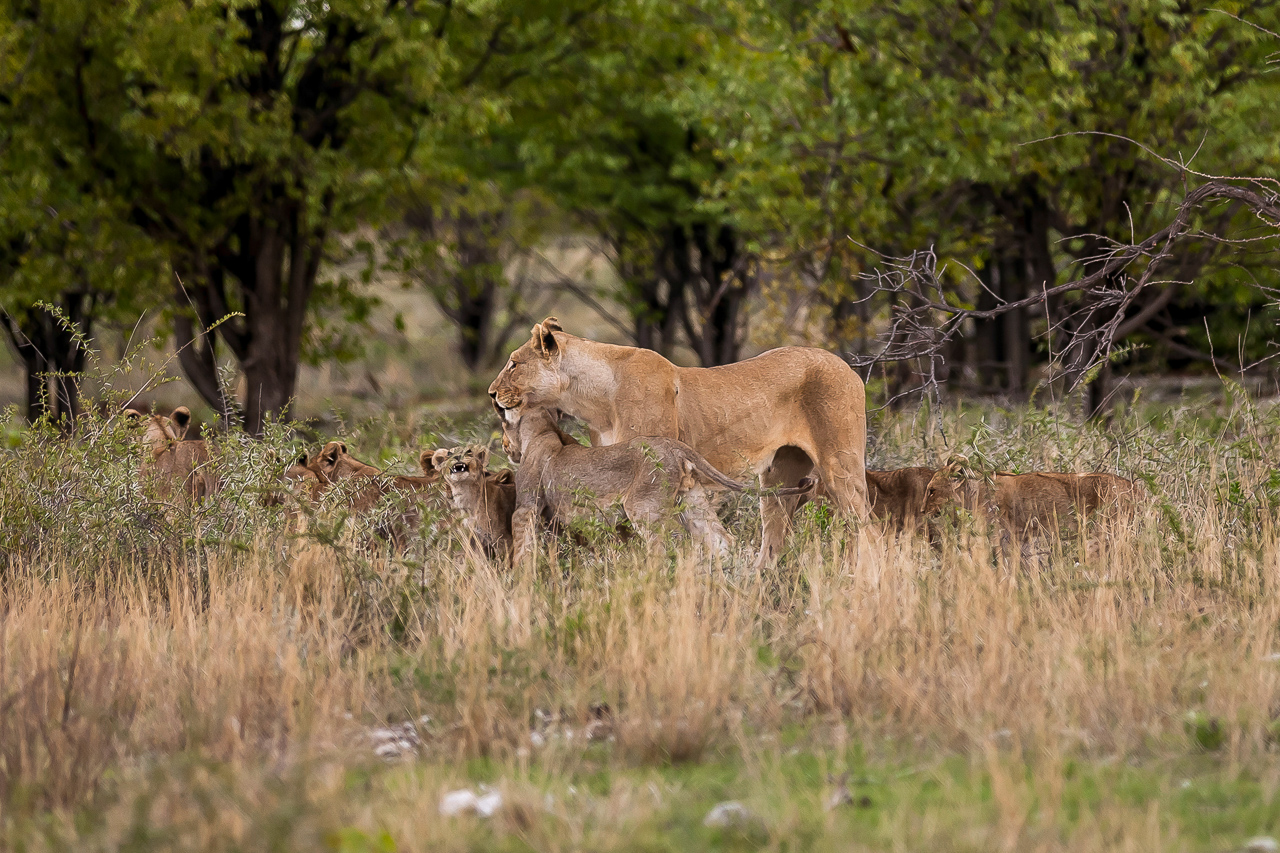
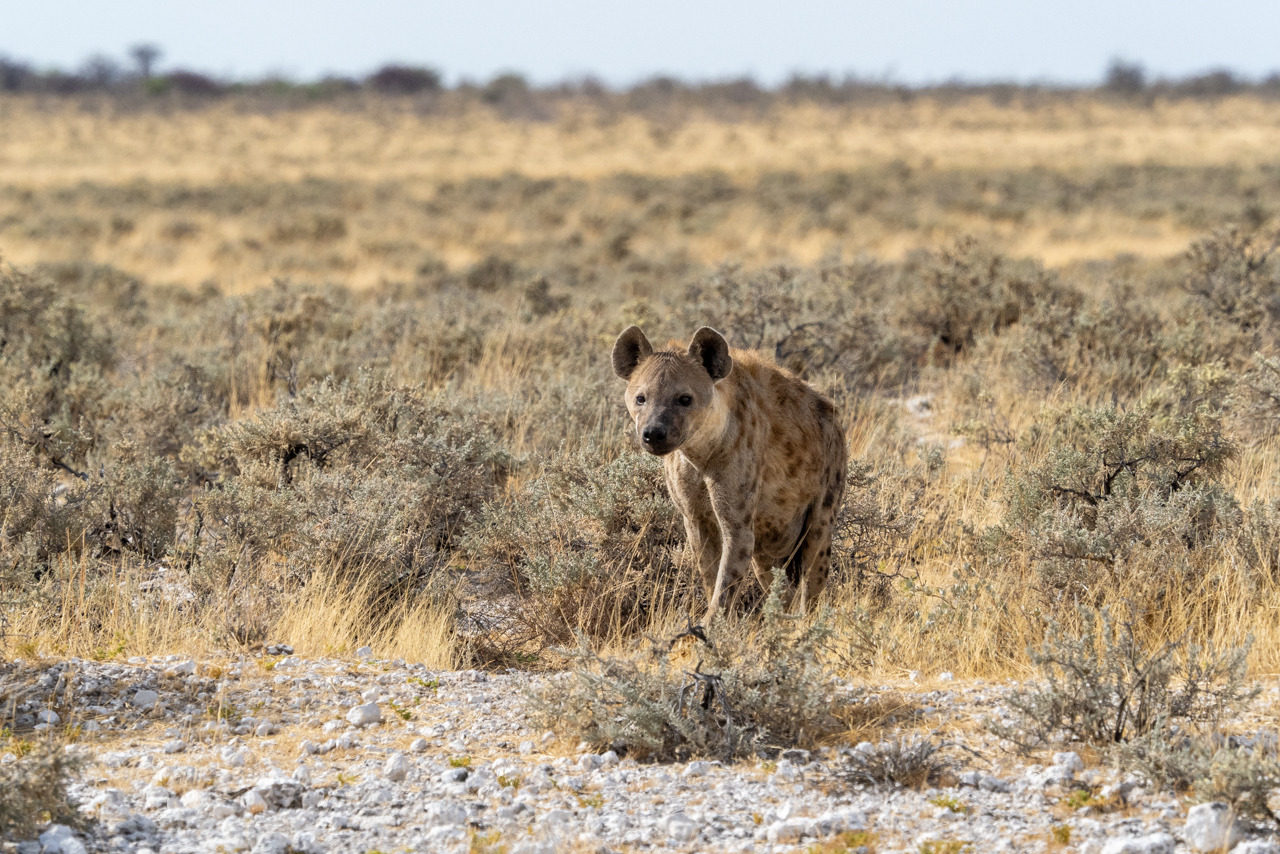

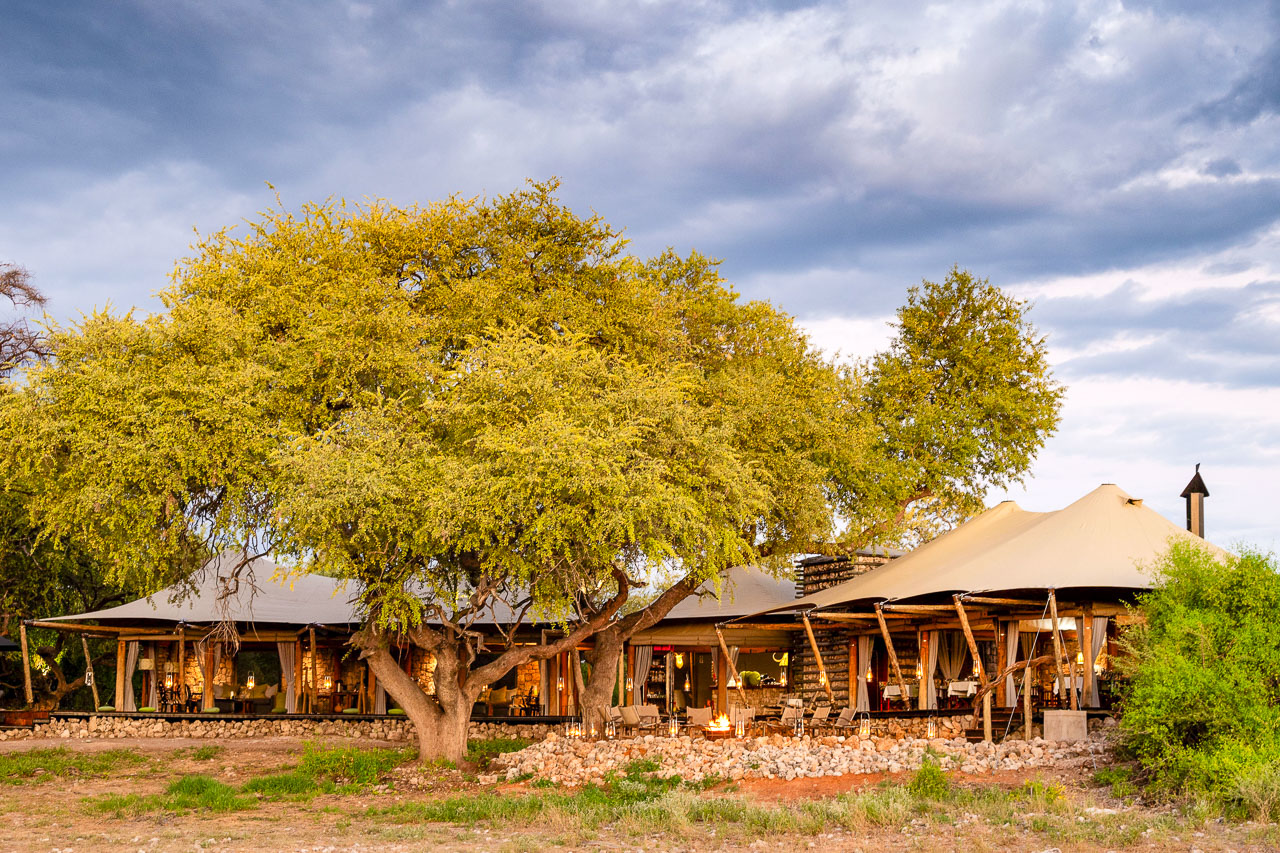
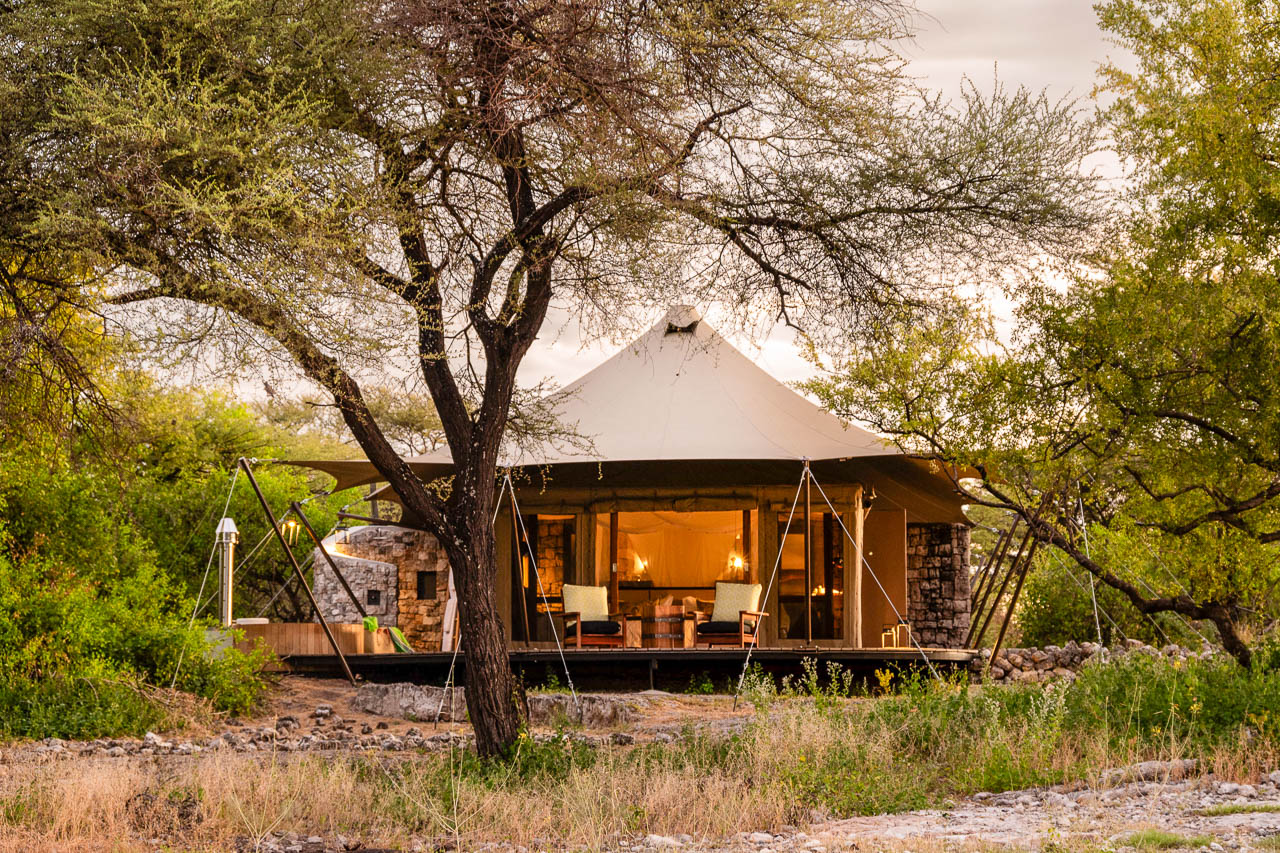
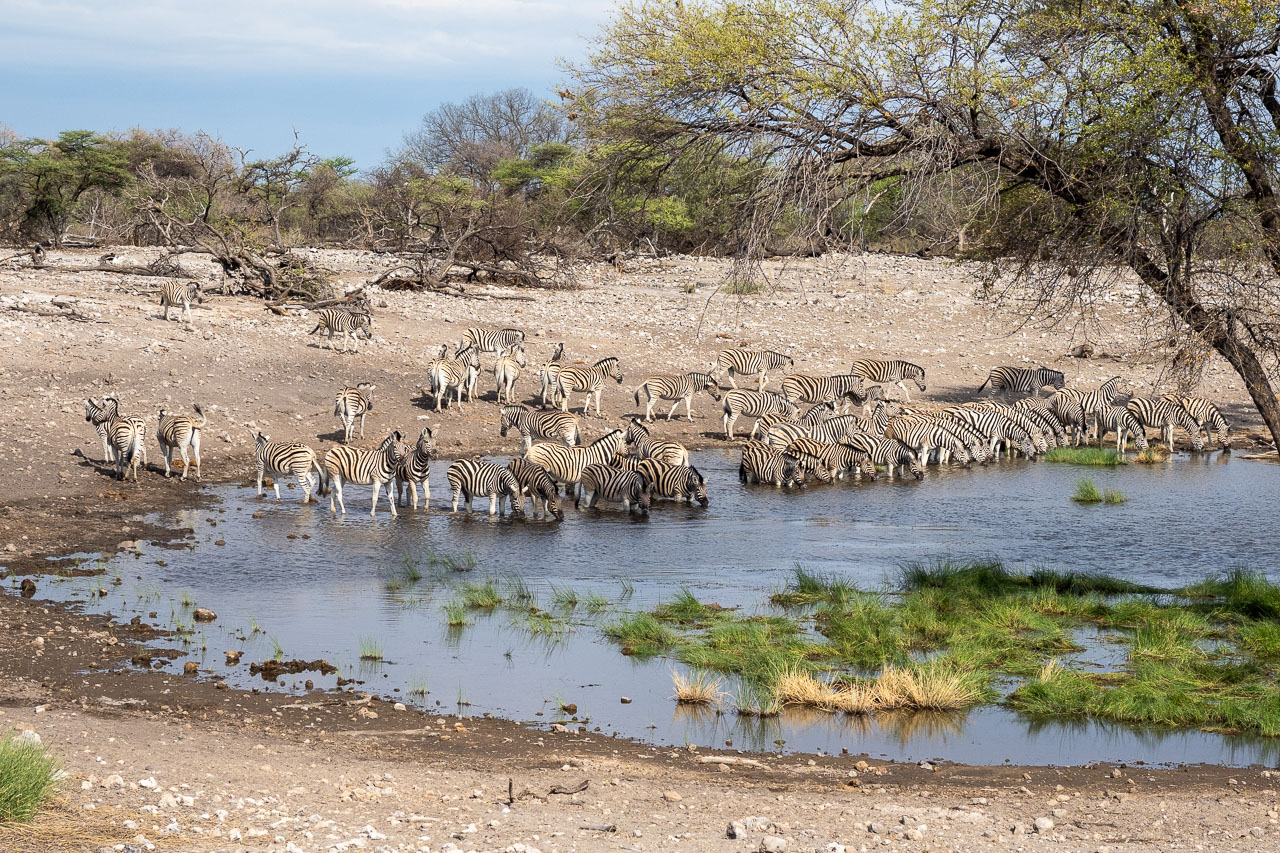
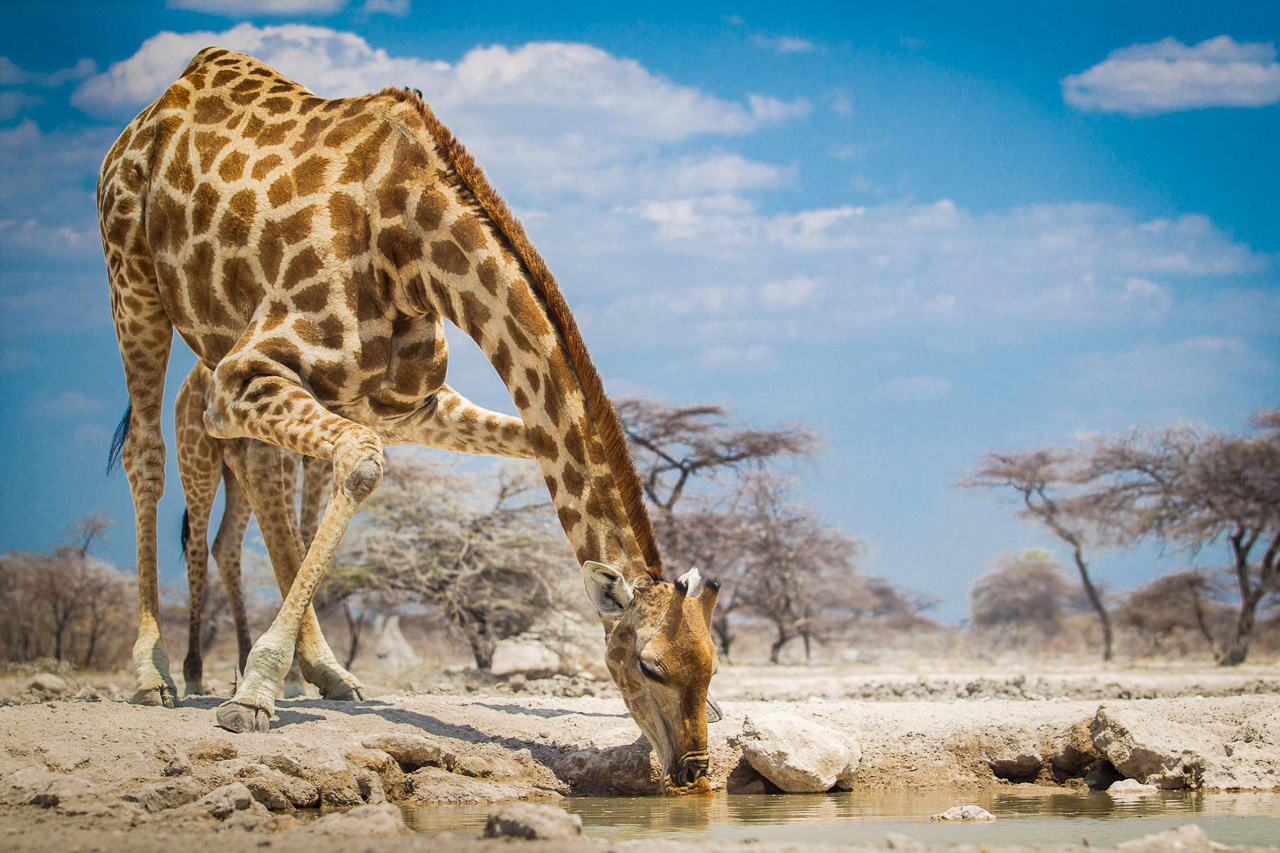
Accommodation Intimate and luxurious, Onguma Tented Camp offers uninterrupted views of a natural waterhole (lit at night) from anywhere in the camp. With a little luck, guests will encounter giraffe, jackal, antelope, zebra, wildebeest and maybe even a rare black rhino.
The main building houses a generously sized lounge, restaurant, wine cellar and swimming pool. The camp comprises just seven bright and spacious house tents, each with its own veranda, indoor and outdoor shower, elegant tin bathtub and separate WC. The light-coloured furnishings are designed to reflect the forms and colours of Etosha’s landscape.
The camp is unfenced, which means there is a minimum age requirement for our younger guests.
The Etosha National Park is one of the most important nature reserves in southern Africa. It exists since 1907 and covers an area of 22,270 km². The central and eastern sections consist mainly of various silvery-white shining salt pans, which have made Etosha famous. In the dry season the park, the animals and the vehicles are covered in a whitish haze of salt dust.
On the southern shore of the huge Etosha Pan (130 x 50 km) there are several waterholes, which magically attract the animals from the surrounding area during the dry season. The three large state camps Okaukuejo, Halali and Namutoni connect Anderson's Gate in the south with the von Lindequist Gate in the east. The western part towards Galton Gate is much more wooded and less frequented by visitors, but it also offers less trails to drive around and find wildlife.
Etosha National Park is Namibia's premier safari destination. Covering almost the same area as Switzerland, Etosha is one of the largest national parks in Africa. To the west of the park lay the silvery white salt pans and adjoining waterholes, which magically attract all kinds of wildlife during the dry season.

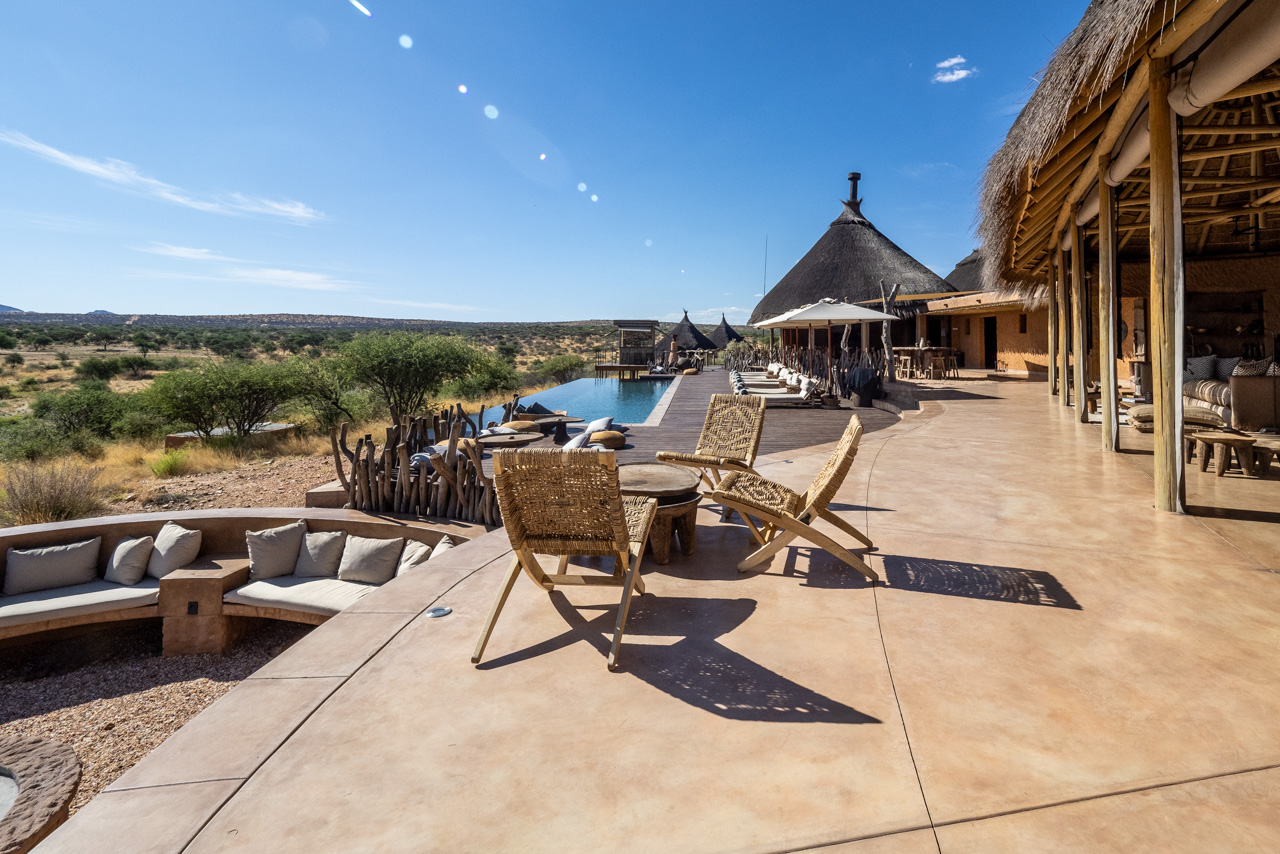
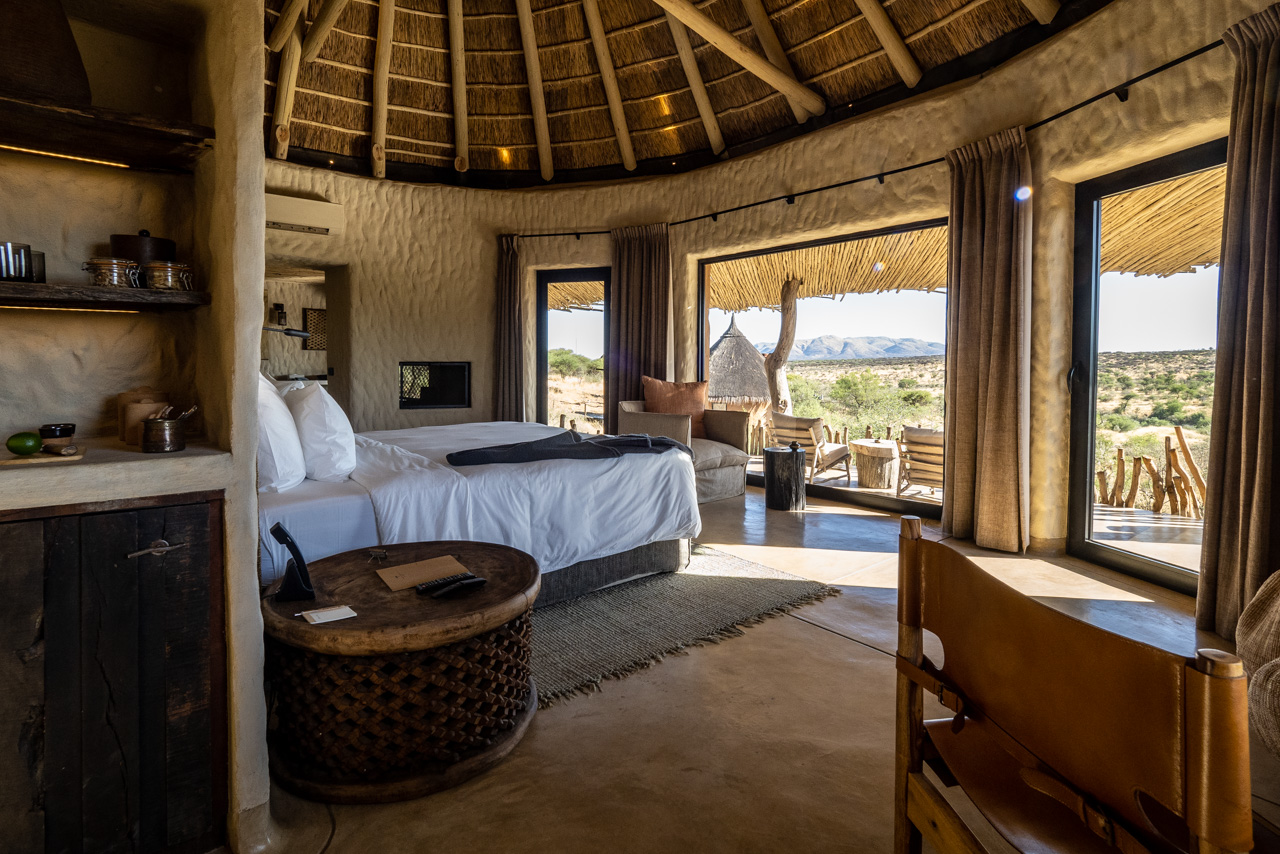
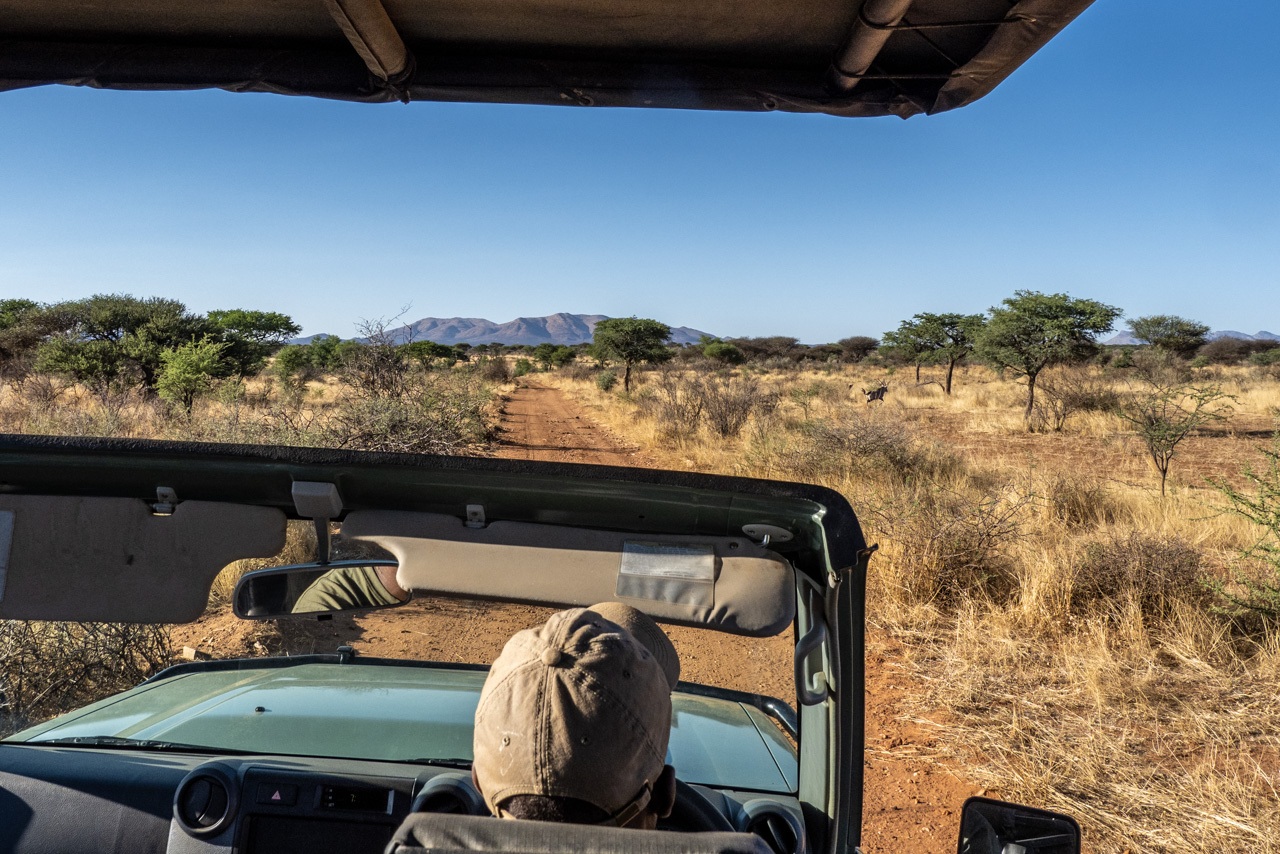
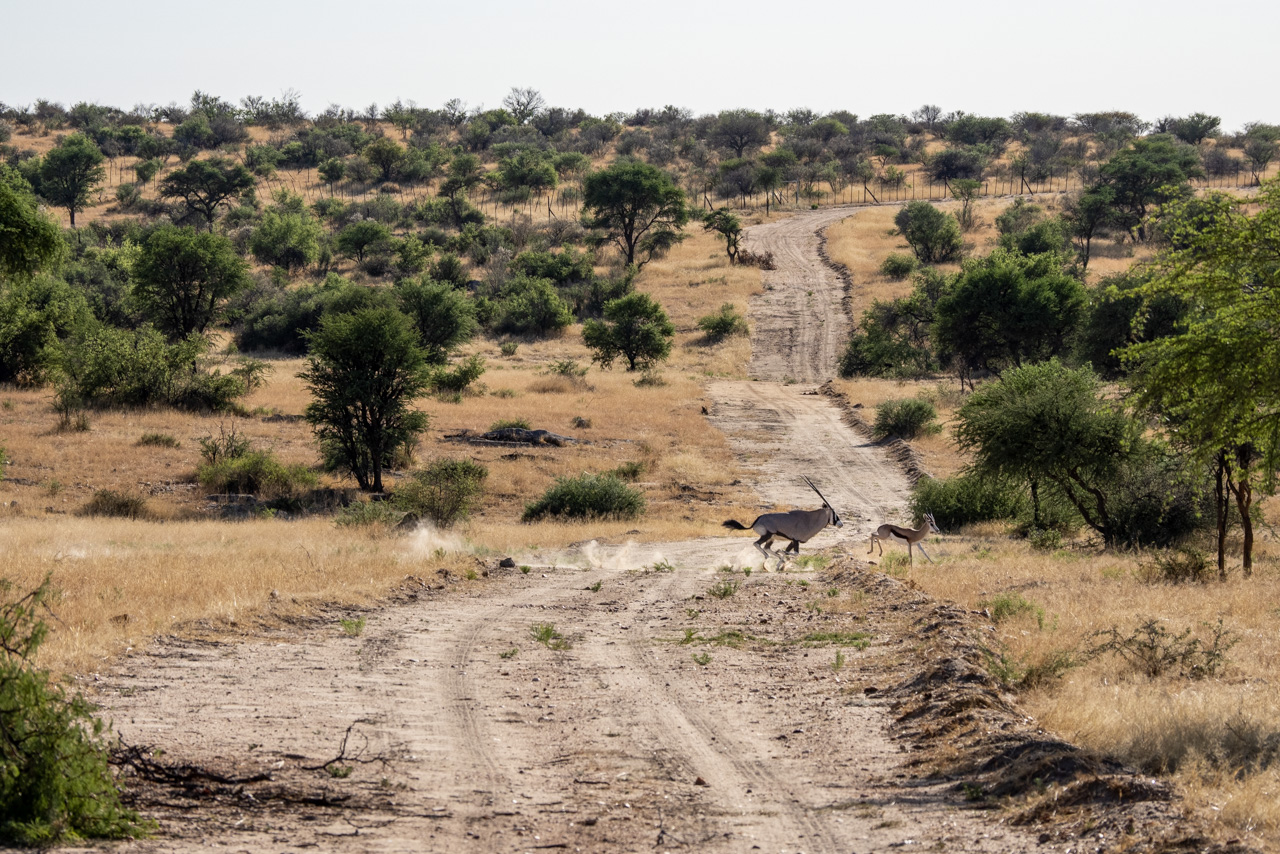
Accommodation
Zannier Omaanda is a very comfortable accommodation in close proximity to Windhoek International Airport. Although Omaanda is located in a private game reserve and also offers game drives, this accommodation should not be considered a safari lodge but a beautiful place to relax, for example after a long journey. Omaanda means «rhino» in the local Oshiwambo language.
The eight very luxurious rooms, whose design was inspired by the traditional Owambo architecture, are about 60m² in size, tastefully furnished and have large king-size beds, separate bathrooms with walk-in shower, Nespresso machine, music system and an outside deck for relaxing. The two additional family rooms are about 120m² in size and offer two separate en-suite bedrooms.
The main area features a cozy bar and restaurant, a spa with two double treatment rooms, a boutique and a heated infinity swimming pool overlooking the majestic savannah. The restaurant offered a selection of outstandingly delicious dishes when we visited.
Wifi is available in all rooms and in the main building.
Omaanda is part of the private 9,000 hectare Zannier Reserve by N/a‘an ku sê.

Basic Information
Individual journey. The journey will be planned on your preferred dates.
Duration 21 nights. Min 2 guests. Trip vice versa possible.
Includes all transfers from Windhoek to the hotels/camps to Windhoek
- Olive Grove: Luxury Room. Breakfast.
- Kwessi Dunes: Double Room. All meals, drinks (except premier brands), twice daily shared activities with one of the camp guides. Included guided excursion to the dunes of Sossusvlei and balloon flight.
- Strand Hotel: Luxury Room. Breakfast.
- Mowani Mountain Camp: Standard Room. Dinner, breakfast. Visit the rock engravings of Twyfelfontein on your own. Includes elephant activity to find the desert adapted elephants.
- Shipwreck Lodge: Double Room. All meals, drinks (except premier brands), laundry service, twice daily shared activities with one of the camp guides.
- Hoanib Valley Camp: Double Room. All meals, drinks (except premier brands), laundry service, twice daily shared activities with one of the camp guides.
- Etendeka Mountain Camp: Double Room. All meals, twice daily shared activities with one of the camp guides.
- Etosha Oberland Lodge: Double Room. Dinner, breakfast. Game Drives on your own or bookable at the lodge.
- Onguma Tented Camp: Double Room. All meals, drinks (except premier brands), laundry service, twice daily shared activities with one of the camp guides.
- Zannier Omaanda: Double Room. Dinner, breakfast, drinks during these meals (except premier brands).
Learn more about these areas














